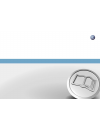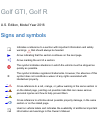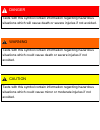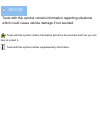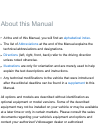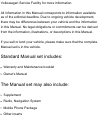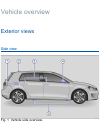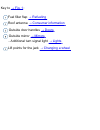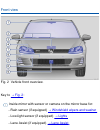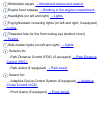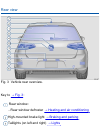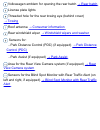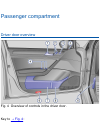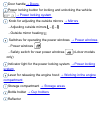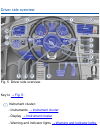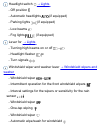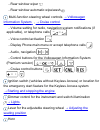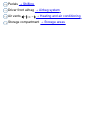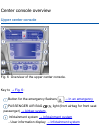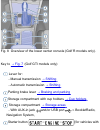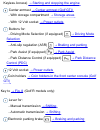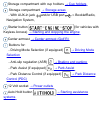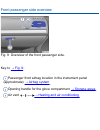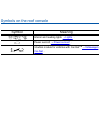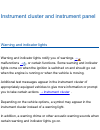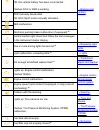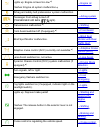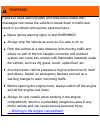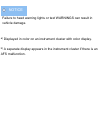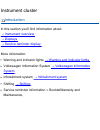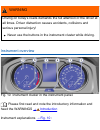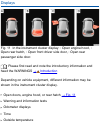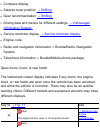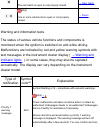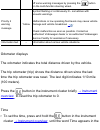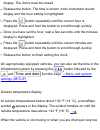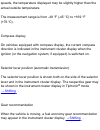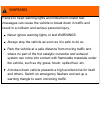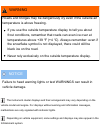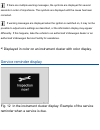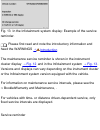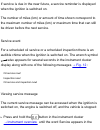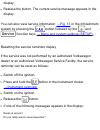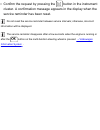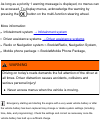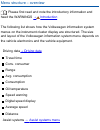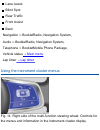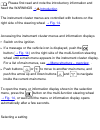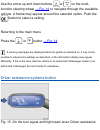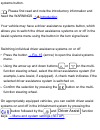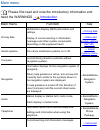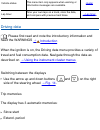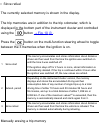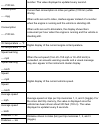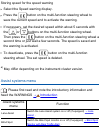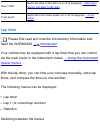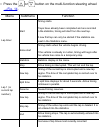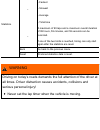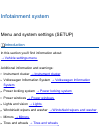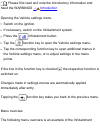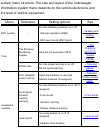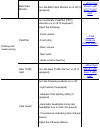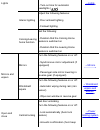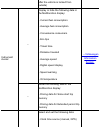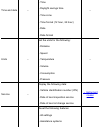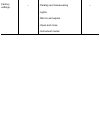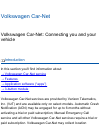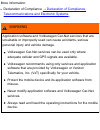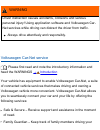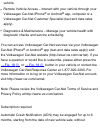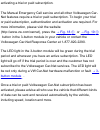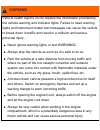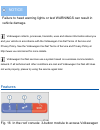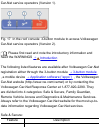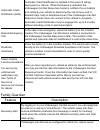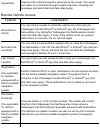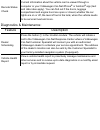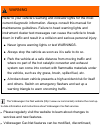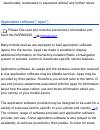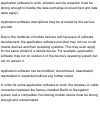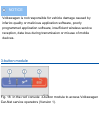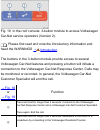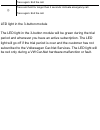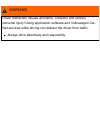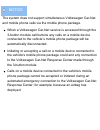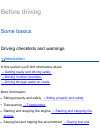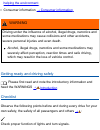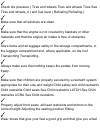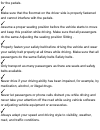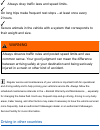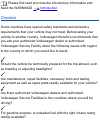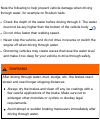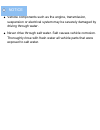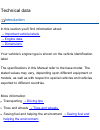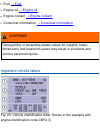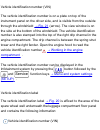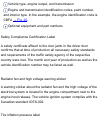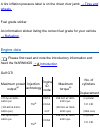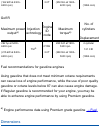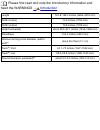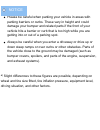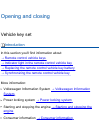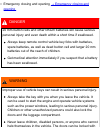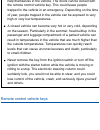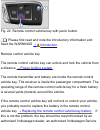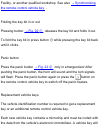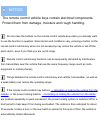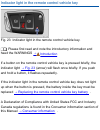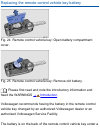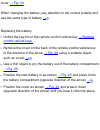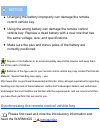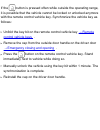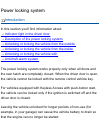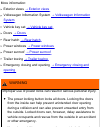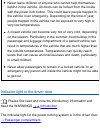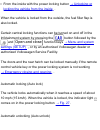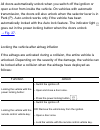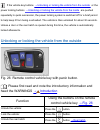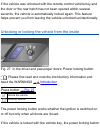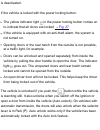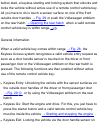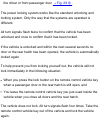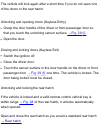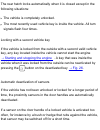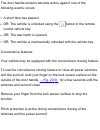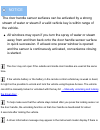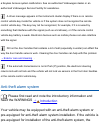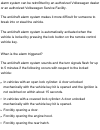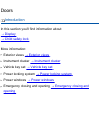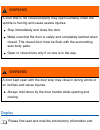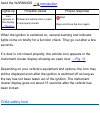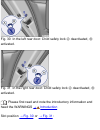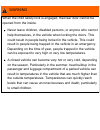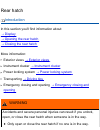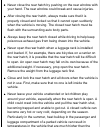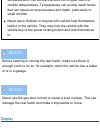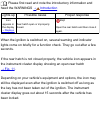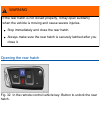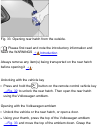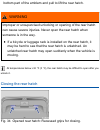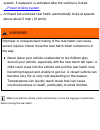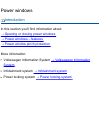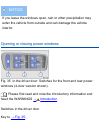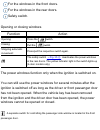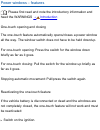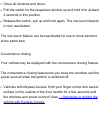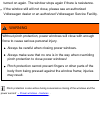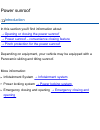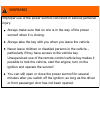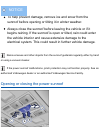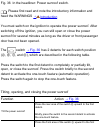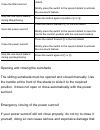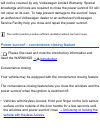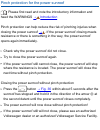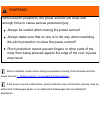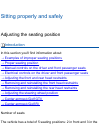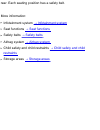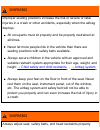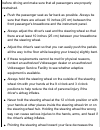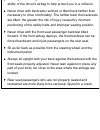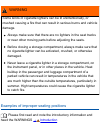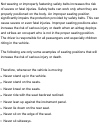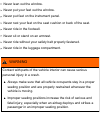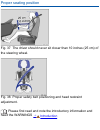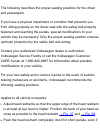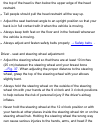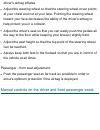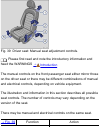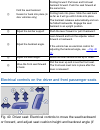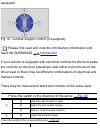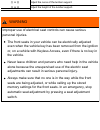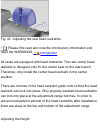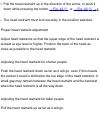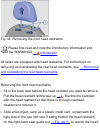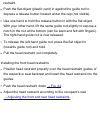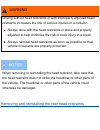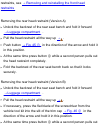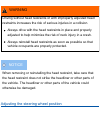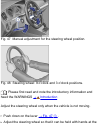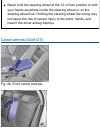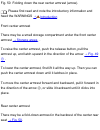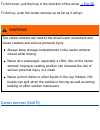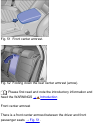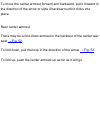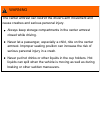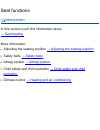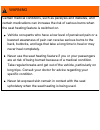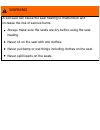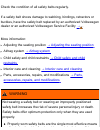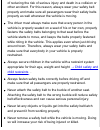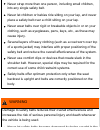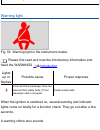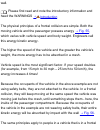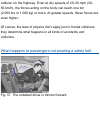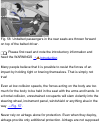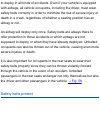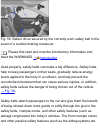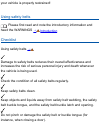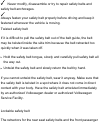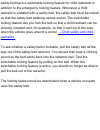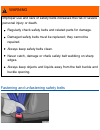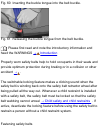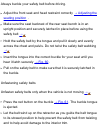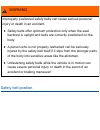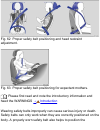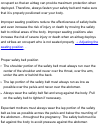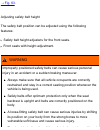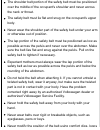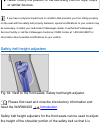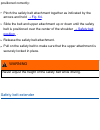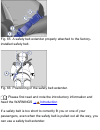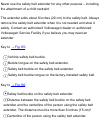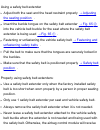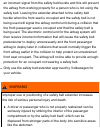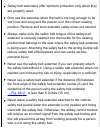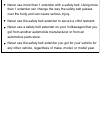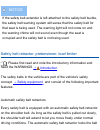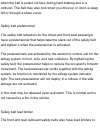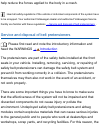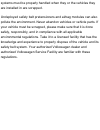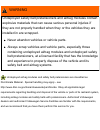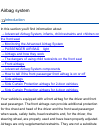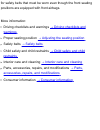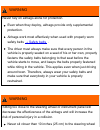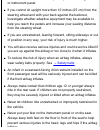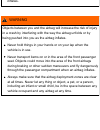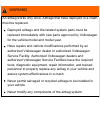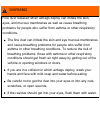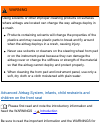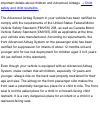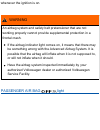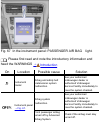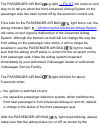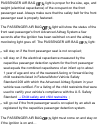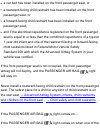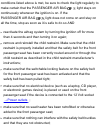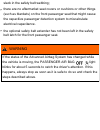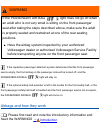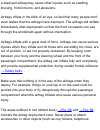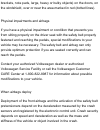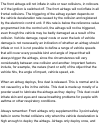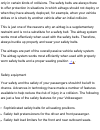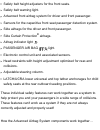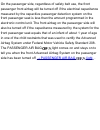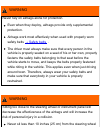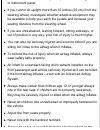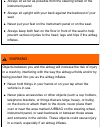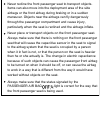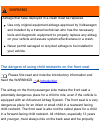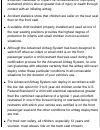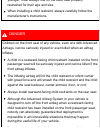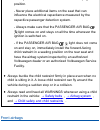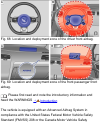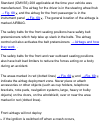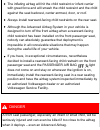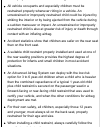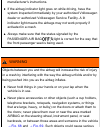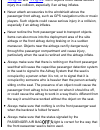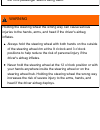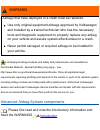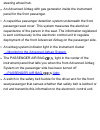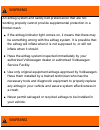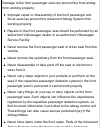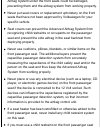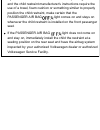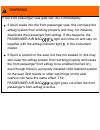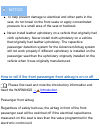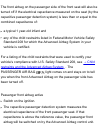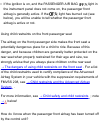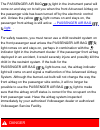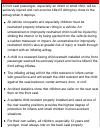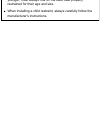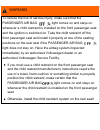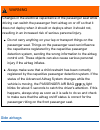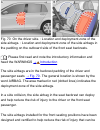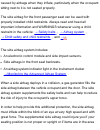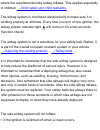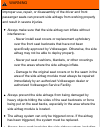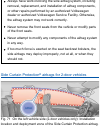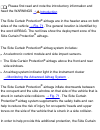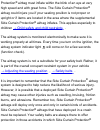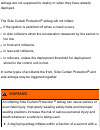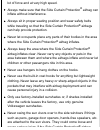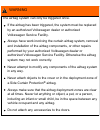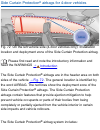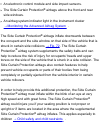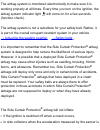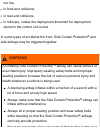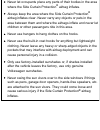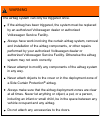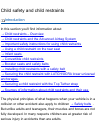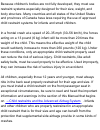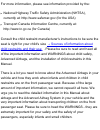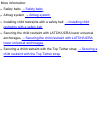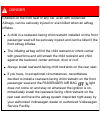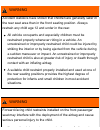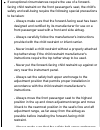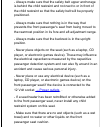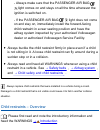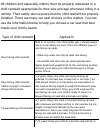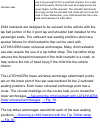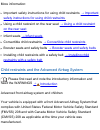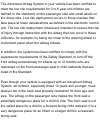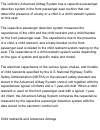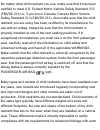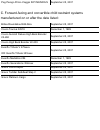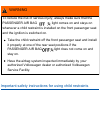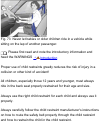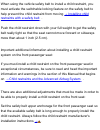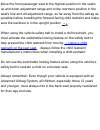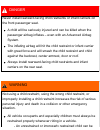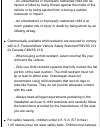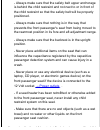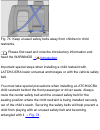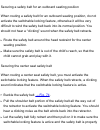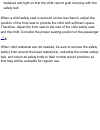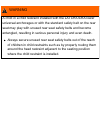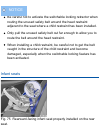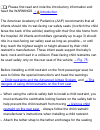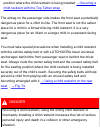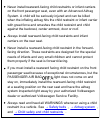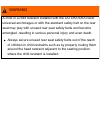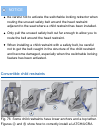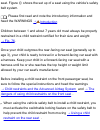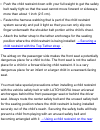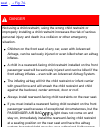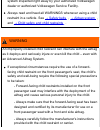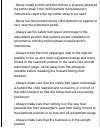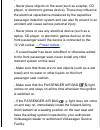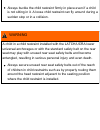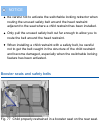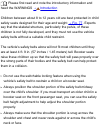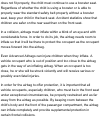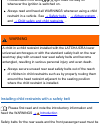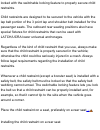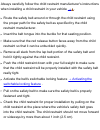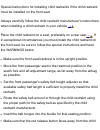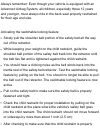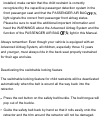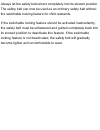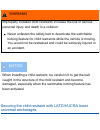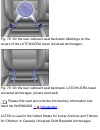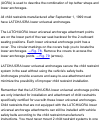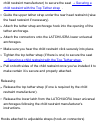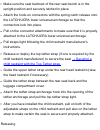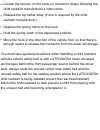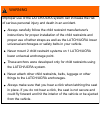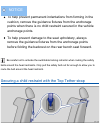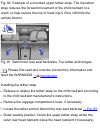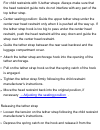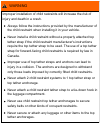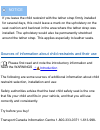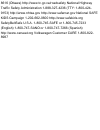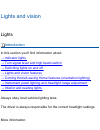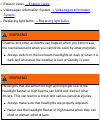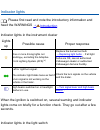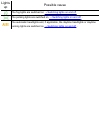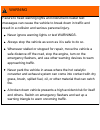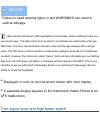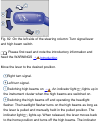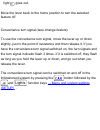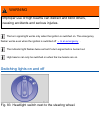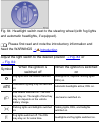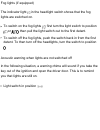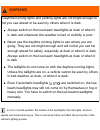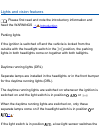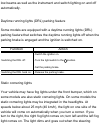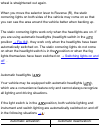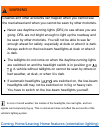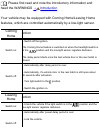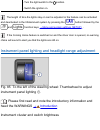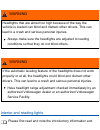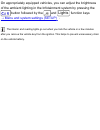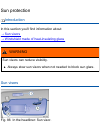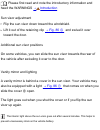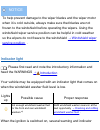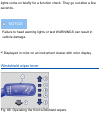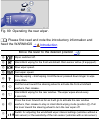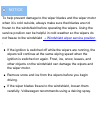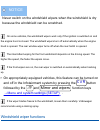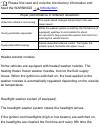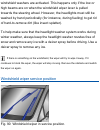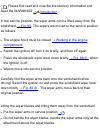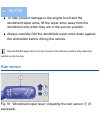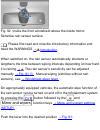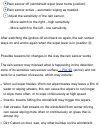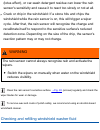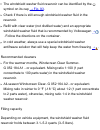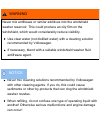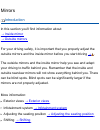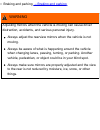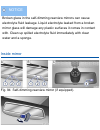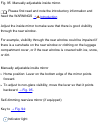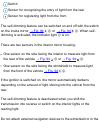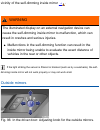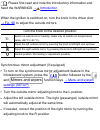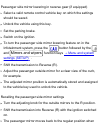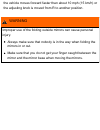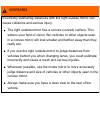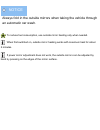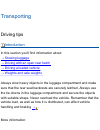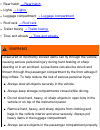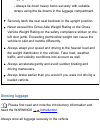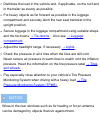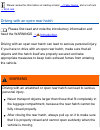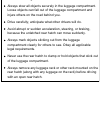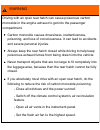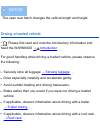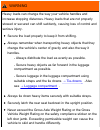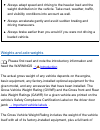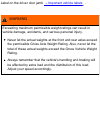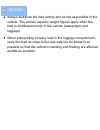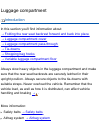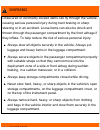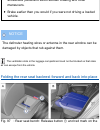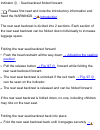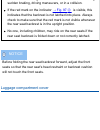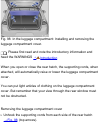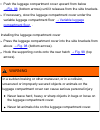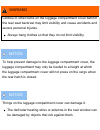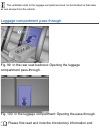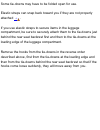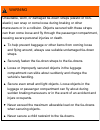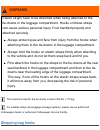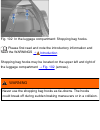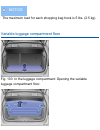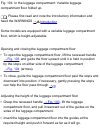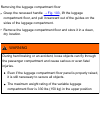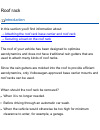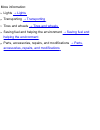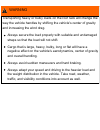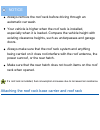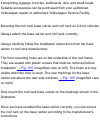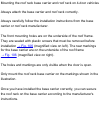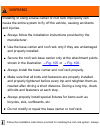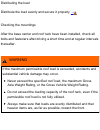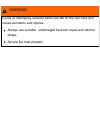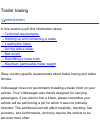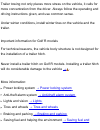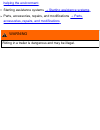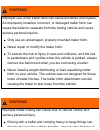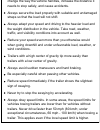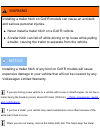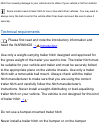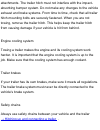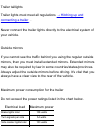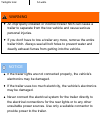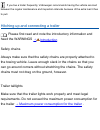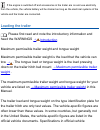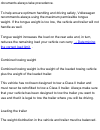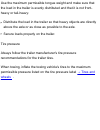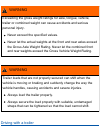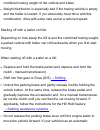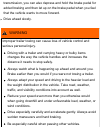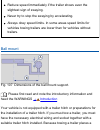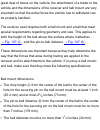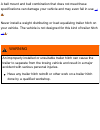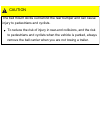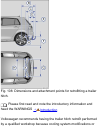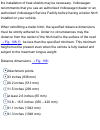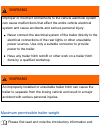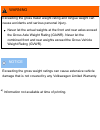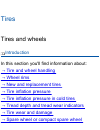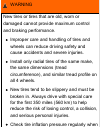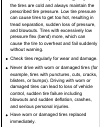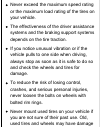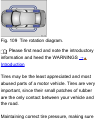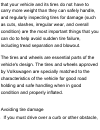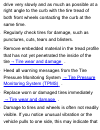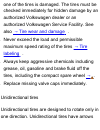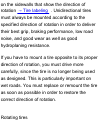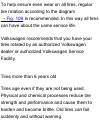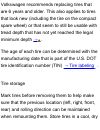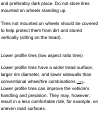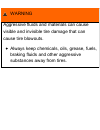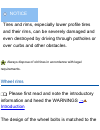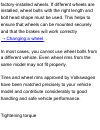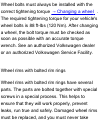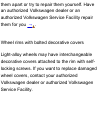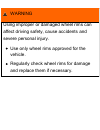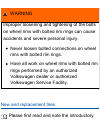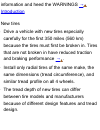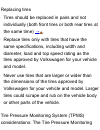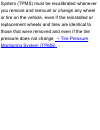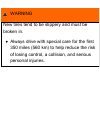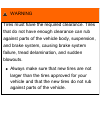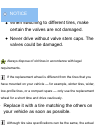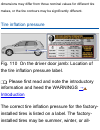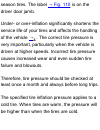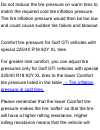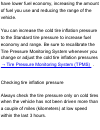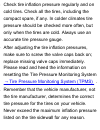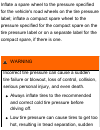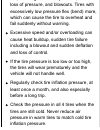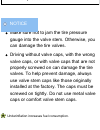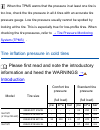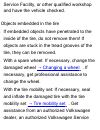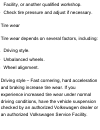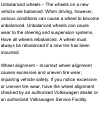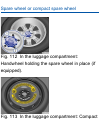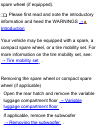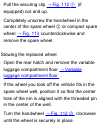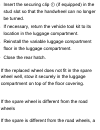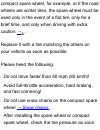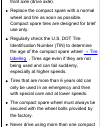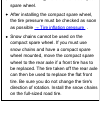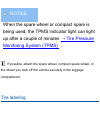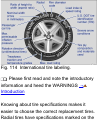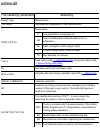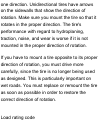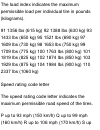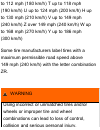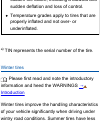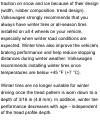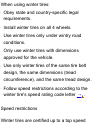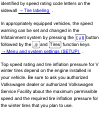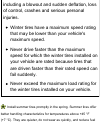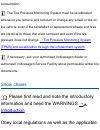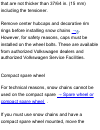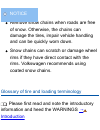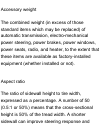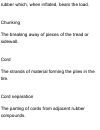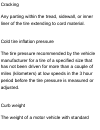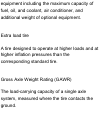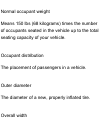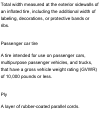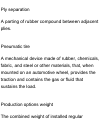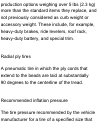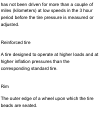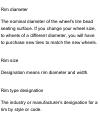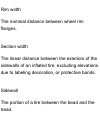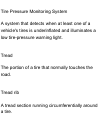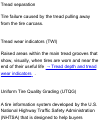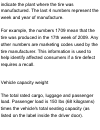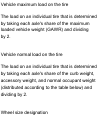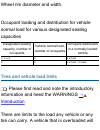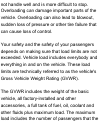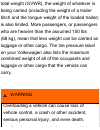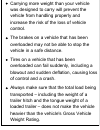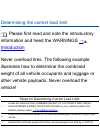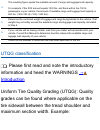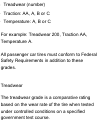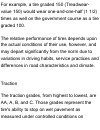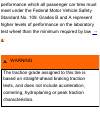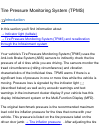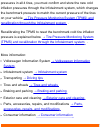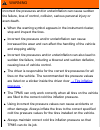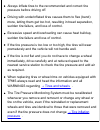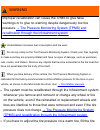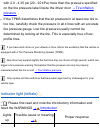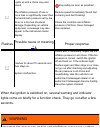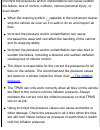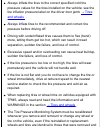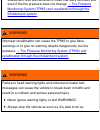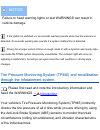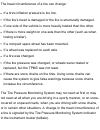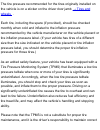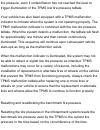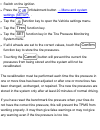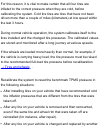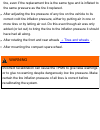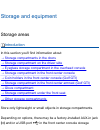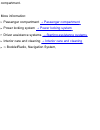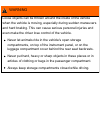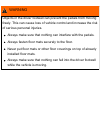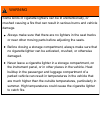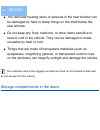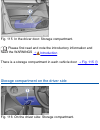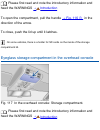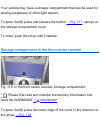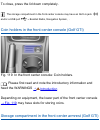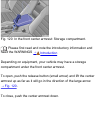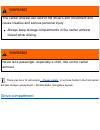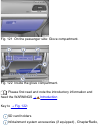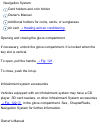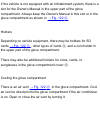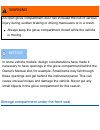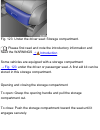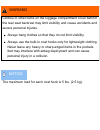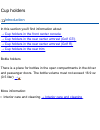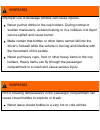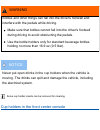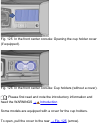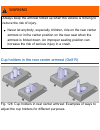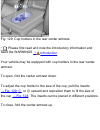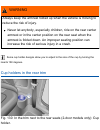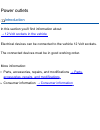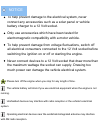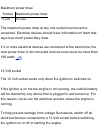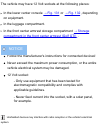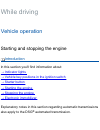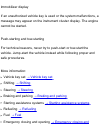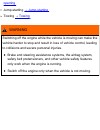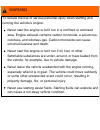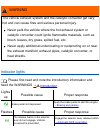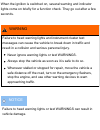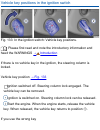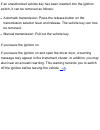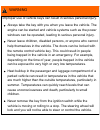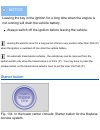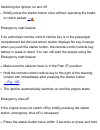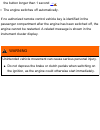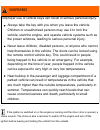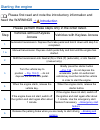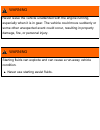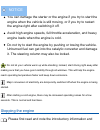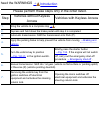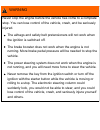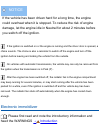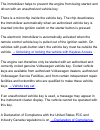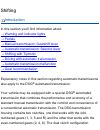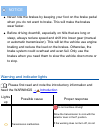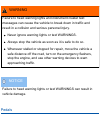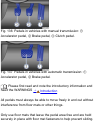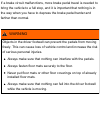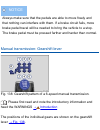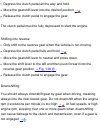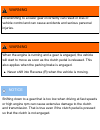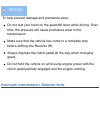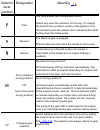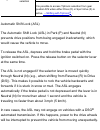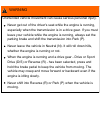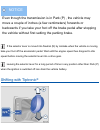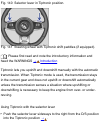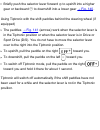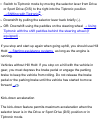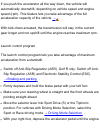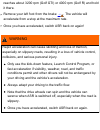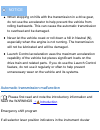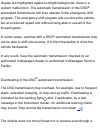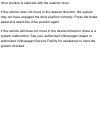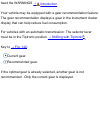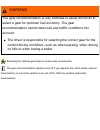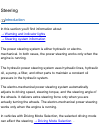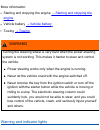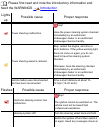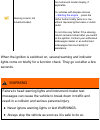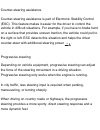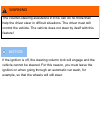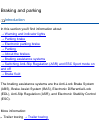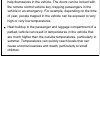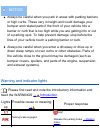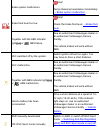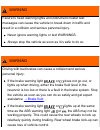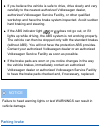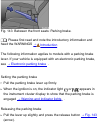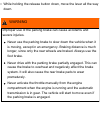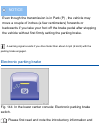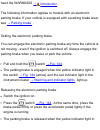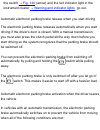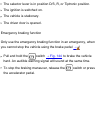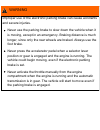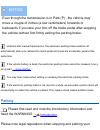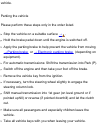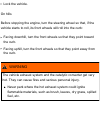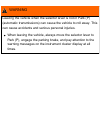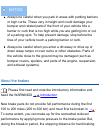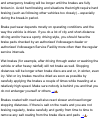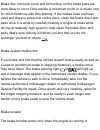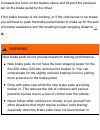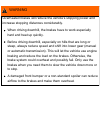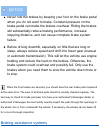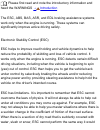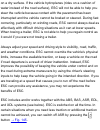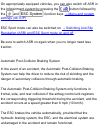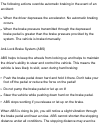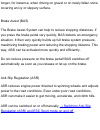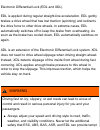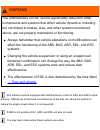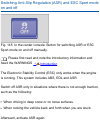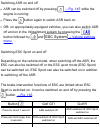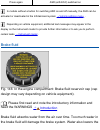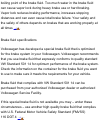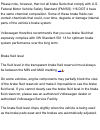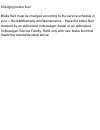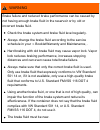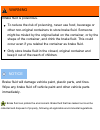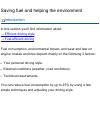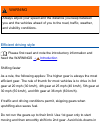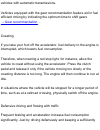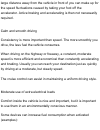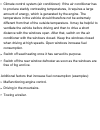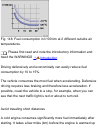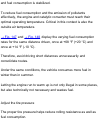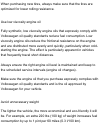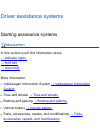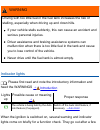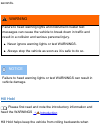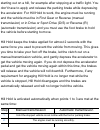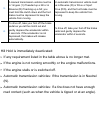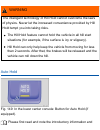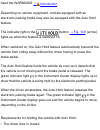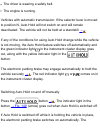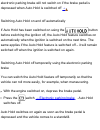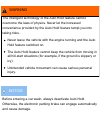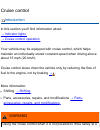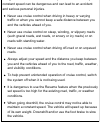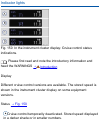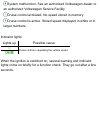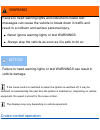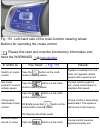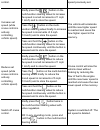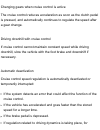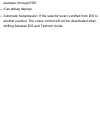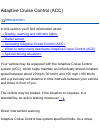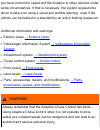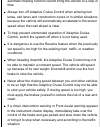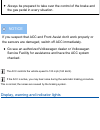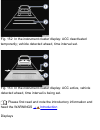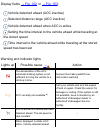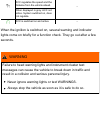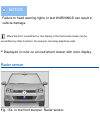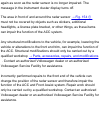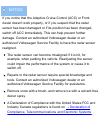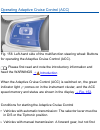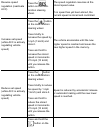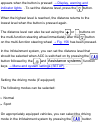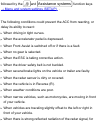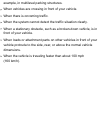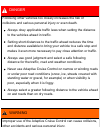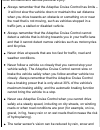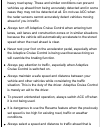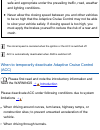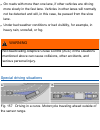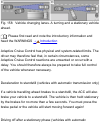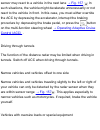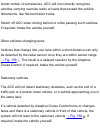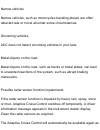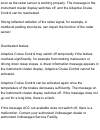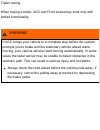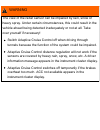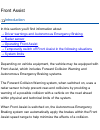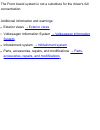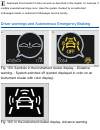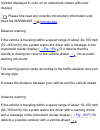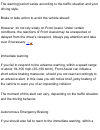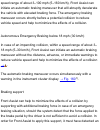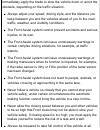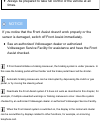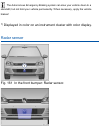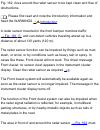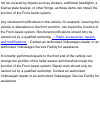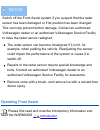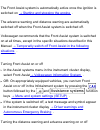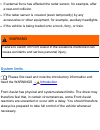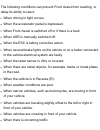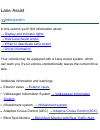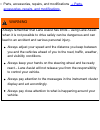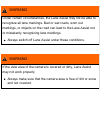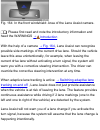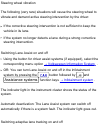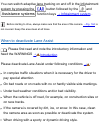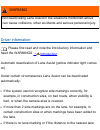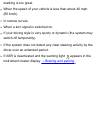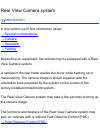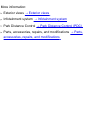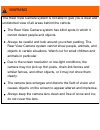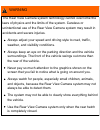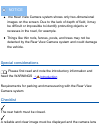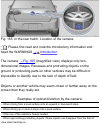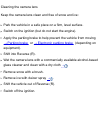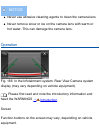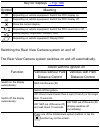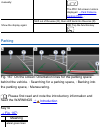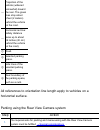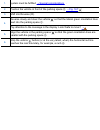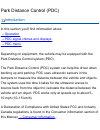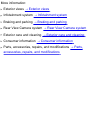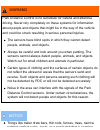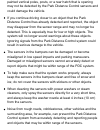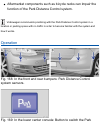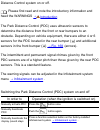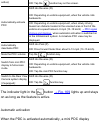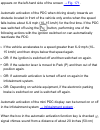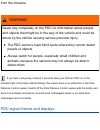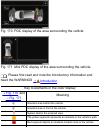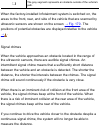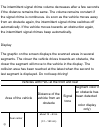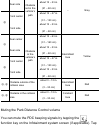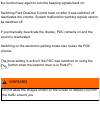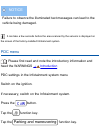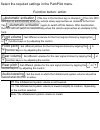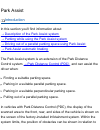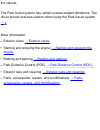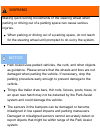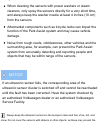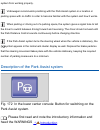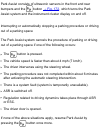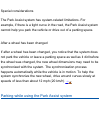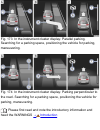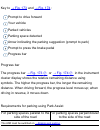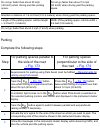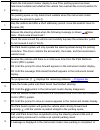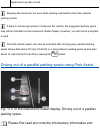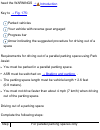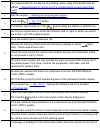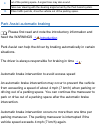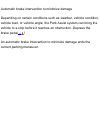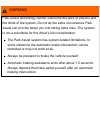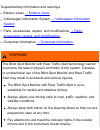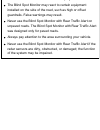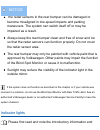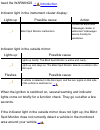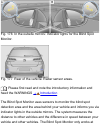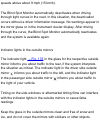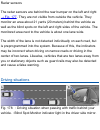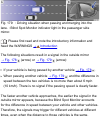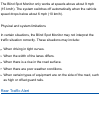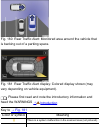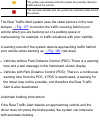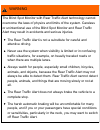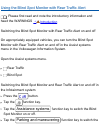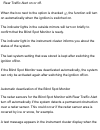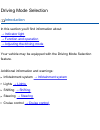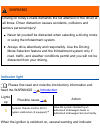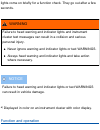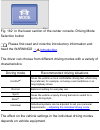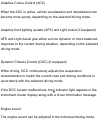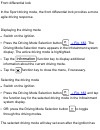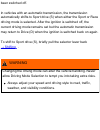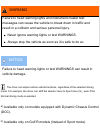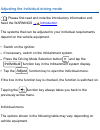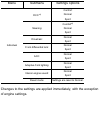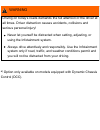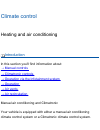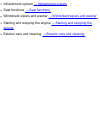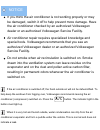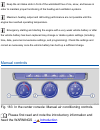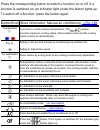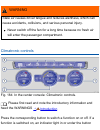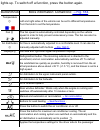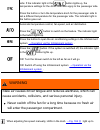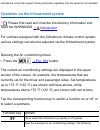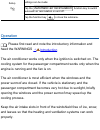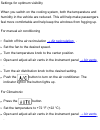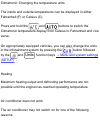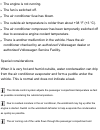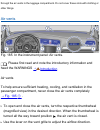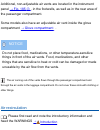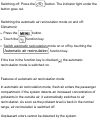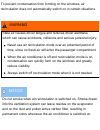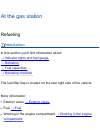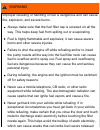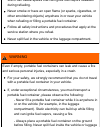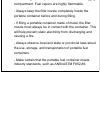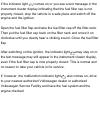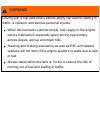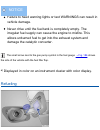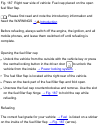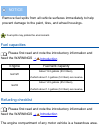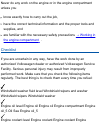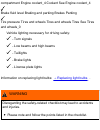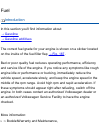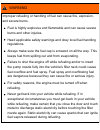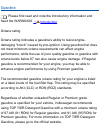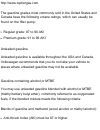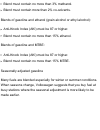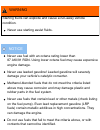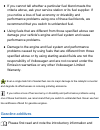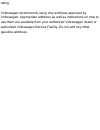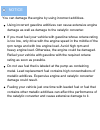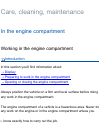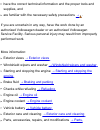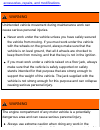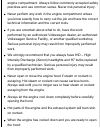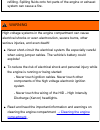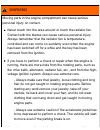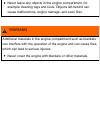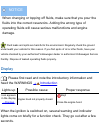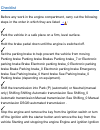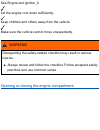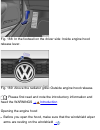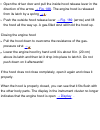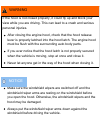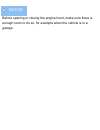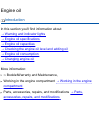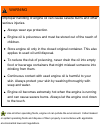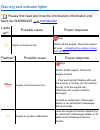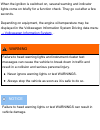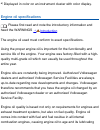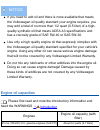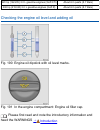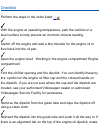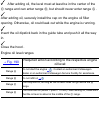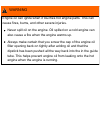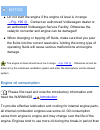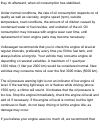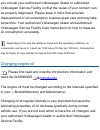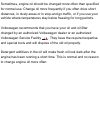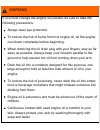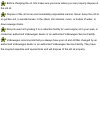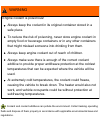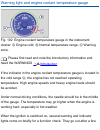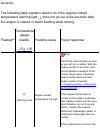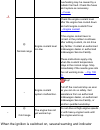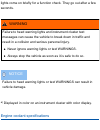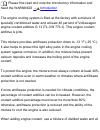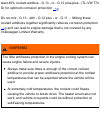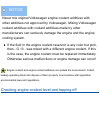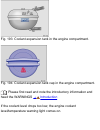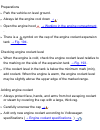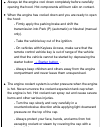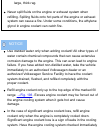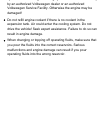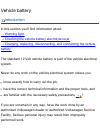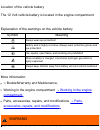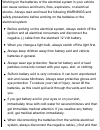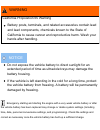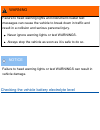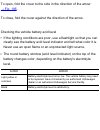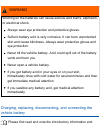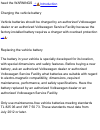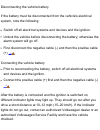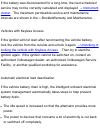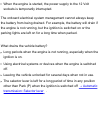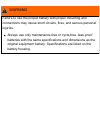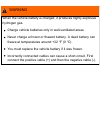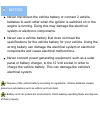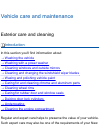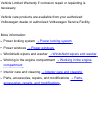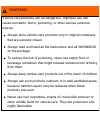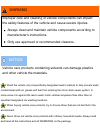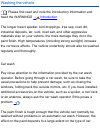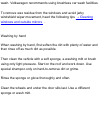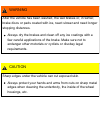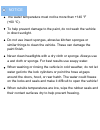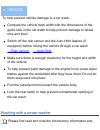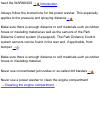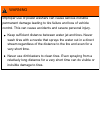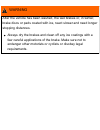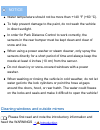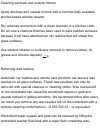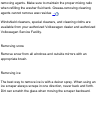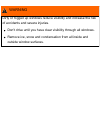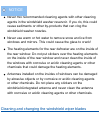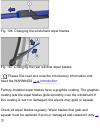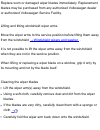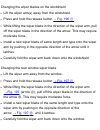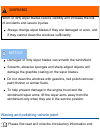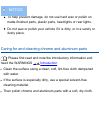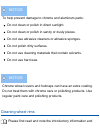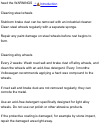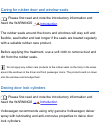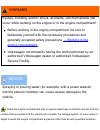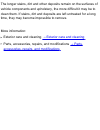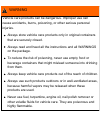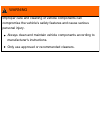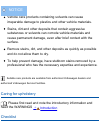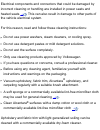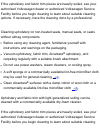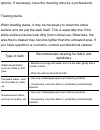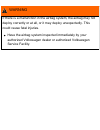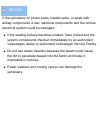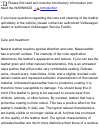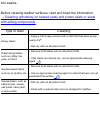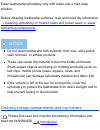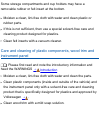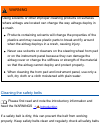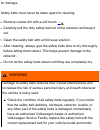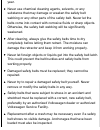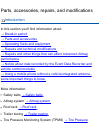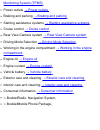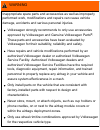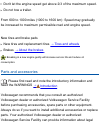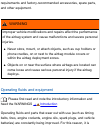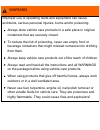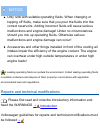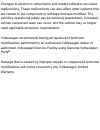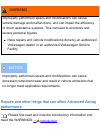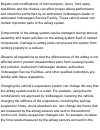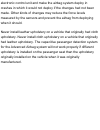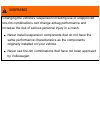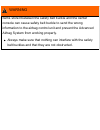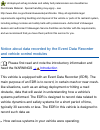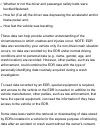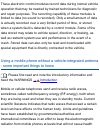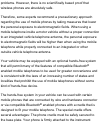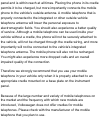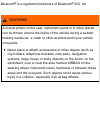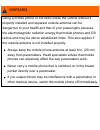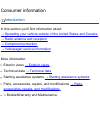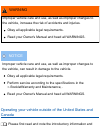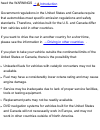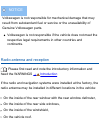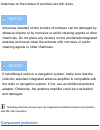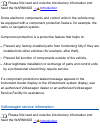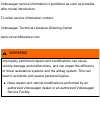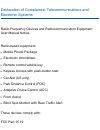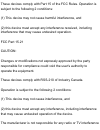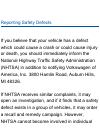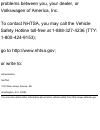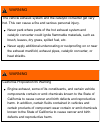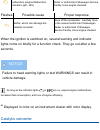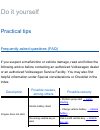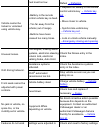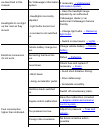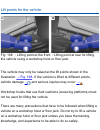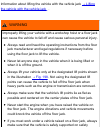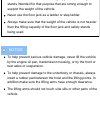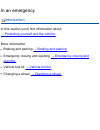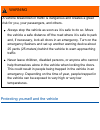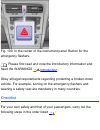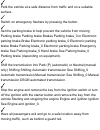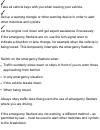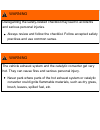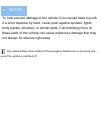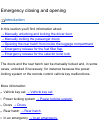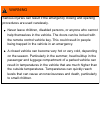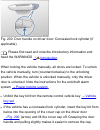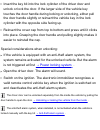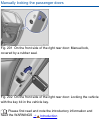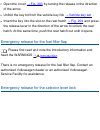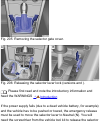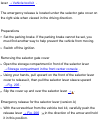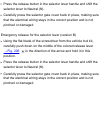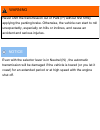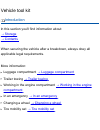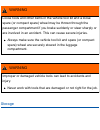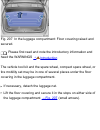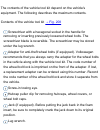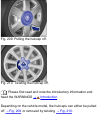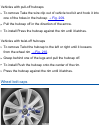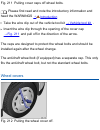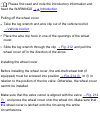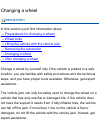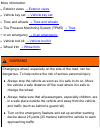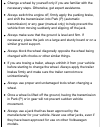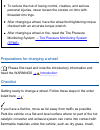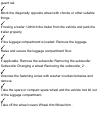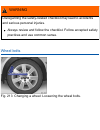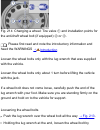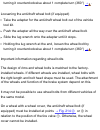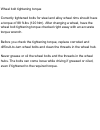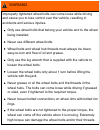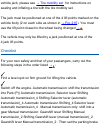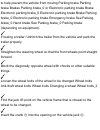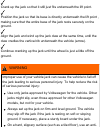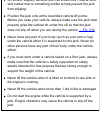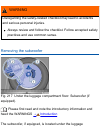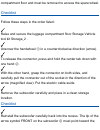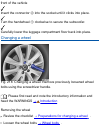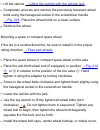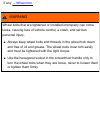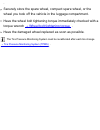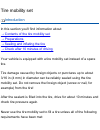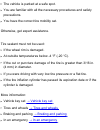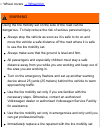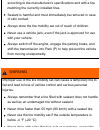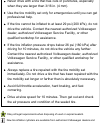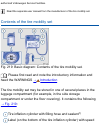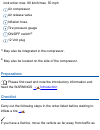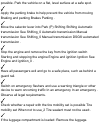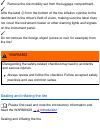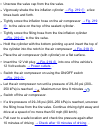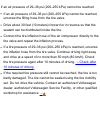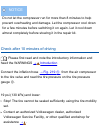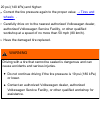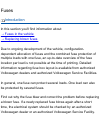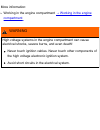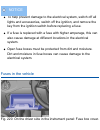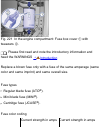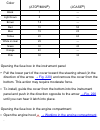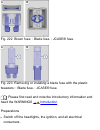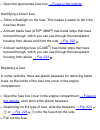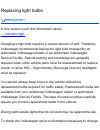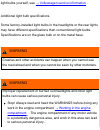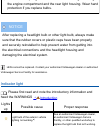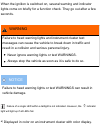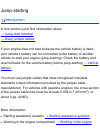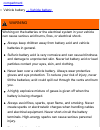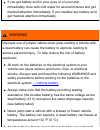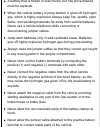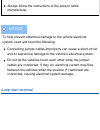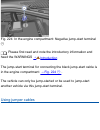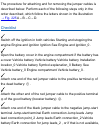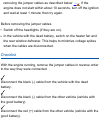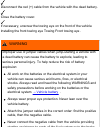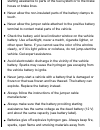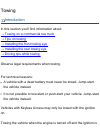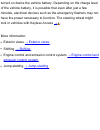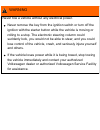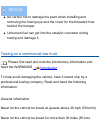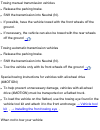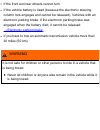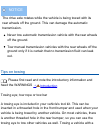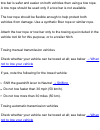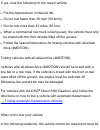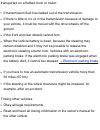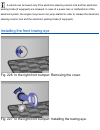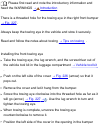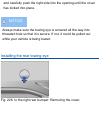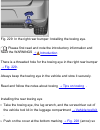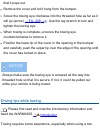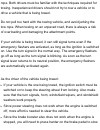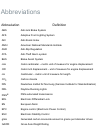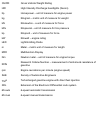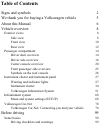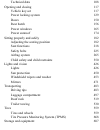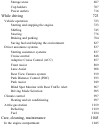- DL manuals
- Volkswagen
- Automobile
- Golf GTI 2016
- Owner's Manual
Volkswagen Golf GTI 2016 Owner's Manual
Summary of Golf GTI 2016
Page 2
Golf gti, golf r u.S. Edition, model year 2016 signs and symbols indicates a reference to a section with important information and safety warnings that should always be heeded. Arrow indicating that the section continues on the next page. Arrow marking the end of a section. The symbol indicates situ...
Page 3
Texts with this symbol contain information regarding hazardous situations which will cause death or severe injuries if not avoided. Danger texts with this symbol contain information regarding hazardous situations which could cause death or severe injuries if not avoided. Warning texts with this symb...
Page 4
Texts with this symbol contain information about the environment and how you can help to protect it. Texts with this symbol contain supplementary information. Texts with this symbol contain information regarding situations which could cause vehicle damage if not avoided. Notice.
Page 5
We thank you for buying a volkswagen vehicle this volkswagen vehicle provides advanced technology incorporating many convenience features for you to enjoy in your daily driving. Please carefully read and follow the information in this owner's manual. It will help you both to become more familiar wit...
Page 6
About this manual at the end of this manual, you will find an alphabetical index . The list of abbreviations at the end of the manual explains the technical abbreviations and designations. Directions (left, right, front, back) refer to the driving direction unless noted otherwise. Illustrations are ...
Page 7
Volkswagen service facility for more information. All information in this manual corresponds to information available as of the editorial deadline. Due to ongoing vehicle development, there may be differences between your vehicle and the information in this manual. No legal obligations or commitment...
Page 8
Vehicle overview exterior views side view fig. 1 vehicle side overview..
Page 9
Key to → fig. 1 : fuel filler flap → refueling roof antenna → consumer information outside door handles → doors outside mirror → mirrors - additional turn signal light → lights lift points for the jack → changing a wheel.
Page 10
Front view fig. 2 vehicle front overview. Key to → fig. 2 : inside mirror with sensor or camera on the mirror base for: - rain sensor (if equipped) → windshield wipers and washer - low-light sensor (if equipped) → lights - lane assist (if equipped) → lane assist.
Page 11
Windshield wipers → windshield wipers and washer engine hood release → working in the engine compartment headlights (on left and right) → lights fog lights/static cornering lights (on left and right, if equipped) → lights threaded hole for the front towing eye (behind cover) → towing side marker lig...
Page 12
Rear view fig. 3 vehicle rear overview. Key to → fig. 3 : rear window: - rear window defroster → heating and air conditioning high-mounted brake light → braking and parking taillights (on left and right) → lights.
Page 13
Volkswagen emblem for opening the rear hatch → rear hatch license plate lights threaded hole for the rear towing eye (behind cover) → towing roof antenna → consumer information rear windshield wiper → windshield wipers and washer sensors for: - park distance control (pdc) (if equipped) → park distan...
Page 14
Passenger compartment driver door overview fig. 4 overview of controls in the driver door. Key to → fig. 4 :.
Page 15
Door handle → doors power locking button for locking and unlocking the vehicle – → power locking system knob for adjusting the outside mirrors → mirrors - adjusting outside mirrors – – - outside mirror heating switches for operating the power windows → power windows - power windows - safety switch f...
Page 16
Driver side overview fig. 5 driver side overview. Key to → fig. 5 : instrument cluster: - instruments → instrument cluster - display → instrument cluster - warning and indicator lights → warning and indicator lights.
Page 17
Headlight switch → lights - off position - automatic headlights (if equipped) - parking lights (if equipped) - low beams - fog lights (if equipped) lever for → lights - turning high beams on or off – - headlight flasher x - turn signals windshield wiper and washer lever → windshield wipers and washe...
Page 18
- rear window wiper - rear window automatic wipe/wash multi-function steering wheel controls → volkswagen information system , → cruise control - volume setting for radio, navigation system notifications (if applicable), or telephone calls – - voice control activation - display phone main menu or ac...
Page 19
Pedals → shifting driver front airbag → airbag system air vents – – → heating and air conditioning storage compartment → storage areas.
Page 20
Center console overview upper center console fig. 6 overview of the upper center console. Key to → fig. 6 : button for the emergency flashers → in an emergency passenger air bag light (front airbag for front seat passenger) → airbag system infotainment system → infotainment system - user information...
Page 21
- radio ⇒ bookletradio, navigation system, - navigation system ⇒ bookletradio, navigation system, controls for: - manual air conditioning → heating and air conditioning - climatronic → heating and air conditioning air vents – – → heating and air conditioning passenger seat heating button → seat func...
Page 22
Fig. 8 overview of the lower center console (golf r models only). Key to → fig. 7 (golf gti models only): lever for: - manual transmission → shifting - automatic transmission → shifting parking brake lever → braking and parking storage compartment with cup holders → cup holders storage compartment →...
Page 23
Keyless access) → starting and stopping the engine center armrest → center armrest (golf gti) - with storage compartment → storage areas - with 12 volt socket → power outlets buttons for: - driving mode selection (if equipped) → driving mode selection - anti-slip regulation (asr) → braking and parki...
Page 24
Storage compartment with cup holders → cup holders storage compartment → storage areas - with aux-in jack and/or usb port ⇒ bookletradio, navigation system, starter button – – (for vehicles with keyless access) → starting and stopping the engine center armrest → center armrest (golf r) buttons for: ...
Page 25
Front passenger side overview fig. 9 overview of the front passenger side. Key to → fig. 9 : passenger front airbag location in the instrument panel (approximate) → airbag system opening handle for the glove compartment → storage areas air vent – – → heating and air conditioning.
Page 26
Symbols on the roof console symbol meaning interior and reading lights → lights . Power sunroof → power sunroof . 3-button module for vehicles with car-net tm → volkswagen car-net ..
Page 27
Instrument cluster and instrument panel warning and indicator lights warning and indicator lights notify you of warnings → , malfunctions → , or certain functions. Some warning and indicator lights come on when the ignition is switched on and should go out when the engine is running or when the vehi...
Page 28
Symbol meaning → , → refer to central warning light: read and follow the text messages in the instrument cluster display. – stop! Parking brake engaged. → braking and parking stop! Brake fluid level too low or brake system malfunction. Stop! Engine coolant level too low, engine coolant temperature t...
Page 29
Or: the vehicle battery has been reconnected. → braking and parking flashes: esc or asr is working. Asr manually deactivated. Or: esc sport mode manually activated. Abs malfunction. Electronic parking brake malfunction (if equipped). A) central caution light: read and follow the text messages in the...
Page 30
Lights up: engine oil level too low. A) → engine oil flashes: engine oil system malfunction. A) airbag and safety belt pretensioner system malfunction. → airbag system passenger front airbag turned off (passenger air bag light). Transmission malfunction. A) → shifting front assist switched off (if e...
Page 31
→ cruise control → adaptive cruise control (acc) or: adaptive cruise control (acc) switched on. Lane assist is switched on and active. → lane assist the vehicle is being held by the auto hold feature (if equipped). → starting assistance systems high beams switched on or headlight flashers in use. → ...
Page 32
Failure to heed warning lights and instrument cluster text messages can cause the vehicle to break down in traffic and result in a collision and serious personal injury. Never ignore warning lights or text warnings. Always stop the vehicle as soon as it is safe to do so. Park the vehicle at a safe d...
Page 33
A) displayed in color on an instrument cluster with color display. B) a separate display appears in the instrument cluster if there is an afs malfunction. Failure to heed warning lights or text warnings can result in vehicle damage. Notice.
Page 34
Instrument cluster introduction in this section you'll find information about: → instrument overview → displays → service reminder display more information: warning and indicator lights → warning and indicator lights volkswagen information system → volkswagen information system infotainment system →...
Page 35
Instrument overview fig. 10 instrument cluster in the instrument panel. Please first read and note the introductory information and heed the warnings → introduction instrument explanations → fig. 10 : driving on today's roads demands the full attention of the driver at all times. Driver distraction ...
Page 36
Speedometer. Tachometer (shows engine revolutions per minute in thousands when the engine is running). The red zone at the end of the scale indicates maximum permissible engine rpm (revolutions per minute) for all gears after the break-in period. Before reaching the red zone, select the next higher ...
Page 37
Displays fig. 11 in the instrument cluster display: : open engine hood, : open rear hatch, : open front driver side door, : open rear passenger side door. Please first read and note the introductory information and heed the warnings → introduction depending on vehicle equipment, different informatio...
Page 38
Compass display selector lever position → shifting gear recommendation → shifting driving data and menus for different settings → volkswagen information system service reminder display → service reminder display engine code radio and navigation information ⇒ bookletradio, navigation system, telephon...
Page 39
The rear hatch is open or not properly closed. → rear hatch , stop! One or more vehicle doors open or not properly closed. → doors warning and information texts the status of various vehicle functions and components is monitored when the ignition is switched on and while driving. Malfunctions are in...
Page 40
Off some warning messages by pressing the button on the multi-function steering wheel. Priority 2 warning message yellow symbol flashing or continuously lit – sometimes with acoustic warnings. Malfunctions or low operating fluid levels may cause vehicle damage and vehicle breakdown → . Check malfunc...
Page 41
Display. The doors must be closed. Release the button. The time is shown in the instrument cluster display and the hour setting is highlighted. Press the button repeatedly until the correct hour is displayed. Press and hold the button to scroll through quickly. Once you have set the hour, wait a few...
Page 42
Speeds, the temperature displayed may be slightly higher than the actual outside temperature. The measurement range is from -49 °f (-45 °c) to +169 °f (+76 ℃). Compass display on vehicles equipped with compass display, the current compass direction is indicated in the instrument cluster display when...
Page 43
Speed warning a display in the instrument cluster indicates when the set maximum speed has been exceeded → volkswagen information system . On appropriately equipped vehicles, the speed warning can also be set and changed in the infotainment system by pressing the button followed by the and tires fun...
Page 44
Failure to heed warning lights and instrument cluster text messages can cause the vehicle to break down in traffic and result in a collision and serious personal injury. Never ignore warning lights or text warnings. Always stop the vehicle as soon as it is safe to do so. Park the vehicle at a safe d...
Page 45
The instrument cluster displays and their arrangement may vary depending on the vehicle model and engine. For displays without warning and information messages, malfunctions are only signaled with indicator lights. Depending on vehicle equipment, some settings and displays may also appear in the inf...
Page 46
If there are multiple warning messages, the symbols are displayed for several seconds in order of importance. The symbols are displayed until the cause has been corrected. If warning messages are displayed when the ignition is switched on, it may not be possible to adjust some settings as described,...
Page 47
Fig. 13 in the infotainment system display: example of the service reminder. Please first read and note the introductory information and heed the warnings → introduction the maintenance service reminder is shown in the instrument cluster display → fig. 12 and in the infotainment system → fig. 13 . V...
Page 48
If service is due in the near future, a service reminder is displayed when the ignition is switched on. The number of miles (km) or amount of time shown correspond to the maximum number of miles (km) or maximum time that can still be driven before the next service. Service event for a scheduled oil ...
Page 49
Display. Release the button. The current service message appears in the display. You can also view service information → fig. 13 in the infotainment system by pressing the button followed by the and service function keys → menu and system settings (setup) . Resetting the service reminder display if ...
Page 50
Confirm the request by pressing the button in the instrument cluster. A confirmation message appears in the display when the service reminder has been reset. Do not reset the service reminder between service intervals; otherwise, incorrect information will be displayed. The service reminder disappea...
Page 51
Volkswagen information system introduction in this section you'll find information about: → menu structure – overview → using the instrument cluster menus → driver assistance systems button → main menu → driving data → menu → lap timer when the ignition is switched on, you can display different type...
Page 52
As long as a priority 1 warning message is displayed, no menus can be accessed. To display menus, acknowledge the warning by pressing the button on the multi-function steering wheel. More information: infotainment system → infotainment system driver assistance systems → driver assistance systems rad...
Page 53
Menu structure – overview please first read and note the introductory information and heed the warnings → introduction the following list shows how the volkswagen information system menus on the instrument cluster display are structured. The size and layout of the volkswagen information system menu ...
Page 54
Lane assist blind spot rear traffic front assist back navigation ⇒ bookletradio, navigation system, audio ⇒ bookletradio, navigation system, telephone ⇒ bookletmobile phone package, vehicle status → main menu lap timer → lap timer using the instrument cluster menus fig. 14 right side of the multi-fu...
Page 55
Please first read and note the introductory information and heed the warnings → introduction the instrument cluster menus are controlled with buttons on the right side of the steering wheel → fig. 14 . Accessing the instrument cluster menus and information displays switch on the ignition. If a messa...
Page 56
Use the arrow up and down buttons or on the multi- function steering wheel → fig. 14 to navigate through the available options. A frame may appear around the selected option. Push the button to select a setting. Returning to the main menu press the or button → fig. 14 . If warning messages are displ...
Page 57
Systems button. Please first read and note the introductory information and heed the warnings → introduction your vehicle may have a driver assistance systems button, which allows you to switch the driver assistance systems on or off in the assist systems menu using the button in the turn signal lev...
Page 58
Main menu please first read and note the introductory information and heed the warnings → introduction main menu function see driving data multifunction display (mfd) information and settings. → driving data display of current warning or information messages and other system components depending on ...
Page 59
Vehicle status this menu item only appears when warning or information messages are available. Cluster lap timer time your own laps on a track, store the data, and compare with previous best times. → lap timer driving data please first read and note the introductory information and heed the warnings...
Page 60
Since refuel the currently selected memory is shown in the display. The trip memories are in addition to the trip odometer, which is displayed in the bottom part of the instrument cluster and controlled using the . Button → fig. 10 ④ . Press the button on the multi-function steering wheel to toggle ...
Page 61
Select the memory to be erased. Press and hold the button on the multi-function steering wheel for about 2 seconds. Enabling and disabling displays on appropriately equipped vehicles, you can set which displays should appear in the instrument cluster by pressing the button followed by the and instru...
Page 62
Number. The value displayed is updated every second. --.- l/100 km consumption --.- mpg current fuel consumption in miles per gallon (l/100 km) while driving. When units are set to miles, dashes appear instead of a number when the engine is running and the vehicle is standing still. When units are s...
Page 63
Storing speed for the speed warning select the speed warning display. Press the button on the multi-function steering wheel to save the current speed and to activate the warning. If necessary, set the desired speed within about 5 seconds with the or buttons on the multi-function steering wheel. Then...
Page 64
Rear traffic switch the rear traffic alert on or off (if equipped) → blind spot monitor with rear traffic alert . Front assist switch the front assist system on or off (if equipped) → front assist . Lap timer please first read and note the introductory information and heed the warnings → introductio...
Page 65
Press the or button on the multi-function steering wheel → fig. 14 . Menu submenu function lap timer start timing starts. If laps have already been completed and are recorded in the statistics, timing will start from the next lap. A new first lap can only be started if the statistics are reset in th...
Page 66
Statistics – – fastest – slowest – average – total time – a maximum of 99 laps and a maximum overall duration of 99 hours, 59 minutes, and 59 seconds can be recorded. If one of the two limits is reached, timing can only start again after the statistics are reset. Back go back to the previous menu. R...
Page 67
Rapid acceleration can cause skidding and loss of traction, especially on slippery roads, resulting in a loss of vehicle control, collisions, and serious personal injury. Only use the lap timer or fast acceleration if visibility, weather, road, and traffic conditions permit and other drivers will no...
Page 68
Infotainment system menu and system settings (setup) introduction in this section you'll find information about: → vehicle settings menu additional information and warnings: instrument cluster → instrument cluster volkswagen information system → volkswagen information system power locking system → p...
Page 69
Tire pressure monitoring system (tpms) → tire pressure monitoring system (tpms) brakes → braking and parking starting assistance systems → starting assistance systems ⇒ bookletradio, navigation system, general information on operating the unit the following section contains information on the settin...
Page 70
Vehicle status radio or media (radio station or media selection) setup (vehicle settings) → vehicle settings menu after starting the engine with a discharged vehicle battery, or after the battery has been changed, system settings (time, date, and programming) may have been changed or deleted. Check ...
Page 71
Please first read and note the introductory information and heed the warnings → introduction opening the vehicle settings menu switch on the ignition. If necessary, switch on the infotainment system. Press the infotainment button. Tap the function key to open the vehicle settings menu. Tap the corre...
Page 72
System menu structure. The size and layout of the volkswagen information system menu depends on the vehicle electronics and the level of vehicle equipment. Menu submenu setting options see esc system – turn the following systems on or off: – anti-slip regulation (asr) – esc sport mode (esc sport) → ...
Page 73
Blind spot monitor turn the blind spot monitor on or off (if equipped). → blind spot monitor with rear traffic alert parking and maneuvering parkpilot turn automatic parkpilot (pdc) activation on or off (if equipped). → park distance control (pdc) adjust the following: – front volume – front pitch –...
Page 74
Lights – turn-on time for automatic headlights ( ) → lights interior lighting adjust the following features: – door ambient lighting – footwell lighting coming/leaving home function set the following: – duration that the coming home feature is switched on – duration that the leaving home feature is ...
Page 75
After the vehicle is locked from outside) instrument cluster – display or hide the following data in the multifunction display: – current fuel consumption – average fuel consumption – convenience consumers – eco tips – travel time – distance traveled – average speed – digital speed display – speed w...
Page 76
Time and date – – time – daylight savings time – time zone – time format (12 hour, 24 hour) – date – date format – units – set the units for the following: – distance – speed – temperature – volume – consumption – pressure – service – display the following data: – vehicle identification number (vin)...
Page 77
Factory settings – – parking and maneuvering – lights – mirrors and wipers – open and close – instrument cluster –.
Page 78
Volkswagen car-net volkswagen car-net: connecting you and your vehicle introduction in this section you'll find information about: → volkswagen car-net service → features → application software (“apps”) → 3-button module volkswagen car-net services are provided by verizon telematics, inc. (vzt) and ...
Page 79
Information. See applicable terms of service and privacy policy available at www.Vw.Com/carnet for details. Data collection and privacy vehicle location information is transmitted to volkswagen and our volkswagen car-net service provider, verizon telematics, inc. (vzt), anytime you press a volkswage...
Page 80
More information: declaration of compliance → declaration of compliance, telecommunications and electronic systems application software and volkswagen car-net services that are unsuitable or improperly used can cause accidents, serious personal injury and vehicle damage. Volkswagen car-net services ...
Page 81
Volkswagen car-net service please first read and note the introductory information and heed the warnings → introduction your vehicle has equipment to enable volkswagen car-net, a suite of connected vehicle services that makes driving and owning a volkswagen vehicle more convenient. Volkswagen car-ne...
Page 82
Vehicle. Remote vehicle access – interact with your vehicle through your volkswagen car-net iphone ® or android ® app, computer or a volkswagen car-net customer specialist (text and data rates apply). Diagnostics & maintenance – manage your vehicle health with diagnostic checks and service schedulin...
Page 83
Activating a trial or paid subscription. The manual emergency call service and all other volkswagen car- net features require a trial or paid subscription. To begin your trial or paid subscription, authentication and activation are required. For more information, please visit the website (http://www...
Page 84
Vehicle health reports do not replace the information provided by the vehicle warning and indicator lights. Failure to heed warning lights and instrument cluster text messages can cause the vehicle to break down in traffic and result in a collision and serious personal injury. Never ignore warning l...
Page 85
Volkswagen collects, processes, transmits, uses and shares information about you and your vehicle in accordance with the volkswagen car-net terms of service and privacy policy. See the volkswagen car-net terms of service and privacy policy at http://www.Vw.Com/carnet for more details. Volkswagen car...
Page 86
Car-net service operators (version 1). Fig. 17 in the roof console: 3-button module to access volkswagen car-net service operators (version 2). Please first read and note the introductory information and heed the warnings → introduction the following listed features are available after volkswagen ca...
Page 87
Automatic crash notification (acn) automatic crash notification is initiated in the event of airbag deployment or rollover. When the feature is activated the volkswagen car-net response center is notified of your location and contacts your vehicle to determine the risk of injury and to dispatch help...
Page 88
Speed alert whenever the vehicle exceeds a speed set by the owner. The owner can select to be informed through multiple channels, including text messages and email (text and data rates apply). Remote vehicle access: feature description remote door unlock you can send a request to unlock the vehicle ...
Page 89
Remote status check current information about the vehicle can be viewed through a computer or your volkswagen car-net iphone ® or android ® app (text and data rates apply). You can find out if the doors, luggage compartment and engine hood are open or closed, whether the car lights are on or off, th...
Page 90
The volkswagen car-net website (http:// www.Vw.Com/carnet) contains the most up- to-date information and instructions about volkswagen car-net services. Please regularly visit the website to learn about changes to services and new features. Volkswagen car-net features can be modified, discontinued, ...
Page 91
Deactivated, reactivated or expanded without any further notice. Application software (“apps”) please first read and note the introductory information and heed the warnings → introduction many mobile devices are equipped to load application software (apps) into the device. Apps can make it possible ...
Page 92
Application software to work, wireless service reception must be strong enough to handle the data exchange involved (text and data rates apply). Application software descriptions may be provided by the service provider. Due to the multitude of mobile devices and fast pace of software development, th...
Page 93
3-button module fig. 18 in the roof console: 3-button module to access volkswagen car-net service operators (version 1). Volkswagen is not responsible for vehicle damage caused by inferior-quality or malicious application software, poorly programmed application software, insufficient wireless servic...
Page 94
Fig. 19 in the roof console: 3-button module to access volkswagen car-net service operators (version 2). Please first read and note the introductory information and heed the warnings → introduction the buttons in the 3-button module provide access to several volkswagen car-net features and pressing ...
Page 95
Press again: end the call. ③ press and hold for longer than 2 seconds: activate emergency call. Press again: end the call. Led light in the 3-button module the led light in the 3-button module will be green during the trial period and whenever you have an active subscription. The led light will go o...
Page 96
Application software and volkswagen car-net services that are unsuitable or improperly used can cause accidents, serious personal injury and vehicle damage. Volkswagen car-net services can be used only where adequate cellular and gps signals are available volkswagen recommends using only services an...
Page 97
Driver distraction causes accidents, collisions and serious personal injury! Using application software and volkswagen car- net services while driving can distract the driver from traffic. Always drive attentively and responsibly. Warning.
Page 98
The system does not support simultaneous volkswagen car-net and mobile phone calls via the mobile phone package. When a volkswagen car-net service is accessed through the 3-button module call buttons any calls on a mobile device connected to the vehicle’s mobile phone package will be automatically d...
Page 99
Before driving some basics driving checklists and warnings introduction in this section you'll find information about: → getting ready and driving safely → driving in other countries → driving through water on roads more information: sitting properly and safely → sitting properly and safely transpor...
Page 100
Check proper function of lights and turn signals. Helping the environment consumer information → consumer information getting ready and driving safely please first read and note the introductory information and heed the warnings → introduction checklist observe the following points before and during...
Page 101
Check tire pressure ( tires and wheels tires and wheels tires see tires and wheels_4 ) and fuel level ( refueling refueling ). Make sure that all windows are clean. Make sure that the engine is not covered by blankets or other materials and that the engine air intake is free of obstacles. Store item...
Page 102
For the pedals. Make sure that the floormat on the driver side is properly fastened and cannot interfere with the pedals. Assume a proper seating position before the vehicle starts to move and keep this position while driving. Make sure that all passengers do the same adjusting the seating position ...
Page 103
Always obey traffic laws and speed limits. On long trips make frequent rest stops – at least once every 2 hours. Secure animals in the vehicle with a system that corresponds to their weight and size. Regular service and maintenance of your vehicle is important both for operational and driving safety...
Page 104
Should the vehicle be technically prepared for the trip abroad, such as masking or adjusting headlights? Are maintenance, repair facilities, necessary tools and testing equipment as well as spare parts readily available for your vehicle? Are there authorized volkswagen dealers and authorized volkswa...
Page 105
Are engine oil ( engine oil engine oil engine compartment engine oil_3 oil see engine oil_3 ) and other operating fluids that meet volkswagen quality and performance requirements available where you will be driving? For more information, please see warranty and maintenance . Does the factory-install...
Page 106
Note the following to help prevent vehicle damage when driving through water, for example on flooded roads: check the depth of the water before driving through it. The water must not be any higher than the bottom of the vehicle body → . Do not drive faster than walking speed. Never stop the vehicle,...
Page 107
Vehicle components such as the engine, transmission, suspension or electrical system may be severely damaged by driving through water. Never drive through salt water. Salt causes vehicle corrosion. Thoroughly rinse with fresh water all vehicle parts that were exposed to salt water. Notice.
Page 108
Technical data introduction in this section you'll find information about: → important vehicle labels → engine data → dimensions your vehicle's engine type is shown on the vehicle identification label. The specifications in this manual refer to the base model. The stated values may vary, depending u...
Page 109
Fuel → fuel engine oil → engine oil engine coolant → engine coolant consumer information → consumer information important vehicle labels fig. 20 vehicle identification label: shown in the example with engine identification code cbfa ③. Disregarding or exceeding stated values for weights, loads, dime...
Page 110
Fig. 21 vehicle identification number (vin). Please first read and note the introductory information and heed the warnings → introduction factory-installed safety certificates, stickers, and signs containing important information regarding vehicle operation can be found in the engine compartment and...
Page 111
Vehicle identification number (vin) the vehicle identification number is on a plate on top of the instrument panel on the driver side, and is visible from the outside through the windshield → fig. 21 (arrow). The view window is on the side at the bottom of the windshield. The vehicle identification ...
Page 112
Vehicle type, engine output, and transmission engine and transmission identification codes, paint number, and interior type. In the example, the engine identification code is cbfa → fig. 20 . Optional equipment and part numbers safety compliance certification label a safety certificate affixed to th...
Page 113
A tire inflation pressure label is on the driver door jamb → tires and wheels . Fuel grade sticker an information sticker listing the correct fuel grade for your vehicle → refueling . Engine data please first read and note the introductory information and heed the warnings → introduction golf gti ma...
Page 114
(162 kw at 4300– 6200 rpm) 2.0t (350 nm at 1600– 4200 rpm) (1984 ccm) golf r maximum power output a) injection technology engine id code maximum torque a) no. Of cylinders displacement 292 hp at 5400– 6200 rpm (215 kw at 5400– 6200 rpm) tsi ® cyfb 2.0t 280 lb-ft at 1900– 5300 rpm (380 nm at 1900– 53...
Page 115
Please first read and note the introductory information and heed the warnings → introduction length 167.8–168.3 inches (4264–4276 mm) width (2-door) 70.5 inches (1790 mm) width (4-door) 70.8 inches (1799 mm) height (unloaded) about 56.5–57.7 inches (1436–1466 mm) wheelbase 104.3 inches (2651 mm) min...
Page 116
A) slight differences to these figures are possible, depending on wheel and tire size fitted, tire inflation pressure, equipment level, driving situation, and other factors. Please be careful when parking your vehicle in areas with parking barriers or curbs. These vary in height and could damage you...
Page 117
Opening and closing vehicle key set introduction in this section you'll find information about: → remote control vehicle keys → indicator light in the remote control vehicle key → replacing the remote control vehicle key battery → synchronizing the remote control vehicle key more information: volksw...
Page 118
Emergency closing and opening → emergency closing and opening 20 mm button cells and other lithium batteries will cause serious personal injury and even death within a short time if swallowed. Always keep remote control vehicle key fobs with batteries, spare batteries, as well as dead button cell an...
Page 119
Remote control vehicle keys help themselves in the vehicle. The doors can be locked with the remote control vehicle key. This could leave people trapped in the vehicle in an emergency. Depending on the time of year, people trapped in the vehicle can be exposed to very high or very low temperatures. ...
Page 120
Fig. 22 remote control vehicle key with panic button. Please first read and note the introductory information and heed the warnings → introduction remote control vehicle key the remote control vehicle key can unlock and lock the vehicle from a distance → power locking system . The remote transmitter...
Page 121
Facility, or another qualified workshop. See also → synchronizing the remote control vehicle key . Folding the key bit in or out pressing button → fig. 22 ① releases the key bit and folds it out. To fold the key bit in press button ① while pressing the key bit back until it clicks. Panic button pres...
Page 122
Not work if it does not contain a microchip or contains a chip that is not coded, even if the key bit was cut correctly. You can obtain additional or duplicate remote control vehicle keys from authorized volkswagen dealers, authorized volkswagen service facilities, and from certain independent repai...
Page 123
Do not press the buttons on the remote control vehicle key unless you actually want to use the function in question. Since terrain and conditions vary, pressing a button on the remote control vehicle key when it is not necessary may unlock the vehicle or set off the panic alarm, even if you think yo...
Page 124
Indicator light in the remote control vehicle key fig. 23 indicator light in the remote control vehicle key. Please first read and note the introductory information and heed the warnings → introduction if a button on the remote control vehicle key is pressed briefly, the indicator light → fig. 23 (a...
Page 125
Replacing the remote control vehicle key battery fig. 24 remote control vehicle key: open battery compartment cover. Fig. 25 remote control vehicle key: remove old battery. Please first read and note the introductory information and heed the warnings → introduction volkswagen recommends having the b...
Page 126
Cover → fig. 24 . When changing the battery, pay attention to the correct polarity and use the same type of battery → . Replacing the battery unfold the key bit on the remote control vehicle key → remote control vehicle keys . Remove the cover on the back of the remote control vehicle key in the dir...
Page 127
Dispose of old batteries in an environmentally responsible manner and keep them out of the reach of children. Batteries of the type used in your remote control vehicle key may contain perchlorate material . Special handling may apply – see http://www.Dtsc.Ca.Gov/hazardouswaste/perchlorate. Obey all ...
Page 128
If the button is pressed often while outside the operating range, it is possible that the vehicle cannot be locked or unlocked anymore with the remote control vehicle key. Synchronize the vehicle key as follows: unfold the key bit on the remote control vehicle key → remote control vehicle keys . Rem...
Page 129
Power locking system introduction in this section you'll find information about: → indicator light in the driver door → description of the power locking system → unlocking or locking the vehicle from the outside → unlocking or locking the vehicle from the inside → unlocking or locking the vehicle wi...
Page 130
More information: exterior views → exterior views volkswagen information system → volkswagen information system vehicle key set → vehicle key set doors → doors rear hatch → rear hatch power windows → power windows power sunroof → power sunroof trailer towing → trailer towing emergency closing and op...
Page 131
Indicator light in the driver door please first read and note the introductory information and heed the warnings → introduction the indicator light for the power locking system is in the driver door → passenger compartment . Never leave children or anyone who cannot help themselves behind in the veh...
Page 132
After the vehicle is locked meaning the red led light flashes for about 2 seconds in short intervals, then slower. The vehicle is locked. Red led light flashes for about 2 seconds in short intervals, then lights up continuously for about 30 seconds. Locking system malfunction. See an authorized volk...
Page 133
From the inside with the power locking button → unlocking or locking the vehicle from the inside . When the vehicle is locked from the outside, the fuel filler flap is also locked. Certain central locking functions can be turned on and off in the infotainment system by pressing the button followed b...
Page 134
All doors automatically unlock when you switch off the ignition or open a door from inside the vehicle. On vehicles with automatic transmission, the doors will also unlock when the selector lever is in park (p). Auto unlock works only if the vehicle has been automatically locked with the auto lock f...
Page 135
If the vehicle key buttons → unlocking or locking the vehicle from the outside or the power locking buttons → unlocking or locking the vehicle from the inside are pushed repeatedly in quick succession, the power locking system is switched off for a brief period to help keep it from being overloaded....
Page 136
Note: depending on the settings for the power locking system that have been set in the infotainment system, it may be necessary to press the button on the remote control vehicle key twice to unlock all doors and the rear hatch → volkswagen information system . The vehicle key unlocks or locks the ve...
Page 137
If the vehicle was unlocked with the remote control vehicle key and the door or the rear hatch has not been opened within several seconds, the vehicle is automatically locked again. This feature helps prevent you from leaving the vehicle unlocked unintentionally. Unlocking or locking the vehicle fro...
Page 138
Is deactivated. If the vehicle is locked with the power locking button: the yellow indicator light in the power locking button comes on to indicate that all doors are locked → fig. 27 . If the vehicle is equipped with an anti-theft alarm, the system is not turned on. Opening doors or the rear hatch ...
Page 139
Unlocking or locking the vehicle with keyless access fig. 28 ranges of the keyless access system. Outside the vehicle: unlocking range. Inside the vehicle: starting range. Fig. 29 keyless access system: sensor for unlocking Ⓐ on the inside of the front door handles. Sensor for locking Ⓑ on the outsi...
Page 140
Button start, a keyless starting and locking system that unlocks and locks the vehicle without active use of a remote control vehicle key. All you have to do is touch a sensor surface on one of the front outside door handles → fig. 29 or push the volkswagen emblem on the rear hatch → opening the rea...
Page 141
The driver or front passenger door → fig. 29 Ⓑ . The power locking system works like the standard unlocking and locking system. Only the way that the systems are operated is different. All turn signals flash twice to confirm that the vehicle has been unlocked and once to confirm that it has been loc...
Page 142
The vehicle will lock again after a short time if you do not open one of the doors or the rear hatch. Unlocking and opening doors (keyless entry) grasp the door handle of the driver or front passenger door so that you touch the unlocking sensor surface → fig. 29 Ⓐ . Open the door. Closing and lockin...
Page 143
The rear hatch locks automatically when it is closed except in the following situations: the vehicle is completely unlocked. The most recently used vehicle key is inside the vehicle. All turn signals flash four times. Locking with a second vehicle key if the vehicle is locked from the outside with a...
Page 144
The door handle sensors become active again if one of the following events occurs: a short time has passed. Or: the vehicle is unlocked using the button in the remote control vehicle key. Or: the rear hatch is opened. Or: the vehicle is mechanically unlocked with the vehicle key. Convenience feature...
Page 145
The door may not open if the outside and inside door handles are used at the same time. If the vehicle battery or the battery in the remote control vehicle key is weak or dead, it might not be possible to unlock and lock the vehicle using keyless access. The vehicle can still be manually locked or u...
Page 146
A keyless access system malfunction. See an authorized volkswagen dealer or an authorized volkswagen service facility for assistance. A driver message appears in the instrument cluster display if there is no remote control vehicle key inside the vehicle or if the system does not recognize the remote...
Page 147
Alarm system can be retrofitted by an authorized volkswagen dealer or an authorized volkswagen service facility. The anti-theft alarm system makes it more difficult for someone to break into or steal the vehicle. The anti-theft alarm system is automatically activated when the vehicle is locked by pr...
Page 148
Switching on the ignition with an invalid key. Disconnecting the vehicle battery. Deactivating the alarm unlock the vehicle with the unlock button on the remote control vehicle key or switch on the ignition with a valid remote control vehicle key. For vehicles with keyless access, the alarm can also...
Page 149
Locking button or remote control vehicle key. If the vehicle battery is dead or weak, the anti-theft alarm system will not work properly..
Page 150
Doors introduction in this section you'll find information about: → display → child safety lock more information: exterior views → exterior views instrument cluster → instrument cluster vehicle key set → vehicle key set power locking system → power locking system power windows → power windows emerge...
Page 151
Display please first read and note the introductory information and a door that is not closed properly may open suddenly when the vehicle is moving and cause severe injuries. Stop immediately and close the door. Make sure that the door is safely and completely latched when closed. The closed door mu...
Page 152
Heed the warnings → introduction lights up possible cause proper response icon appears in the display → displays at least one vehicle door is open or improperly closed. Stop! Open and close the door again. When the ignition is switched on, several warning and indicator lights come on briefly for a f...
Page 153
Fig. 30 in the left rear door: child safety lock Ⓐ deactivated, Ⓑ activated. Fig. 31 in the right rear door: child safety lock Ⓐ deactivated, Ⓑ activated. Please first read and note the introductory information and heed the warnings → introduction slot position → fig. 30 or → fig. 31 :.
Page 154
Child safety lock disengaged. Child safety lock engaged. The child safety lock keeps the rear doors from being opened from the inside, so that children cannot open them accidentally. When the child safety lock is engaged, the rear doors can only be opened from the outside. Engaging or disengaging ch...
Page 155
When the child safety lock is engaged, that rear door cannot be opened from the inside. Never leave children, disabled persons, or anyone who cannot help themselves, in the vehicle when locking the doors. This could result in people being locked in the vehicle. This could result in people being trap...
Page 156
Rear hatch introduction in this section you'll find information about: → display → opening the rear hatch → closing the rear hatch more information: exterior views → exterior views instrument cluster → instrument cluster power locking system → power locking system transporting → driving tips emergen...
Page 157
Only open or close the rear hatch if no one is in the way. Never close the rear hatch by pushing on the rear window with your hand. The rear window could break and cause injuries. After closing the rear hatch, always make sure that it is properly closed and locked so that it cannot open suddenly whe...
Page 158
Display temperatures in the vehicle that are much higher than the outside temperatures. Temperatures can quickly reach levels that can cause unconsciousness and death, particularly to small children. Never leave children or anyone who cannot help themselves behind in the vehicle. They may lock the v...
Page 159
Please first read and note the introductory information and heed the warnings → introduction lights up possible cause proper response icon appears in the display → displays rear hatch open or improperly closed. Stop! Open the rear hatch and then close it again. When the ignition is switched on, seve...
Page 160
Opening the rear hatch fig. 32 in the remote control vehicle key: button to unlock the rear hatch. If the rear hatch is not closed properly, it may open suddenly when the vehicle is moving and cause severe injuries. Stop immediately and close the rear hatch. Always make sure the rear hatch is secure...
Page 161
Fig. 33 opening rear hatch from the outside. Please first read and note the introductory information and heed the warnings → introduction always remove any item(s) being transported on the rear hatch before opening it → . Unlocking with the vehicle key press and hold the button on the remote control...
Page 162
Bottom part of the emblem and pull to lift the rear hatch. At temperatures below +32 °f (0 °c), the rear hatch may be difficult to open after you unlock it. Closing the rear hatch fig. 34 opened rear hatch: recessed grips for closing. Improper or unsupervised unlocking or opening of the rear hatch c...
Page 163
Please first read and note the introductory information and heed the warnings → introduction closing the rear hatch grasp one of the recessed grips in the rear hatch trim → fig. 34 (arrows). Pull the rear hatch down and close it securely so that the latch engages. Check the rear hatch to make sure i...
Page 164
System, if equipped, is activated after the vehicle is locked → power locking system . A closed but unlocked rear hatch automatically locks at speeds above about 5 mph (10 km/h). Make sure that the remote control vehicle key is not in the luggage compartment before closing the rear hatch. Improper o...
Page 165
Power windows introduction in this section you'll find information about: → opening or closing power windows → power windows – features → power window pinch protection more information: volkswagen information system → volkswagen information system infotainment system → infotainment system power lock...
Page 166
Improper use of power windows can result in serious personal injury. Never let anyone get in the way of a power window when closing it. When locking the vehicle from the outside, make sure that no one, especially children, remains in the vehicle. The windows will not open in case of an emergency. Al...
Page 167
Opening or closing power windows fig. 35 in the driver door: switches for the front and rear power windows (4-door version shown). Please first read and note the introductory information and heed the warnings → introduction switches in the driver door key to → fig. 35 : if you leave the windows open...
Page 168
For the windows in the front doors. For the windows in the rear doors. Safety switch. Opening or closing windows function action opening: press the switch. Closing: pull the switch. Stopping automatic movement: press/pull the respective switch again. The safety switch → fig. 35 ③ deactivates the pow...
Page 169
Power windows – features please first read and note the introductory information and heed the warnings → introduction one-touch opening and closing the one-touch feature automatically opens/closes a power window all the way. The window switch does not have to be held down/up. For one-touch opening: ...
Page 170
Close all windows and doors. Pull the switch for the respective window up and hold it for at least 2 seconds in this position. Release the switch, pull up and hold again. The one-touch feature is now reactivated. The one-touch feature can be reactivated for one or more windows at the same time. Conv...
Page 171
If the power windows malfunction, the one-touch feature, as well as pinch protection may not work properly. See an authorized volkswagen dealer or authorized volkswagen service facility right away. Convenience closing only works when the one-touch feature is active. Improper use of power windows can...
Page 172
Power window pinch protection please first read and note the introductory information and heed the warnings → introduction pinch protection can help reduce the risk of pinching injuries when closing a power window → . If one-touch window closing meets resistance or there is something in the way, the...
Page 173
Turned on again. The window stops again if there is resistance. If the window still will not close, please see an authorized volkswagen dealer or an authorized volkswagen service facility. Pinch protection is also active during convenience closing of the windows and the power sunroof → power windows...
Page 174
Power sunroof introduction in this section you'll find information about: → opening or closing the power sunroof → power sunroof – convenience closing feature → pinch protection for the power sunroof depending on equipment, your vehicle may be equipped with a panoramic sliding and tilting sunroof. M...
Page 175
Improper use of the power sunroof can result in serious personal injury. Always make sure that no one is in the way of the power sunroof when it is closing. Always take the key with you when you leave the vehicle. Never leave children or disabled persons in the vehicle – particularly if they have ac...
Page 176
Remove leaves and other objects from the sunroof guiderails regularly either by hand or using a vacuum cleaner. If the power sunroof malfunctions, pinch protection may not function properly. See an authorized volkswagen dealer or an authorized volkswagen service facility. Opening or closing the powe...
Page 177
Fig. 36 in the headliner: power sunroof switch. Please first read and note the introductory information and heed the warnings → introduction you must switch on the ignition to operate the power sunroof. After switching off the ignition, you can still open or close the power sunroof for several minut...
Page 178
Close the tilted sunroof detent. Briefly press the switch to the second detent to activate the one-touch feature. Stop the one-touch feature during tilting/closing press the button again at position Ⓐ or Ⓑ. Open the power sunroof press the switch rearward Ⓒ to the first detent. Briefly press the swi...
Page 179
Will not be covered by any volkswagen limited warranty. Special knowledge and tools are required to close the power sunroof if it will not close on its own. To help prevent damage to the sunroof, have an authorized volkswagen dealer or an authorized volkswagen service facility help you close and rep...
Page 180
Pinch protection for the power sunroof please first read and note the introductory information and heed the warnings → introduction pinch protection can help reduce the risk of pinching injuries when closing the power sunroof → . If the power sunroof closing meets resistance or there is something in...
Page 181
Pinch protection is also active during convenience closing of the windows and the power sunroof → power sunroof – convenience closing feature . If the power sunroof malfunctions, pinch protection may not function properly. See an authorized volkswagen dealer or an authorized volkswagen service facil...
Page 182
Sitting properly and safely adjusting the seating position introduction in this section you'll find information about: → examples of improper seating positions → proper seating position → manual controls on the driver and front passenger seats → electrical controls on the driver and front passenger ...
Page 183
Rear. Each seating position has a safety belt. More information: infotainment system → infotainment system seat functions → seat functions safety belts → safety belts airbag system → airbag system child safety and child restraints → child safety and child restraints storage areas → storage areas.
Page 184
Improper seating positions increase the risk of severe or fatal injuries in a crash or other accidents, especially when the airbag deploys. All occupants must sit properly and be properly restrained at all times. Never let more people ride in the vehicle than there are seating positions with safety ...
Page 185
Before driving and make sure that all passengers are properly restrained. Push the passenger seat as far back as possible. Always be sure that there are at least 10 inches (25 cm) between the front passenger's breastbone and the instrument panel. Always adjust the driver's seat and the steering whee...
Page 186
Pointing the steering wheel toward your face decreases the ability of the driver's airbag to help protect you in a collision. Never drive with backrests reclined or tilted back farther than necessary to drive comfortably. The farther back the backrests are tilted, the greater the risk of injury caus...
Page 187
Improper adjustment of the seats can cause accidents and severe injuries. Never adjust the seats while the vehicle is moving. Your seat may move unexpectedly and you could lose control of the vehicle. In addition, you will not be in the correct seating position while adjusting the seats. Adjust the ...
Page 188
Examples of improper seating positions please first read and note the introductory information and heed the warnings → introduction some kinds of cigarette lighters can be lit unintentionally, or crushed causing a fire that can result in serious burns and vehicle damage. Always make sure that there ...
Page 189
Not wearing or improperly fastening safety belts increases the risk of severe or fatal injuries. Safety belts can work only when they are properly positioned on the body. An improper seating position significantly impairs the protection provided by safety belts. This can cause severe or even fatal i...
Page 190
Never lean out the window. Never put your feet out the window. Never put feet on the instrument panel. Never rest your feet on the seat cushion or back of the seat. Never ride in the footwell. Never sit or stand on an armrest. Never ride without your safety belt properly fastened. Never ride in the ...
Page 191
Proper seating position fig. 37 the driver should never sit closer than 10 inches (25 cm) of the steering wheel. Fig. 38 proper safety belt positioning and head restraint adjustment. Please first read and note the introductory information and heed the warnings → introduction.
Page 192
The following describes the proper seating positions for the driver and passengers. If you have a physical impairment or condition that prevents you from sitting properly on the driver seat with the safety belt properly fastened and reaching the pedals, special modifications to your vehicle may be n...
Page 193
The top of the head is then below the upper edge of the head restraint. Tall people should pull the head restraint all the way up. Adjust the seat backrest angle to an upright position so that your back is in full contact with it when the vehicle is moving. Always keep both feet on the floor and in ...
Page 194
Driver's airbag inflates. Adjust the steering wheel so that the steering wheel cover points at your chest and not at your face. Pointing the steering wheel toward your face decreases the ability of the driver's airbag to help protect you in a collision. Adjust the driver's seat so that you can easil...
Page 195
Fig. 39 driver seat: manual seat adjustment controls. Please first read and note the introductory information and heed the warnings → introduction the manual controls on the front passenger seat either mirror those on the driver seat or there may be different combinations of manual and electrical co...
Page 196
① fold the seat backrest forward or back into place (2- door vehicles only) folding forward: pull lever and fold seat backrest forward. Push the seat forward at the same time. Folding back into place: slide the seat back as far as it will go until it clicks into place. The backrest releases automati...
Page 197
Equipped). Fig. 41 lumbar support control (if equipped). Please first read and note the introductory information and heed the warnings → introduction if your vehicle is equipped with electrical controls for the front seats, the controls on the front passenger seat either mirror those on the driver s...
Page 198
① or ② adjust the curve of the lumbar support. ③ or ④ adjust the height of the lumbar support. Improper use of electrical seat controls can cause serious personal injuries. The front seats in your vehicle can be electrically adjusted even when the vehicle key has been removed from the ignition or, o...
Page 199
If the vehicle battery is too weak, the electrical seat adjustment controls may not work. When entering and exiting the vehicle, be careful not to come into contact with any switches that could change the seat adjustment. Adjusting the front and rear head restraints fig. 42 adjusting the front head ...
Page 200
Fig. 43 adjusting the rear head restraints. Please first read and note the introductory information and heed the warnings → introduction all seats are equipped with head restraints. The rear center head restraint is designed only for the center seat on the rear bench. Therefore, only install the cen...
Page 201
Pull the head restraint up in the direction of the arrow, or push it down while pressing the button → fig. 42 ① or → fig. 43 ① → . The head restraint must lock securely in the position selected. Proper head restraint adjustment adjust head restraints so that the upper edge of the head restraint is a...
Page 202
Removing and reinstalling the front head restraints driving without head restraints or with improperly adjusted head restraints increases the risk of serious injuries in a collision. Always drive with the head restraints in place and properly adjusted to help minimize the risk of neck injury in a cr...
Page 203
Fig. 44 removing the front head restraints. Please first read and note the introductory information and heed the warnings → introduction all seats are equipped with head restraints. For instructions on removing and reinstalling the rear head restraints, see → removing and reinstalling the rear head ...
Page 204
Restraint. Push the flat object (plastic card) in against the guide rod to depress a release button located under the cap (not visible). Use one hand to hold the release button in with the flat object. With your other hand, lift the same guide rod slightly to expose a notch in the rod at the bottom ...
Page 205
Removing and reinstalling the rear head restraints driving without head restraints or with improperly adjusted head restraints increases the risk of serious injuries in a collision. Always drive with the head restraints in place and properly adjusted to help minimize the risk of neck injury in a cra...
Page 206
Fig. 45 removing the rear head restraint (version a). Fig. 46 removing the rear head restraint (version b). Please first read and note the introductory information and heed the warnings → introduction all seats are equipped with head restraints. The rear center head restraint is designed only for th...
Page 207
Restraints, see → removing and reinstalling the front head restraints removing the rear head restraint (version a) unlock the backrest of the rear seat bench and fold it forward → luggage compartment . Pull the head restraint all the way up → . Push button → fig. 45 ① in the direction of the arrow a...
Page 208
The head restraint completely. Fold the backrest of the rear seat bench back so that it locks securely. Reinstalling the rear head restraint (both versions) unlock the backrest of the rear seat bench and fold it forward → luggage compartment . Position head restraint properly over the head restraint...
Page 209
Adjusting the steering wheel position driving without head restraints or with improperly adjusted head restraints increases the risk of serious injuries in a collision. Always drive with the head restraints in place and properly adjusted to help minimize the risk of neck injury in a crash. Always re...
Page 210
Fig. 47 manual adjustment for the steering wheel position. Fig. 48 steering wheel: 9 o'clock and 3 o'clock positions. Please first read and note the introductory information and heed the warnings → introduction adjust the steering wheel only when the vehicle is not moving. Push down on the lever → f...
Page 211
9 o'clock and 3 o'clock positions on the outside of the steering wheel rim and with the arms slightly bent at the elbow → fig. 48 . Pull the lever up firmly until it is flush with the steering column → . Improper use of the steering column adjustment feature can result in serious personal injury and...
Page 212
Center armrest (golf gti) fig. 49 front center armrest. Injury if the driver's airbag inflates. Never hold the steering wheel at the 12 o'clock position or with your hands anywhere inside the steering wheel or on the steering wheel hub. Holding the steering wheel the wrong way increases the risk of ...
Page 213
Fig. 50 folding down the rear center armrest (arrow). Please first read and note the introductory information and heed the warnings → introduction front center armrest there may be a small storage compartment under the front center armrest → storage areas . To raise the center armrest, push the rele...
Page 214
To fold down, pull the loop in the direction of the arrow → fig. 50 . To fold up, push the center armrest up as far as it will go. Center armrest (golf r) the center armrest can restrict the driver's arm movement and cause crashes and serious personal injury. Always keep storage compartments in the ...
Page 215
Fig. 51 front center armrest. Fig. 52 folding down the rear center armrest (arrow). Please first read and note the introductory information and heed the warnings → introduction front center armrest there is a front center armrest between the driver and front passenger seats → fig. 51 ..
Page 216
To move the center armrest forward and backward, pull it forward in the direction of the arrow or slide it backward until it clicks into place. Rear center armrest there may be a fold-down armrest in the backrest of the center rear seat → fig. 52 . To fold down, pull the loop in the direction of the...
Page 217
The center armrest can restrict the driver's arm movement and cause crashes and serious personal injury. Always keep storage compartments in the center armrest closed while driving. Never let a passenger, especially a child, ride on the center armrest. Improper seating position can increase the risk...
Page 218
Seat functions introduction in this section you'll find information about: → seat heating more information: adjusting the seating position → adjusting the seating position safety belts → safety belts airbag system → airbag system child safety and child restraints → child safety and child restraints ...
Page 219
Seat heating fig. 53 in the center console: seat heating buttons for the front seats. Please first read and note the introductory information and heed the warnings → introduction improper use of seat adjustment controls can cause severe personal injuries. Always sit properly at all times before star...
Page 220
Your vehicle may be equipped with a seat heating feature. When the ignition is switched on, the front seats can be electrically heated by heating elements that warm the seat backrest and cushion. Do not use the seat heating if any of the following conditions apply: if the seat is not being used. If ...
Page 221
On the driver and the passenger side, the seat heating will resume at the setting that was set when the ignition was last switched off. However, this feature only works if the key is not taken out of the ignition switch, or, for vehicles with keyless access, the driver door is not opened or the vehi...
Page 222
Certain medical conditions, such as paralysis and diabetes, and certain medications can increase the risk of serious burns when the seat heating feature is switched on. Vehicle occupants who have a low level of perceived pain or a lowered awareness of pain can receive serious burns to the back, butt...
Page 223
A wet seat can cause the seat heating to malfunction and increase the risk of serious burns. Always make sure the seats are dry before using the seat heating. Never sit on the seat with wet clothes. Never put damp or wet things including clothes on the seat. Never spill liquids on the seats. Warning.
Page 224
Switch off seat heating when it is not needed to help reduce unnecessary fuel consumption. To help prevent damage to electrical and other parts in the seat, do not kneel on the front seats or apply concentrated pressure to a small area of the seat or backrest. Liquids, sharp objects and things that ...
Page 225
Safety belts introduction in this section you'll find information about: → warning light → frontal collisions and laws of physics → what happens to passengers not wearing a safety belt → safety belts protect → using safety belts → fastening and unfastening safety belts → safety belt position → safet...
Page 226
Check the condition of all safety belts regularly. If a safety belt shows damage to webbing, bindings, retractors or buckles, have the safety belt replaced by an authorized volkswagen dealer or an authorized volkswagen service facility → . More information: adjusting the seating position → adjusting...
Page 227
Properly worn safety belts are the single most effective means of reducing the risk of serious injury and death in a collision or other accident. For this reason, always wear your safety belt properly and make sure all passengers wear their safety belts properly as well whenever the vehicle is movin...
Page 228
Never strap more than one person, including small children, into any single safety belt. Never let children or babies ride sitting on your lap, and never place a safety belt over a child sitting on your lap. Never wear belts over rigid or breakable objects in or on your clothing, such as eyeglasses,...
Page 229
Never let safety belts become damaged by being caught in the door or seat hardware. Torn or frayed safety belts can tear, and damaged safety belt hardware can break in an accident. Inspect belts regularly for damage. If webbing, bindings, buckles, or retractors are damaged, have the belts replaced i...
Page 230
Warning light fig. 54 warning light in the instrument cluster. Please first read and note the introductory information and heed the warnings → introduction lights up or flashes possible cause proper response driver and front passenger have not fastened their safety belts, if front passenger seat is ...
Page 231
The safety belt warning light comes on for 6 seconds when the ignition is switched on. A warning chime also sounds for up to 6 seconds if the driver's safety belt is not buckled. The chime stops sooner if the driver buckles his or her safety belt. The warning light and the chime go out when both dri...
Page 232
Frontal collisions and laws of physics fig. 55 a vehicle with passengers not wearing safety belts approaches a wall. Fig. 56 a vehicle with passengers not wearing safety belts hits a not wearing a safety belt or wearing an improperly positioned safety belt increases the risk of severe personal injur...
Page 233
Wall. Please first read and note the introductory information and heed the warnings → introduction the physical principles of a frontal collision are simple. Both the moving vehicle and the passenger possess energy → fig. 55 , which varies with vehicle speed and body weight. Engineers call this ener...
Page 234
Collision on the highway. Even at city speeds of 20–30 mph (30– 50 km/h), the forces acting on the body can reach one ton (2,000 lbs or 1,000 kg) or more. At greater speeds, these forces are even higher. Of course, the laws of physics don't apply just to frontal collisions; they determine what happe...
Page 235
Fig. 58 unbelted passengers in the rear seats are thrown forward on top of the belted driver. Please first read and note the introductory information and heed the warnings → introduction many people believe that it is possible to resist the forces of an impact by holding tight or bracing themselves....
Page 236
To deploy in all kinds of accidents. Even if your vehicle is equipped with airbags, all vehicle occupants, including the driver, must wear safety belts correctly in order to minimize the risk of severe injury or death in a crash, regardless of whether a seating position has an airbag or not. An airb...
Page 237
Fig. 59 belted driver secured by the correctly worn safety belt in the event of a sudden braking maneuver. Please first read and note the introductory information and heed the warnings → introduction used properly, safety belts can make a big difference. Safety belts help to keep passengers in their...
Page 238
Also designed to absorb kinetic energy. By absorbing the kinetic energy over a longer period of time, the forces on the body become more tolerable and less likely to cause injury. Although these examples are based on a frontal collision, safety belts can also substantially reduce the risk of injury ...
Page 239
Damage to safety belts reduces their overall effectiveness and increases the risk of serious personal injury and death whenever the vehicle is being used. Check the condition of all safety belts regularly. Keep safety belts clean. Keep objects and liquids away from safety belt webbing, the safety be...
Page 240
Never modify, disassemble or try to repair safety belts and safety belt anchorages. Always fasten your safety belt properly before driving and keep it fastened whenever the vehicle is moving. Twisted safety belt if it is difficult to pull the safety belt out of the belt guide, the belt may be twiste...
Page 241
Safety belt have a switchable locking feature for child restraints in addition to the emergency locking feature. Whenever a child restraint is installed with a safety belt, the safety belt must be locked so that the safety belt webbing cannot unreel. The switchable locking feature lets you lock the ...
Page 242
Fastening and unfastening safety belts improper use and care of safety belts increases the risk of severe personal injury or death. Regularly check safety belts and related parts for damage. Damaged safety belts must be replaced; they cannot be repaired. Always keep safety belts clean. Never catch, ...
Page 243
Fig. 60 inserting the buckle tongue into the belt buckle. Fig. 61 releasing the buckle tongue from the belt buckle. Please first read and note the introductory information and heed the warnings → introduction properly worn safety belts help to hold occupants in their seats and provide optimum protec...
Page 244
Always buckle your safety belt before driving. Adjust the front seat and head restraint correctly → adjusting the seating position . Make sure the seat backrest of the rear seat bench is in an upright position and securely latched in place before using the safety belt → . Hold the safety belt by the...
Page 245
Safety belt position improperly positioned safety belts can cause serious personal injury or death in an accident. Safety belts offer optimum protection only when the seat backrest is upright and belts are correctly positioned on the body. A person who is not properly restrained can be seriously inj...
Page 246
Fig. 62 proper safety belt positioning and head restraint adjustment. Fig. 63 proper safety belt positioning for expectant mothers. Please first read and note the introductory information and heed the warnings → introduction wearing safety belts improperly can cause serious injury or death. Safety b...
Page 247
Occupant so that an airbag can provide maximum protection when deployed. Therefore, always fasten your safety belt and make sure that it is properly positioned over your body. Improper seating positions reduce the effectiveness of safety belts and even increase the risk of injury or death by moving ...
Page 248
→ fig. 63 . Adjusting safety belt height the safety belt position can be adjusted using the following features: safety belt height adjusters for the front seats. Front seats with height adjustment. Improperly positioned safety belts can cause serious personal injury in an accident or a sudden brakin...
Page 249
The shoulder belt portion of the safety belt must be positioned over the middle of the occupant's shoulder and never across the neck or throat. The safety belt must lie flat and snug on the occupant's upper body. Never wear the shoulder part of the safety belt under your arm or otherwise out of posi...
Page 250
If you have a physical impairment or condition that prevents you from sitting properly on the seat with the safety belt properly fastened, special modifications to your vehicle may be necessary. Contact your authorized volkswagen dealer or authorized volkswagen service facility or call the volkswage...
Page 251
Positioned correctly: pinch the safety belt attachment together as indicated by the arrows and hold → fig. 64 . Slide the belt and upper attachment up or down until the safety belt is positioned over the center of the shoulder → safety belt position . Release the safety belt attachment. Pull on the ...
Page 252
Fig. 65 a safety belt extender properly attached to the factory- installed safety belt. Fig. 66 positioning of the safety belt extender. Please first read and note the introductory information and heed the warnings → introduction if a safety belt is too short to correctly fit you or one of your pass...
Page 253
Never use the safety belt extender for any other purpose – including the attachment of a child restraint. The extender adds about 8 inches (20 cm) to the safety belt. Always remove the safety belt extender when it is not needed and stow it safely. Contact an authorized volkswagen dealer or authorize...
Page 254
Using a safety belt extender adjust both the seat and the head restraint properly → adjusting the seating position . Insert the buckle tongue on the safety belt extender → fig. 65 ② into the vehicle belt buckle for the seat where the safety belt extender is being used → fig. 65 ① . Fastening or unfa...
Page 255
An incorrect signal from the safety belt buckle and this will prevent the airbag from working properly for a person who is not using the safety belt. Leaving the extender attached to the safety belt buckle when the front seat is occupied and the safety belt is not being used will signal the airbag c...
Page 256
Like the abdomen. Safety belt extenders offer optimum protection only when they are properly used. Only use the extender when the belt is not long enough to be worn low and snug and the person is in the correct seating position. Remove and stow extender safely when not needed. Always make sure the s...
Page 257
Never use more than 1 extender with a safety belt. Using more than 1 extender can change the way the safety belt passes over the body and can cause serious injury. Never use the safety belt extender to secure a child restraint. Never use a safety belt extender on your volkswagen that you got from an...
Page 258
Leaving the extender attached to the safety belt buckle when the front seat is occupied and the safety belt is not being used will signal to the airbag control unit that the front passenger seat is occupied and that the safety belt is being used. The electronic control unit for the airbag system wil...
Page 259
Safety belt retractor, pretensioner, load limiter please first read and note the introductory information and heed the warnings → introduction the safety belts in the vehicle are part of the vehicle's safety concept → safety equipment and consist of the following important features: automatic safety...
Page 260
When the belt is pulled out fast, during hard braking and in a collision. The belt may also lock when you drive up or down a steep hill or through a sharp curve. Safety belt pretensioner the safety belt retractors for the driver and front seat passenger have a pretensioner that helps take the slack ...
Page 261
Help reduce the forces applied to the body in a crash. Heed all safety regulations if the vehicle or individual components of the system have to be scrapped. Your authorized volkswagen dealer and authorized volkswagen service facility are familiar with these regulations → service and disposal of bel...
Page 262
Systems must be properly handled when they or the vehicles they are installed in are scrapped. Undeployed safety belt pretensioners and airbag modules can also pollute the environment. Never abandon vehicles or vehicle parts. If your vehicle must be scrapped, please make sure that it is done safely,...
Page 263
Improper handling, care, servicing, and repair procedures can increase the risk of personal injury and death by preventing a belt pretensioner from activating when needed or by causing it to activate unexpectedly. The pretensioner can be activated only once. If a pretensioner has been activated, the...
Page 264
Undeployed airbag modules and safety belt pretensioners are classified as perchlorate material . Special handling may apply – see http://www.Dtsc.Ca.Gov/hazardouswaste/perchlorate. Obey all applicable legal requirements regarding handling and disposal of the vehicle or parts of its restraint system,...
Page 265
Airbag system introduction in this section you'll find information about: → advanced airbag system, infants, child restraints and children on the front seat → monitoring the advanced airbag system → passenger air bag light → airbags and how they work → the dangers of using child restraints on the fr...
Page 266
For safety belts that must be worn even though the front seating positions are equipped with front airbags. More information: driving checklists and warnings → driving checklists and warnings proper seating position → adjusting the seating position safety belts → safety belts child safety and child ...
Page 267
Never rely on airbags alone for protection. Even when they deploy, airbags provide only supplemental protection. Airbags work most effectively when used with properly worn safety belts → safety belts . The driver must always make sure that every person in the vehicle is properly seated on a seat of ...
Page 268
Never sit closer than 10 inches (25 cm) to the steering wheel or instrument panel. If you cannot sit upright more than 10 inches (25 cm) from the steering wheel and with your back against the backrest, investigate whether adaptive equipment may be available to help you reach the pedals and increase ...
Page 269
Inflates. Objects between you and the airbag will increase the risk of injury in a crash by interfering with the way the airbag unfolds or by being pushed into you as the airbag inflates. Never hold things in your hands or on your lap when the vehicle is in use. Never transport items on or in the ar...
Page 270
An airbag works only once. Airbags that have deployed in a crash must be replaced. Deployed airbags and the related system parts must be replaced immediately with new parts approved by volkswagen for the vehicle model and model year. Have repairs and vehicle modifications performed by an authorized ...
Page 271
Fine dust released when airbags deploy can irritate the skin, eyes, and mucous membranes as well as cause breathing problems for people who suffer from asthma or other respiratory conditions. The fine dust can irritate the skin and eye mucous membranes and cause breathing problems for people who suf...
Page 272
Advanced airbag system, infants, child restraints and children on the front seat please first read and note the introductory information and heed the warnings → introduction be sure to read the important information and the warnings for using solvents or other improper cleaning products on surfaces ...
Page 273
Important details about children and advanced airbags → child safety and child restraints . The advanced airbag system in your vehicle has been certified to comply with the requirements of the united states federal motor vehicle safety standard (fmvss) 208, as well as canada motor vehicle safety sta...
Page 274
Monitoring the advanced airbag system please first read and note the introductory information and the front seat of any vehicle can be a dangerous place for a child - even with an advanced airbag system. If the front airbag inflates, a child or infant who - is unrestrained on the front seat, - is in...
Page 275
Heed the warnings → introduction the advanced airbag system (including the electronic control unit, sensors and system wiring) is monitored continuously to make sure that it is functioning properly whenever the ignition is on. Every time you turn on the ignition, the airbag system indicator light wi...
Page 276
Whenever the ignition is on. Passenger air bag light an airbag system and safety belt pretensioner that are not working properly cannot provide supplemental protection in a frontal crash. If the airbag indicator light comes on, it means that there may be something wrong with the advanced airbag syst...
Page 277
Fig. 67 in the instrument panel: passenger air bag light. Please first read and note the introductory information and heed the warnings → introduction on location possible cause solution instrument cluster airbag and safety belt pretensioner system malfunction. See your authorized volkswagen dealer ...
Page 278
The passenger air bag light → fig. 67 will come on and stay on to tell you when the front advanced airbag system on the passenger side has been turned off by the electronic control unit. If the bulb for the passenger air bag light burns out, the airbag indicator light → monitoring the advanced airba...
Page 279
Passenger air bag light is proper for the size, age, and weight (electrical capacitance) of the occupant on the front passenger seat. Always make sure that the safety belt for the front passenger seat is properly fastened. The passenger air bag light will show the status of the front seat passenger'...
Page 280
A car bed has been installed on the front passenger seat, or a rearward-facing child restraint has been installed on the front passenger seat, or a forward-facing child restraint has been installed on the front passenger seat, and if the electrical capacitance registered on the front passenger seat ...
Page 281
Conditions listed above is met, be sure to check the light regularly to make certain that the passenger air bag light stays on continuously whenever the ignition is on. If the passenger air bag light does not come on and stay on all the time, stop as soon as it is safe to do so and reactivate the ai...
Page 282
Make sure that there are no wet objects (such as a wet towel) and no water or other liquids on the front passenger seat cushion. If the passenger air bag light still does not come on… if the passenger air bag light still does not come on and does not stay on continuously (when the ignition is switch...
Page 283
Slack in the safety belt webbing; there are no aftermarket seat covers or cushions or other things (such as blankets) on the front passenger seat that might cause the capacitive passenger detection system to miscalculate electrical capacitance. The optional safety belt extender has not been left in ...
Page 284
If the capacitive passenger detection system determines that the front passenger seat is empty, the front airbag on the passenger side will be turned off, and the passenger air bag light will stay on. If the optional safety belt extender is left in the buckle for the front safety belt, or the front ...
Page 285
Front airbags and how they work airbags are only supplemental restraints. They are not a substitute for safety belts that must be worn even though the front seating positions are equipped with front airbags. The front airbags can provide additional protection for the chest and head of the driver and...
Page 286
A deployed airbag may cause other injuries such as swelling, bruising, friction burns, and abrasions. Airbags inflate in the blink of an eye, so fast that many people don't even realize that the airbags have deployed. The airbags will deflate immediately after deployment so that the front occupants ...
Page 287
Brackets, note pads, large, heavy or bulky objects) on the doors, on the windshield, over or near the area marked in red (dotted lines). Physical impairments and airbags if you have a physical impairment or condition that prevents you from sitting properly on the driver seat with the safety belt pro...
Page 288
The front airbags will not inflate in side or rear collisions, in rollovers or if the ignition is switched off. The front airbags will not inflate in all frontal collisions. The triggering of the airbag system depends on the vehicle deceleration rate caused by the collision and registered by the ele...
Page 289
Only in certain kinds of collisions. The safety belts are always there to offer protection in situations in which airbags should not deploy or when they have already deployed, for example, when your vehicle strikes or is struck by another vehicle after an initial collision. This is just one of the r...
Page 290
Safety belt height adjusters for the front seats. Safety belt warning light. Advanced front airbag system for driver and front passenger. Sensors for the capacitive front seat passenger detection system. Side airbags for the driver and front passenger. Side curtain protection ® airbags. Airbag indic...
Page 291
On the passenger side, regardless of safety belt use, the front passenger front airbag will be turned off if the electrical capacitance measured by the capacitive passenger detection system on the front passenger seat is less than the amount programmed in the electronic control unit. The front airba...
Page 292
Never rely on airbags alone for protection. Even when they deploy, airbags provide only supplemental protection. Airbags work most effectively when used with properly worn safety belts → safety belts . The driver must always make sure that every person in the vehicle is properly seated on a seat of ...
Page 293
Never sit less than 10 inches (25 cm) from the steering wheel or instrument panel. If you cannot sit upright more than 10 inches (25 cm) from the steering wheel, investigate whether adaptive equipment may be available to help you reach the pedals and increase your seating distance from the steering ...
Page 294
Always sit as far as possible from the steering wheel or the instrument panel. Always sit upright with your back against the backrest of your seat. Never put your feet on the instrument panel or on the seat. Always keep both feet on the floor in front of the seat to help prevent serious injuries to ...
Page 295
Never recline the front passenger seat to transport objects. Items can also move into the deployment area of the side airbags or the front airbag during braking or in a sudden maneuver. Objects near the airbags can fly dangerously through the passenger compartment and cause injury, particularly when...
Page 296
The fine dust created when airbags deploy can cause breathing problems for people with asthma or other breathing conditions. To reduce the risk of breathing problems, those with asthma or other respiratory conditions should get fresh air right away by getting out of the vehicle or opening windows or...
Page 297
To reduce the risk of serious injury, make sure that the passenger air bag light is on and stays on whenever a child restraint is installed on the front passenger seat and the ignition is switched on. If the passenger air bag light does not stay on, take the child restraint off the front passenger s...
Page 298
The dangers of using child restraints on the front seat please first read and note the introductory information and heed the warnings → introduction the airbag on the front passenger side makes the front seat a potentially dangerous place for a child to ride, even if the vehicle is equipped with an ...
Page 299
Restrained for their age and size. During a frontal collision, a child restraint or infant carrier on the front seat could be hit and knocked out of position by the inflating front passenger airbag. The airbag could significantly reduce the effectiveness of the child restraint and even seriously inj...
Page 300
A sudden maneuver or impact. An unrestrained or improperly restrained child is also at greater risk of injury or death through contact with an inflating airbag. Accident statistics show that children are safer on the rear seat than on the front seat. A suitable child restraint properly installed and...
Page 301
Younger, must always ride on the back seat properly restrained for their age and size. When installing a child restraint, always carefully follow the manufacturer's instructions. Children on the front seat of any vehicle, even one with advanced airbags, can be seriously injured or even killed when a...
Page 302
If you have, in exceptional circumstances, nevertheless decided to install a rearward-facing child restraint on the front passenger seat and the passenger air bag light does not come on and stay on whenever the ignition is on, immediately install the rearward-facing seat in a rear seating position a...
Page 303
- never install a child safety seat without a properly attached top tether strap if the child restraint manufacturer's instructions require the top tether strap to be used. - never put the forward-facing child restraint up against or very near the instrument panel. - always set the safety belt upper...
Page 304
Front airbags - always make sure that the backrest is in the upright position. - never place additional items on the seat that can influence the electrical capacitance measured by the capacitive passenger detection system. - always make sure that the passenger air bag light comes on and stays on all...
Page 305
Fig. 68 location and deployment zone of the driver front airbag. Fig. 69 location and deployment zone of the front passenger front airbag. Please first read and note the introductory information and heed the warnings → introduction the vehicle is equipped with an advanced airbag system in compliance...
Page 306
Standard (cmvss) 208 applicable at the time your vehicle was manufactured. The airbag for the driver is in the steering wheel hub → fig. 68 and the airbag for the front passenger is in the instrument panel → fig. 69 . The general location of the airbags is marked airbag. The safety belts for the fro...
Page 307
In side collisions, in rear-end collisions, in rollovers, when the crash deceleration measured by the airbag system is less than the minimum threshold needed for airbag deployment as registered by the electronic control unit. The front passenger front airbag will also not deploy: when the front pass...
Page 308
The inflating airbag will hit the child restraint or infant carrier with great force and will smash the child restraint and the child against the seat backrest, center armrest, door, or roof. Always install rearward-facing child restraints on the rear seat. Although the advanced airbag system in you...
Page 309
When it deploys – even an advanced airbag. All vehicle occupants and especially children must be restrained properly whenever riding in a vehicle. An unrestrained or improperly restrained child could be injured by striking the interior or by being ejected from the vehicle during a sudden maneuver or...
Page 310
Manufacturer's instructions. If the airbag indicator light goes on while driving, have the system inspected immediately by your authorized volkswagen dealer or authorized volkswagen service facility. A lit indicator light means the airbags may not work properly if activated in a crash. Always make s...
Page 311
→ fig. 68 and → fig. 69 . Such objects could cause serious injury in a collision, especially if an airbag inflates. Never attach accessories to the windshield above the passenger front airbag, such as gps navigation units or music players. Such objects could cause serious injury in a collision, espe...
Page 312
The front passenger seat is being used. Holding the steering wheel the wrong way can cause serious injuries to the hands, arms, and head if the driver's airbag inflates. Always hold the steering wheel with both hands on the outside of the steering wheel rim at the 9 o'clock and 3 o'clock positions t...
Page 313
The fine dust created when airbags deploy can cause breathing problems for people with asthma or other breathing conditions. To reduce the risk of breathing problems, those with asthma or other respiratory conditions should get fresh air right away by getting out of the vehicle or opening windows or...
Page 314
Undeployed airbag modules and safety belt pretensioners are classified as perchlorate material . Special handling may apply – see http://www.Dtsc.Ca.Gov/hazardouswaste/perchlorate. Obey all applicable legal requirements regarding handling and disposal of the vehicle or parts of its restraint system,...
Page 315
The front passenger seat in your vehicle has a lot of very important parts of the advanced airbag system in it → airbags and how they work . These parts include the capacitive passenger detection system, wiring, brackets, and more. The control unit monitors the system in the front passenger seat whe...
Page 316
Steering wheel hub. An advanced airbag with gas generator inside the instrument panel for the front passenger. A capacitive passenger detection system underneath the front passenger seat cover. This system measures the electrical capacitance of the person in the seat. The information registered is s...
Page 317
An airbag system and safety belt pretensioner that are not working properly cannot provide supplemental protection in a frontal crash. If the airbag indicator light comes on, it means that there may be something wrong with the airbag system. It is possible that the airbag will inflate when it is not...
Page 318
Damage to the front passenger seat can prevent the front airbag from working properly. Improper repair or disassembly of the front passenger and driver seat can prevent the advanced airbag system from working properly. Repairs to the front passenger seat should be performed by an authorized volkswag...
Page 319
Airbag system under the front seats could be damaged, preventing them and the airbag system from working properly. Never put seat covers or replacement upholstery on the front seats that have not been approved by volkswagen for your specific vehicle. Seat covers can prevent the advanced airbag syste...
Page 320
If you must use a child restraint on the front passenger seat and the child restraint manufacturer's instructions require the use of a towel, foam cushion or something similar to properly position the child restraint, make certain that the passenger air bag light comes on and stays on whenever the c...
Page 321
If the front passenger seat gets wet, dry it immediately. If liquid soaks into the front passenger seat, this can keep the airbag system from working properly and may, for instance, deactivate the passenger front airbag. If this happens, the passenger air bag light will come on and stay on together ...
Page 322
How to tell if the front passenger front airbag is on or off please first read and note the introductory information and heed the warnings → introduction passenger front airbag regardless of safety belt use, the airbag in front of the front passenger seat will be switched off if the electrical capac...
Page 323
The front airbag on the passenger side of the front seat will also be turned off if the electrical capacitance measured on the seat (by the capacitive passenger detection system) is less than or equal to the combined capacitance of: a typical 1 year-old infant and any of the child restraints listed ...
Page 324
If the ignition is on, and the passenger air bag light in the instrument panel does not come on, the passenger front airbag is generally active. If the light has burned out (see below), you will be unable to tell whether the passenger front airbag is active or not. Using child restraints on the fron...
Page 325
The passenger air bag light in the instrument panel will come on and stay on to tell you when the front advanced airbag on the passenger side has been turned off by the electronic control unit. Unless the yellow light comes on and stays on, the passenger front airbag is still active → passenger air ...
Page 326
A front seat passenger, especially an infant or small child, will be seriously injured and can even be killed if sitting too close to the airbag when it deploys. All vehicle occupants and especially children must be restrained properly whenever riding in a vehicle. An unrestrained or improperly rest...
Page 327
Younger, must always ride on the back seat properly restrained for their age and size. When installing a child restraint, always carefully follow the manufacturer's instructions..
Page 328
To reduce the risk of serious injury, make sure that the passenger air bag light comes on and stays on whenever a child restraint is installed on the front passenger seat and the ignition is switched on. Take the child restraint off the front passenger seat and install it properly at one of the seat...
Page 329
Side airbags changes in the electrical capacitance of the passenger seat while driving can switch the passenger front airbag on or off so that it does not deploy when it should or deploys when it should not, resulting in an increased risk of serious personal injury. Do not carry anything on your lap...
Page 330
Fig. 70 on the driver side. : location and deployment zone of the side airbags. : location and deployment zone of the side airbags in the padding on the outboard side of the front seat backrests. Please first read and note the introductory information and heed the warnings → introduction the side ai...
Page 331
Caused by airbags when they inflate, particularly when the occupant sitting next to it is not seated properly. The side airbag for the front passenger seat can be used with properly installed child restraints. Always read and heed all important information and warnings whenever using a child restrai...
Page 332
Where the supplemental side airbag inflates. This applies especially to children → child safety and child restraints . The airbag system is monitored electronically to make sure it is working properly at all times. Every time you turn on the ignition, the airbag system indicator light will come on f...
Page 333
In side collisions when the acceleration measured by the sensor is too low, in front-end collisions, in rear-end collisions, in rollovers, unless the deployment threshold for deployment stored in the control unit is met. In some types of accidents the front airbags, side curtain protection ® airbags...
Page 334
Inflates. - always make sure that safety belts are worn correctly. - never let anyone sitting in the front seat put their hand out of the window. Objects between you and the airbag can increase the risk of injury in a collision by interfering with the way the airbag unfolds or by being pushed into y...
Page 335
Improper use, repair, or disassembly of the driver and front passenger seats can prevent side airbags from working properly and result in severe injuries. Always make sure that the side airbag can inflate without interference: - never install seat covers or replacement upholstery over the front seat...
Page 336
Side curtain protection ® airbags for 2-door vehicles fig. 71 on the left vehicle side (2-door vehicles only): installation location and deployment zone of the side curtain protection airbag. Always have work involving the side airbag system, including removal, replacement, and installation of airba...
Page 337
Please first read and note the introductory information and heed the warnings → introduction the side curtain protection ® airbags are in the header area on both sides of the vehicle → fig. 71 . The general location is identified by the word airbag. The red lines show the deployment zone of the side...
Page 338
Protection ® airbag must inflate within the blink of an eye at very high speed and with great force. The side curtain protection ® airbag could injure you if your seating position is not proper or upright or if items are located in the area where the supplemental side curtain protection ® airbag inf...
Page 339
Airbags are not supposed to deploy or when they have already deployed. The side curtain protection ® airbag will not inflate: if the ignition is switched off when a crash occurs, in side collisions when the acceleration measured by the sensor is too low, in front-end collisions, in rear-end collisio...
Page 340
A deploying airbag inflates within a fraction of a second with a lot of force and at very high speed. Always make sure that the side curtain protection ® airbag can inflate without interference. Always sit in proper seating position and wear safety belts while traveling so that the side curtain prot...
Page 341
Cause serious injury if the side curtain protection ® airbag inflates..
Page 342
The airbag system can only be triggered once. If the airbag has been triggered, the system must be replaced by an authorized volkswagen dealer or authorized volkswagen service facility. Always have work involving the curtain airbag system, removal and installation of the airbag components, or other ...
Page 343
Side curtain protection ® airbags for 4-door vehicles fig. 72 on the left vehicle side (4-door vehicles only): installation location and deployment zone of the side curtain protection airbag. Please first read and note the introductory information and heed the warnings → introduction the side curtai...
Page 344
An electronic control module and side impact sensors. The side curtain protection ® airbags above the front and rear side windows. An airbag system indicator light in the instrument cluster → monitoring the advanced airbag system . The side curtain protection ® airbags inflate downwards between the ...
Page 345
The airbag system is monitored electronically to make sure it is working properly at all times. Every time you turn on the ignition, the airbag system indicator light will come on for a few seconds (function check). The airbag system is not a substitute for your safety belt. Rather, it is part of th...
Page 346
Too low, in front-end collisions, in rear-end collisions, in rollovers, unless the deployment threshold for deployment stored in the control unit is met. In some types of accidents the front, side curtain protection ® and side airbags may be triggered together. An inflating side curtain protection ®...
Page 347
Never let occupants place any parts of their bodies in the area where the side curtain protection ® airbag inflates. Always keep the area where the side curtain protection ® airbag inflates clear. Never carry any objects or pets in the area between them and where the airbags inflate and never let ch...
Page 348
The airbag system can only be triggered once. If the airbag has been triggered, the system must be replaced by an authorized volkswagen dealer or authorized volkswagen service facility. Always have work involving the curtain airbag system, removal and installation of the airbag components, or other ...
Page 350
Child safety and child restraints introduction in this section you'll find information about: → child restraints – overview → child restraints and the advanced airbag system → important safety instructions for using child restraints → using a child restraint on the rear seat → infant seats → convert...
Page 351
Because children's bodies are not fully developed, they must use restraint systems especially designed for their size, weight, and body structure. Many countries and all states of the united states and provinces of canada have laws requiring the use of approved child restraint systems for infants an...
Page 352
For more information, please see information provided by the: national highway traffic safety administration (nhtsa), currently at: http://www.Safercar.Gov (for the usa) transport canada information centre, currently at: http://www.Tc.Gc.Ca (for canada) consult the child restraint manufacturer's ins...
Page 353
More information: safety belts → safety belts airbag system → airbag system installing child restraints with a safety belt → installing child restraints with a safety belt securing the child restraint with latch/ucra lower universal anchorages → securing the child restraint with latch/ucra lower uni...
Page 354
Children on the front seat of any car, even with advanced airbags, can be seriously injured or even killed when an airbag inflates. A child in a rearward-facing child restraint installed on the front passenger seat will be seriously injured and can be killed if the front airbag inflates. The inflati...
Page 355
Accident statistics have shown that children are generally safer in the rear seat area than in the front seating position. Always restrain any child age 12 and under in the rear. All vehicle occupants and especially children must be restrained properly whenever riding in a vehicle. An unrestrained o...
Page 356
If exceptional circumstances require the use of a forward- facing child restraint on the front passenger's seat, the child's safety and well-being require the following special precautions to be taken: - always make sure that the forward-facing seat has been designed and certified by its manufacture...
Page 357
- always make sure that the safety belt upper anchorage is behind the child restraint and not next to or in front of the child restraint so that the safety belt will be properly positioned. - always make sure that nothing is in the way that prevents the front passenger's seat from being moved to the...
Page 358
Always replace child restraints that were installed in a vehicle during a crash. Damage to a child restraint that is not visible could cause it to fail in another collision situation. Child restraints – overview please first read and note the introductory information and heed the warnings → introduc...
Page 359
All children and especially infants must be properly restrained in a child restraint appropriate for their size and age whenever riding in a vehicle. Their safety also requires that the child restraint be properly installed. There are many car seat choices on the market. You can use the information ...
Page 360
Booster seat she is big enough to fit in a seat belt properly. For a seat belt to fit properly, the lap belt must lie snugly across the upper thighs, not the stomach. The shoulder belt should lie snugly across the shoulder and chest and not cross the neck or face. Remember: your child should still r...
Page 361
More information: important safety instructions for using child restraints → important safety instructions for using child restraints using a child restraint on the rear seat → using a child restraint on the rear seat infant seats → infant seats convertible child restraints → convertible child restr...
Page 362
The advanced airbag system in your vehicle has been certified to meet the low risk requirements for 3 to 6 year-old children (as defined in the standard) on the passenger side and small adults on the driver side. Low risk deployment occurs in those crashes that take place at lower decelerations as d...
Page 363
The vehicle's advanced airbag system has a capacitive passenger detection system in the front passenger seat cushion that can detect the presence of a baby or a child in a child restraint system on this seat. The capacitive passenger detection system measures the capacitance of the child and the chi...
Page 364
No matter what child restraint you use, make sure that it has been certified to meet u.S. Federal motor vehicle safety standard 213 (fmvss 213) or, if you live in canada, canada motor vehicle safety standard 213 (cmvss 213). Also make sure that the child restraint you are using has been certified by...
Page 365
And every child restraint that has ever been sold in the past or will be sold over the course of the useful life of your vehicle. For this reason, the united states national highway traffic safety administration has published a list of specific types, makes and models of child restraints that must b...
Page 366
Peg perego primo viaggio sip imun00us september 25, 2007 c. Forward-facing and convertible child restraint systems manufactured on or after the date listed: britax roundabout e9l02xx september 25, 2007 cosco touriva 02519 december 1, 1999 cosco summit deluxe high back booster 22-262 september 25, 20...
Page 367
Important safety instructions for using child restraints to reduce the risk of serious injury, always make sure that the passenger air bag light comes on and stays on whenever a child restraint is installed on the front passenger seat and the ignition is switched on. Take the child restraint off the...
Page 368
Fig. 73 never let babies or older children ride in a vehicle while sitting on the lap of another passenger. Please first read and note the introductory information and heed the warnings → introduction proper use of child restraints greatly reduces the risk of injury in a collision or other kind of a...
Page 369
When using the vehicle safety belt to install a child restraint, you must activate the switchable locking feature on the safety belt to help prevent the child restraint from moving → installing child restraints with a safety belt . Push the child restraint down with your full weight to get the safet...
Page 370
Move the front passenger seat to the highest position in the seat's up and down adjustment range and to the rearmost position in the seat's fore and aft adjustment range, as far away from the airbag as possible before installing the forward-facing child restraint and make sure the backrest is in the...
Page 371
Never install rearward-facing child restraints or infant carriers on the front passenger seat. A child will be seriously injured and can be killed when the passenger airbag inflates – even with an advanced airbag system. The inflating airbag will hit the child restraint or infant carrier with great ...
Page 372
- an unrestrained or improperly restrained child can be injured or killed by being thrown against the inside of the vehicle or by being ejected from it during a sudden maneuver or impact. - an unrestrained or improperly restrained child is at much greater risk of injury or death by being struck by a...
Page 373
1.45 meters) may not wear safety belts. Children must always be restrained by a proper child restraint system. Otherwise, they could sustain injuries to the abdomen and neck areas during sudden braking maneuvers or accidents. Never let more than one child occupy a child restraint. Never let babies o...
Page 374
If exceptional circumstances require the use of a forward- facing child restraint on the front passenger's seat, the child's safety and well-being require the following special precautions to be taken: - always make sure that the forward-facing seat has been designed and certified by its manufacture...
Page 375
- always make sure that the safety belt upper anchorage is behind the child restraint and not next to or in front of the child restraint so that the safety belt will be properly positioned. - always make sure that nothing is in the way that prevents the front passenger's seat from being moved to the...
Page 376
Always buckle the child restraint firmly in place even if a child is not sitting in it. A loose child restraint can fly around during a sudden stop or in a collision. Always read and heed all warnings whenever using a child restraint in a vehicle. See → safety belts , → airbag system , and → child s...
Page 377
Using a child restraint on the rear seat to reduce the risk of serious injury, always make sure that the passenger air bag light comes on and stays on whenever a child restraint is installed on the front passenger seat and the ignition is switched on. If the passenger air bag light does not stay on,...
Page 378
Fig. 74 keep unused safety belts away from children in child restraints. Please first read and note the introductory information and heed the warnings → introduction important special steps when installing a child restraint with latch/ucra lower universal anchorages or with the vehicle safety belt. ...
Page 379
Securing a safety belt for an outboard seating position when routing a safety belt for an outboard seating position, do not activate the switchable locking feature, otherwise it will be very difficult to wind the safety belt back into its normal position. You should not hear a “clicking” sound when ...
Page 380
Fastened and tight so that the child cannot grab and play with the safety belt. When a child safety seat is secured on the rear bench, adjust the position of the front seat to provide the child with sufficient space. Therefore, adjust the front seat to the size of the child safety seat and the child...
Page 381
A child in a child restraint installed with the latch/ucra lower universal anchorages or with the standard safety belt on the rear seat may play with unused rear seat safety belts and become entangled, resulting in serious personal injury and even death. Always secure unused rear seat safety belts o...
Page 382
Infant seats fig. 75 rearward-facing infant seat properly installed on the rear seat. Be careful not to activate the switchable locking retractor when routing the unused safety belt around the head restraint adjacent to the seat where a child restraint has been installed. Only pull the unused safety...
Page 383
Please first read and note the introductory information and heed the warnings → introduction the american academy of pediatrics (aap) recommends that all infants should ride in rear-facing car safety seats (in which the child faces the back of the vehicle) starting with their first ride home from th...
Page 384
Position where the child restraint is being installed → securing a child restraint with the top tether strap . The airbag on the passenger side makes the front seat a potentially dangerous place for a child to ride. The front seat is not the safest place for a child in a forward-facing child restrai...
Page 385
Situation. Never install rearward-facing child restraints or infant carriers on the front passenger seat, even with an advanced airbag system. A child will be seriously injured and can be killed when the inflating airbag hits the child restraint or infant carrier with great force and smashes the chi...
Page 386
A child in a child restraint installed with the latch/ucra lower universal anchorages or with the standard safety belt on the rear seat may play with unused rear seat safety belts and become entangled, resulting in serious personal injury and even death. Always secure unused rear seat safety belts o...
Page 387
Convertible child restraints fig. 76 some child restraints have lower anchors and a top tether. Figures Ⓐ and Ⓑ show how to correctly install a latch/ucra be careful not to activate the switchable locking retractor when routing the unused safety belt around the head restraint adjacent to the seat wh...
Page 388
Seat. Figure Ⓒ shows the set up of a seat using the vehicle's safety belt system. Please first read and note the introductory information and heed the warnings → introduction children between 1 and about 7 years old must always be properly restrained in a child restraint certified for their size and...
Page 389
Push the child restraint down with your full weight to get the safety belt really tight so that the seat cannot move forward or sideways more than about 1 inch (2.5 cm). Fasten the harness webbing that is part of the child restraint system securely and pull it tight so that you can only slip one fin...
Page 390
Seat , → fig. 74 . Not using a child restraint, using the wrong child restraint or improperly installing a child restraint increases the risk of serious personal injury and death in a collision or other emergency situation. Children on the front seat of any car, even with advanced airbags, can be se...
Page 391
System inspected right away by your authorized volkswagen dealer or authorized volkswagen service facility. Always read and heed all warnings whenever using a child restraint in a vehicle. See → safety belts , → airbag system , and → child safety and child restraints . An improperly installed child ...
Page 392
- never install a child restraint without a properly attached top tether strap if the child restraint manufacturer's instructions require the top tether strap to be used. - never put the forward-facing child restraint up against or very near the instrument panel. - always set the safety belt upper a...
Page 393
Position. - never place objects on the seat (such as a laptop, cd player, or electronic games device). These may influence the electrical capacitance measured by the capacitive passenger detection system and can also fly around in an accident and cause serious personal injury. - never place or use a...
Page 394
Always buckle the child restraint firmly in place even if a child is not sitting in it. A loose child restraint can fly around during a sudden stop or in a collision. A child in a child restraint installed with the latch/ucra lower universal anchorages or with the standard safety belt on the rear se...
Page 395
Booster seats and safety belts fig. 77 child properly restrained in a booster seat on the rear seat. Be careful not to activate the switchable locking retractor when routing the unused safety belt around the head restraint adjacent to the seat where a child restraint has been installed. Only pull th...
Page 396
Please first read and note the introductory information and heed the warnings → introduction children between about 8 to 12 years old are best protected in child safety seats designed for their age and weight → fig. 77 . Experts say that the skeletal structure, particularly the pelvis, of these chil...
Page 397
Always make sure that the child can wear the lap belt portion across the upper thighs and never over the stomach or abdomen. Children who are at least 4 ft. 9 in. (57 inches / 1.45 meters) tall can generally use the vehicle's 3 point lap and shoulder belts. Never use the lap belt portion of the vehi...
Page 398
Keep your child in a booster seat until he or she is at least 4 ft. 9 in. (57 inches / 1.45 meters) tall and your child is: tall enough to sit without slouching; and able to keep his or her back against the vehicle seat; and able to keep his or her knees naturally bent over the edge of the vehicle s...
Page 399
Does not fit properly, the child must continue to use a booster seat. Regardless of whether the child is using a booster or is able to properly wear the standard safety belt properly without a booster seat, keep your child in the back seat. Accident statistics show that children are safer on the rea...
Page 400
You must take special precautions when installing a booster seat with the vehicle safety belt behind the front passenger seat or behind the driver seat. Always route and secure the unused center safety belt to help prevent a child from playing with the unused safety belt and becoming entangled in it...
Page 401
The back, because it could cause severe injuries in a crash. Failure to properly route safety belts over a child's body will cause severe injuries in a collision or other emergency situation. Children on the front seat of any car, even with advanced airbags, can be seriously injured or even killed w...
Page 402
Installing child restraints with a safety belt please first read and note the introductory information and heed the warnings → introduction safety belts for the rear seats and the front passenger seat must be passenger air bag light does not stay on whenever the ignition is switched on. Always read ...
Page 403
Locked with the switchable locking feature to properly secure child restraints. Child restraints are designed to be secured to the vehicle with the lap belt portion of the 3 point lap and shoulder belt installed for the passenger seats. The outboard rear seating positions also have special fixtures ...
Page 404
Always carefully follow the child restraint manufacturer's instructions when installing a child restraint in your vehicle → . Route the safety belt around or through the child restraint using the proper path for the safety belt as specified by the child restraint manufacturer. Insert the belt tongue...
Page 405
Special instructions for installing child restraints if the child restraint must be installed on the front seat always carefully follow the child restraint manufacturer's instructions when installing a child restraint in your vehicle → . Place the child restraint on a seat, preferably on a rear seat...
Page 406
Restraint so that it can be unbuckled quickly. Remove all slack from the lap belt portion of the safety belt and hold it tightly against the child restraint. Push the child restraint down with your full weight to make sure that the child restraint will be properly installed with the safety belt real...
Page 407
Always remember: even though your vehicle is equipped with an advanced airbag system, all children, especially those 12 years and younger, must always ride in the back seat properly restrained for their age and size. Activating the switchable locking feature slowly pull the shoulder belt portion of ...
Page 408
Installed, make certain that the child restraint is correctly recognized by the capacitive passenger detection system in the front passenger seat and that the passenger air bag light signals the correct front passenger front airbag status. Please be sure to read the additional important information ...
Page 409
Always let the safety belt retract completely into its stowed position. The safety belt can now be used as an ordinary safety belt without the switchable locking feature for child restraints. If the switchable locking feature should be activated inadvertently, the safety belt must be unfastened and ...
Page 410
Using the wrong child restraint or an improperly installed child restraint can cause serious personal injury or death in an accident. Always make sure that the safety belt retractor is locked when installing a child restraint, except a booster seat. An unlocked safety belt retractor cannot hold the ...
Page 411
Securing the child restraint with latch/ucra lower universal anchorages improperly installed child restraints increase the risk of serious personal injury and death in a collision. Never unfasten the safety belt to deactivate the switchable locking feature for child restraints while the vehicle is m...
Page 412
Fig. 78 on the rear outboard seat backrests: markings on the covers of the latch/ucra lower universal anchorages. Fig. 79 on the rear outboard seat backrests: latch/ucra lower universal anchorages (covers removed). Please first read and note the introductory information and heed the warnings → intro...
Page 413
(ucra) is used to describe the combination of top tether straps and lower anchorages. All child restraints manufactured after september 1, 1999 must have latch/ucra lower universal anchorages. The latch/ucra lower universal anchorage attachment points are on the lower part of the rear seat backrest ...
Page 414
Latch/ucra lower universal anchorage point at the same time. For instance, you must not install a child restraint with latch/ucra lower universal anchorage points on one of the outboard seating positions and then use the inboard anchorage to also install a child restraint in the center of the rear s...
Page 415
Child restraint manufacturer) to secure the seat → securing a child restraint with the top tether strap . Guide the upper tether strap under the rear head restraint (raise the head restraint if necessary). Attach the tether strap anchorage hook into the opening of the tether anchorage. Attach the co...
Page 416
Make sure the seat backrest of the rear seat bench is in the upright position and securely latched in place. Attach the hook-on connectors with the spring catch release onto the latch/ucra lower universal anchorage so that the connectors lock into place. Pull on the connector attachments to make sur...
Page 417
Loosen the tension on the hook-on connector straps following the child restraint manufacturer's instructions. Release the top tether strap (if one is required by the child restraint manufacturer). Depress the spring catch on the hook. Hold the spring catch in the depressed position. Move the hook in...
Page 418
Improper use of the latch/ucra system can increase the risk of serious personal injury and death in an accident. Always carefully follow the child restraint manufacturer's instructions for proper installation of the child restraints and proper use of tether straps as well as the latch/ucra lower uni...
Page 419
Be careful not to activate the switchable locking retractor when routing the safety belts around the head restraints. Only pull the safety belt out far enough to allow you to route the belt around the head restraint. Securing a child restraint with the top tether strap to help prevent permanent inde...
Page 420
Fig. 80 example of a mounted upper tether strap. The top tether strap reduces the forward movement of the child restraint in a crash, to help reduce the risk of head injury if the child hits the vehicle interior. Fig. 81 behind the rear seat backrests: top tether anchorages. Please first read and no...
Page 421
For child restraints with v-tether straps: always make sure that the head restraint guide rods do not interfere with any part of the top tether strap. Center seating position: guide the upper tether strap under the center rear head restraint only when it is pushed all the way up. If the tether strap...
Page 422
Anchorage..
Page 423
Improper installation of child restraints will increase the risk of injury and death in a crash. Always follow the instructions provided by the manufacturer of the child restraint when installing it in your vehicle. Never install a child restraint without a properly attached top tether strap if the ...
Page 424
Sources of information about child restraints and their use please first read and note the introductory information and heed the warnings → introduction the following are some sources of additional information about child restraint selection, installation and use: safety authorities advise that the ...
Page 425
8616 (ottawa) http://www.Tc.Gc.Ca/roadsafety national highway traffic safety administration 1-888-327-4236 (tty: 1-800-424- 9153) http://www.Nhtsa.Gov http://www.Safercar.Gov national safe kids campaign 1-202-662-0600 http://www.Safekids.Org safetybeltsafe u.S.A. 1-800-745-safe or 1-800-745-7233 (en...
Page 426
Lights and vision lights introduction in this section you'll find information about: → indicator lights → turn signal lever and high beam switch → switching lights on and off → lights and vision features → coming home/leaving home features (orientation lighting) → instrument panel lighting and headl...
Page 427
Exterior views → exterior views volkswagen information system → volkswagen information system replacing light bulbs → replacing light bulbs crashes and other accidents can happen when you cannot see the road ahead and when you cannot be seen by other motorists. Always switch on the low beam headligh...
Page 428
Indicator lights please first read and note the introductory information and heed the warnings → introduction indicator lights in the instrument cluster lights up possible cause proper response one or more driving lights not working a) , excluding the adaptive front lighting system (afs). B) replace...
Page 429
Lights up possible cause the fog lights are switched on → switching lights on and off the parking lights are switched on → switching lights on and off . The automatic headlights and, if applicable, the daytime headlights or daytime running lights are switched on → switching lights on and off ..
Page 430
Failure to heed warning lights and instrument cluster text messages can cause the vehicle to break down in traffic and result in a collision and serious personal injury. Never ignore warning lights or text warnings. Always stop the vehicle as soon as it is safe to do so. Whenever stalled or stopped ...
Page 431
High intensity discharge (hid) headlights provide bright, uniform lighting to help you see and be seen. The light comes from an electric arc between two electrodes in the gas- filled bulb. Over time, the electrodes can wear down and the gap between them will get wider. The hid lamp’s control unit th...
Page 432
Fig. 82 on the left side of the steering column: turn signal lever and high beam switch. Please first read and note the introductory information and heed the warnings → introduction move the lever to the desired position. Right turn signal. Left turn signal. Switching high beams on → . An indicator ...
Page 433
Light goes out. Move the lever back to the home position to turn the selected feature off. Convenience turn signal (lane change feature) to use the convenience turn signal, move the lever up or down slightly, just to the point of resistance and then release it. If you have the convenience turn signa...
Page 434
The turn signal light works only when the ignition is switched on. The emergency flasher works even when the ignition is switched off → in an emergency . The indicator light flashes twice as fast if a turn signal bulb is burned out. High beams can only be switched on when the low beams are on. Switc...
Page 435
Fig. 84 headlight switch next to the steering wheel (with fog lights and automatic headlights, if equipped). Please first read and note the introductory information and heed the warnings → introduction adjust the light switch to the desired position → fig. 83 or → fig. 84 : symbol when the ignition ...
Page 436
Fog lights (if equipped) the indicator light in the headlight switch shows that the fog lights are switched on. To switch on the fog lights : first turn the light switch to position or , then pull the light switch out to the first detent. To switch off the fog lights, push the switch back in from th...
Page 437
In cool or humid weather, the insides of the headlights, the rear lights, and turn signals can temporarily fog up. This is normal and does not affect the service life of the vehicle's lighting system. Daytime running lights and parking lights are not bright enough to let you see ahead or be seen by ...
Page 438
Lights and vision features please first read and note the introductory information and heed the warnings → introduction parking lights if the ignition is switched off and the vehicle is locked from the outside with the headlight switch in the position, the parking lights in both headlights come on t...
Page 439
Low beams as well as the instrument and switch lighting on and off automatically. Daytime running lights (drl) parking feature some models are equipped with a daytime running lights (drl) parking feature that switches the daytime running lights off when the parking brake is engaged and the ignition ...
Page 440
Wheel is straightened out again. When you move the selector lever to reverse (r), the static cornering lights on both sides of the vehicle may come on so that you can see the area around the vehicle better when backing up. The static cornering lights work only when the headlights are on. If you are ...
Page 441
If the low-light sensor registers darkness, for example when driving through a tunnel. If sufficient brightness is registered. If the rain sensor recognizes rain and switches the windshield wipers on. If the windshield wipers have not moved for several minutes. You can adjust the level of darkness t...
Page 442
Of time, depending on the vehicle speed. On vehicles equipped with afs, the feature can be switched on and off in the infotainment system by pressing the button followed by the and lights function keys → menu and system settings (setup) ..
Page 443
In cool or humid weather, the insides of the headlights, the rear lights, and turn signals can temporarily fog up. This is normal and does not affect the service life of the vehicle's lighting system. Coming home/leaving home features (orientation lighting) crashes and other accidents can happen whe...
Page 444
Please first read and note the introductory information and heed the warnings → introduction your vehicle may be equipped with coming home/leaving home features, which are controlled automatically by a low-light sensor. Coming home action switch on: – switch off the ignition. The coming home feature...
Page 445
– turn the light switch to the position. – switch the ignition on. The length of time the lights stay on can be adjusted or the feature can be activated and deactivated in the infotainment system by pressing the button followed by the and lights function keys → menu and system settings (setup) . If ...
Page 446
Depending on vehicle equipment, you can adjust the brightness of the instrument cluster and switch lighting by turning the thumbwheel → fig. 85 ① . On appropriately equipped vehicles, you can also adjust other interior lights by pressing the button followed by the and lights function keys in the inf...
Page 447
Interior and reading lights please first read and note the introductory information and headlights that are aimed too high because of the way the vehicle is loaded can blind and distract other drivers. This can lead to a crash and serious personal injuries. Always make sure the headlights are adjust...
Page 448
Heed the warnings → introduction button function front interior lights on. Rear interior lights on. Door contact button. Press the button, and the interior lights come on automatically when the vehicle is unlocked, a door is opened, or the vehicle key is removed from the ignition. The lights go out ...
Page 449
On appropriately equipped vehicles, you can adjust the brightness of the ambient lighting in the infotainment system by pressing the button followed by the and lights function keys → menu and system settings (setup) . The interior and reading lights go out when you lock the vehicle or a few minutes ...
Page 450
Sun protection introduction in this section you'll find information about: → sun visors → windshield made of heat-insulating glass sun visors fig. 86 in the headliner: sun visor. Sun visors can reduce visibility. Always stow sun visors when not needed to block sun glare. Warning.
Page 451
Please first read and note the introductory information and heed the warnings → introduction sun visor adjustment flip the sun visor down toward the windshield. Lift it out of the retaining clip → fig. 86 Ⓐ and swivel it over toward the door. Additional sun visor positions on some vehicles, you can ...
Page 452
Windshield made of heat-insulating glass fig. 87 heat-reflective windshield with communications window (blue shaded area). Please first read and note the introductory information and heed the warnings → introduction windshields made of insulating glass have a transparent metallic infrared-reflecting...
Page 453
Windshield wipers and washer introduction in this section you'll find information about: → indicator light → windshield wiper lever → windshield wiper functions → windshield wiper service position → rain sensor → checking and refilling windshield washer fluid more information: exterior views → exter...
Page 454
Windshield washer fluid without enough frost protection can freeze on the windshield and reduce visibility. Use the windshield washer system with enough frost protection for winter temperatures. Never use the windshield wipers/washers when it is freezing without first defrosting the windshield. The ...
Page 455
Indicator light please first read and note the introductory information and heed the warnings → introduction your vehicle may be equipped with an indicator light that comes on when the windshield washer fluid level is low. Lights up possible cause proper response not enough windshield washer fluid f...
Page 456
Lights come on briefly for a function check. They go out after a few seconds. A) displayed in color on an instrument cluster with color display. Windshield wiper lever fig. 88 operating the front windshield wipers. Failure to heed warning lights or text warnings can result in vehicle damage. Notice.
Page 457
Fig. 89 operating the rear wiper. Please first read and note the introductory information and heed the warnings → introduction move the lever to the desired position → : Ⓐ wiper switched off. Ⓑ intermittent wiping for the front windshield. Rain sensor active (if equipped). Ⓒ slow wiper speed. Ⓓ fast...
Page 458
To help prevent damage to the wiper blades and the wiper motor when it is cold outside, always make sure that blades are not frozen to the windshield before operating the wipers. Using the service position can be helpful in cold weather so the wipers do not freeze to the windshield → windshield wipe...
Page 459
On some vehicles, the windshield wipers work only if the ignition is switched on and the engine hood is closed. The windshield wipers turn off automatically when the engine hood is opened. The rear window wiper turns off when the rear hatch is opened. The intermittent wiping for the front windshield...
Page 460
Please first read and note the introductory information and heed the warnings → introduction wiper performance in different situations: when the vehicle is not moving: the wiper speed changes temporarily to the next lower speed. During automatic wipe/wash: while the washer system is working, the cli...
Page 461
Windshield washers are activated. This happens only if the low or high beams are on when the windshield wiper lever is pulled towards the steering wheel. However, the headlights must still be washed by hand periodically (for instance, during fueling) to get rid of hard-to-remove dirt (like insect sp...
Page 462
Please first read and note the introductory information and heed the warnings → introduction in the service position, the wiper arms can be lifted away from the windshield → fig. 90 . The wipers are moved to the service position as follows: the engine hood must be closed → working in the engine comp...
Page 463
The windshield wiper arms can be moved to the service position only when the vehicle is not moving. Rain sensor fig. 91 windshield wiper lever: adjusting the rain sensor ① (if equipped). To help prevent damage to the engine hood and the windshield wiper arms, lift the wiper arms away from the windsh...
Page 464
Fig. 92 inside the front windshield above the inside mirror: sensitive rain sensor surface. Please first read and note the introductory information and heed the warnings → introduction when switched on, the rain sensor automatically shortens or lengthens the time between wiping intervals depending o...
Page 465
Rain sensor off (windshield wiper lever home position). Rain sensor active – automatic wiping as needed. Adjust the sensitivity of the rain sensor: - move switch to the right – high sensitivity. - move switch to the left – low sensitivity. After switching the ignition off and back on again, the rain...
Page 466
(lotus effect), or car-wash detergent residue can lower the rain sensor's sensitivity and cause it to react too slowly or not at all. Crack or chip in the windshield: if a stone hits and chips the windshield while the rain sensor is on, this will trigger a wiper cycle. After that, the rain sensor wi...
Page 467
Fig. 93 in the engine compartment: cap of the windshield washer fluid reservoir. Please first read and note the introductory information and heed the warnings → introduction check the windshield washer fluid level regularly and refill as necessary. There is a filter screen in the filler neck of the ...
Page 468
The windshield washer fluid reservoir can be identified by the symbol on its cap → fig. 93 . Check if there is still enough windshield washer fluid in the reservoir. Refill with clear water (not distilled water) and an appropriate windshield washer fluid that is recommended by volkswagen → . Follow ...
Page 469
Never mix antifreeze or similar additives into the windshield washer reservoir. This could produce an oily film on the windshield, which would considerably reduce visibility. Use clear water (not distilled water) with a cleaning solution recommended by volkswagen. If necessary, blend with a suitable...
Page 471
Mirrors introduction in this section you'll find information about: → inside mirror → outside mirrors for your driving safety, it is important that you properly adjust the outside mirrors and the inside mirror before you start driving → . The outside mirrors and the inside mirror help you see and ad...
Page 472
Braking and parking → braking and parking adjusting mirrors when the vehicle is moving can cause driver distraction, accidents, and serious personal injury. Always adjust the rearview mirrors when the vehicle is not moving. Always be aware of what is happening around the vehicle when changing lanes,...
Page 473
Self-dimming rearview mirrors contain an electrolyte fluid which can leak if the mirror glass is broken. Electrolyte fluid can irritate the skin, eyes, and respiratory system. Repeated or prolonged exposure to electrolyte fluid can irritate the respiratory system, especially among people with asthma...
Page 474
Inside mirror fig. 94 self-dimming rearview mirror (if equipped). Broken glass in the self-dimming rearview mirrors can cause electrolyte fluid leakage. Liquid electrolyte leaked from a broken mirror glass will damage any plastic surfaces it comes in contact with. Clean up spilled electrolyte fluid ...
Page 475
Fig. 95 manually adjustable inside mirror. Please first read and note the introductory information and heed the warnings → introduction adjust the inside mirror to make sure that there is good visibility through the rear window. For example, visibility through the rear window could be impaired if th...
Page 476
Switch sensor for recognizing the entry of light from the rear sensor for registering light from the front the self-dimming feature can be switched on and off with the switch on the inside mirror → fig. 94 ② or → fig. 94 ②. When self- dimming is activated, the indicator light ① is on. There are two ...
Page 477
Vicinity of the self-dimming inside mirror → . If the light striking the sensor is filtered or blocked (such as by a sunshade), the self- dimming inside mirror will not work properly or may not work at all. Outside mirrors fig. 96 in the driver door: adjusting knob for the outside mirrors. The illum...
Page 478
Please first read and note the introductory information and heed the warnings → introduction when the ignition is switched on, turn the knob in the driver door → fig. 96 to adjust the outside mirrors. Turn the knob to the desired position: switch on outside mirror heating. Heats only at outside air ...
Page 479
Passenger side mirror lowering in reverse gear (if equipped) select a valid remote control vehicle key on which the settings should be saved. Unlock the vehicle using this key. Set the parking brake. Switch on the ignition. To turn the passenger side mirror lowering feature on in the infotainment sy...
Page 480
The vehicle moves forward faster than about 10 mph (15 km/h) or the adjusting knob is moved from r to another position. Improper use of the folding outside mirrors can cause personal injury. Always make sure that nobody is in the way when folding the mirrors in or out. Make sure that you do not get ...
Page 481
Incorrectly estimating distances with the right outside mirror can cause collisions and serious injury. The right outside mirror has a convex (curved) surface. This widens your field of vision. But vehicles or other objects seen in a convex mirror will look smaller and farther away than they really ...
Page 482
To reduce fuel consumption, use outside mirror heating only when needed. When first switched on, outside mirror heating works with maximum heat for about 2 minutes. If power mirror adjustment does not work, the outside mirrors can be adjusted by hand by pressing on the edges of the mirror surface. A...
Page 483
Transporting driving tips introduction in this section you'll find information about: → stowing luggage → driving with an open rear hatch → driving a loaded vehicle → weights and axle weights always stow heavy objects in the luggage compartment and make sure that the rear seat backrests are securely...
Page 484
Rear hatch → rear hatch lights → lights luggage compartment → luggage compartment roof rack → roof rack trailer towing → trailer towing tires and wheels → tires and wheels unsecured or incorrectly stowed items can fly through the vehicle, causing serious personal injury during hard braking or sharp ...
Page 485
Always secure objects in the passenger compartment properly with suitable straps so that they cannot move into the deployment area of a side or front airbag during braking, in a sudden maneuver, or in a collision. Always make sure that there is nothing on the front passenger seat when the backrest i...
Page 486
Stowing luggage please first read and note the introductory information and heed the warnings → introduction always stow all luggage securely in the vehicle luggage compartment as possible. - always tie down heavy items securely with suitable straps using the tie-downs in the luggage compartment. Se...
Page 487
Distribute the load in the vehicle and, if applicable, on the roof and in the trailer as evenly as possible. Put heavy objects as far forward as possible in the luggage compartment and securely latch the rear seat backrest in the upright position. Secure luggage in the luggage compartment using suit...
Page 488
Please review the information on loading a trailer → trailer towing and a roof rack → roof rack . Driving with an open rear hatch please first read and note the introductory information and heed the warnings → introduction driving with an open rear hatch can lead to serious personal injury. If you h...
Page 489
Vehicle is moving. Always stow all objects securely in the luggage compartment. Loose objects can fall out of the luggage compartment and injure others on the road behind you. Drive carefully; anticipate what other drivers will do. Avoid abrupt or sudden acceleration, steering, or braking, because t...
Page 490
Driving with an open rear hatch can cause poisonous carbon monoxide in the engine exhaust to get into the passenger compartment. Carbon monoxide causes drowsiness, inattentiveness, poisoning, and loss of consciousness. It can lead to accidents and severe personal injuries. Always keep the rear hatch...
Page 491
Driving a loaded vehicle please first read and note the introductory information and heed the warnings → introduction for good handling when driving a loaded vehicle, please observe the following: securely stow all luggage → stowing luggage . Drive especially carefully and accelerate gently. Avoid s...
Page 492
Heavy loads can change the way your vehicle handles and increase stopping distances. Heavy loads that are not properly stowed or secured can shift suddenly, causing loss of control and serious injury. Secure the load properly to keep it from shifting. Always remember when transporting heavy objects ...
Page 493
Weights and axle weights please first read and note the introductory information and heed the warnings → introduction the actual gross weight of any vehicle depends on the engine, basic equipment, any factory-installed optional equipment for the given model, and any accessories that have been instal...
Page 494
Gasoline, the engine oil and coolant, all vehicle occupants (150 lbs/68 kg per seating position) and cargo. The gross axle weight ratings specify the maximum allowable load for each axle. The cargo payload may not be increased by using a roof rack without commensurately reducing the weight from vehi...
Page 495
Label on the driver door jamb → important vehicle labels . Exceeding maximum permissible weight ratings can result in vehicle damage, accidents, and serious personal injury. Never let the actual weights at the front and rear axles exceed the permissible gross axle weight rating. Also, never let the ...
Page 496
Always distribute the load evenly and as low as possible in the vehicle. The vehicle capacity weight figures apply when the load is distributed evenly in the vehicle (passengers and luggage). When transporting a heavy load in the luggage compartment, carry the load as close to the rear axle (as far ...
Page 497
Luggage compartment introduction in this section you'll find information about: → folding the rear seat backrest forward and back into place → luggage compartment cover → luggage compartment pass-through → tie-downs → shopping bag hooks → variable luggage compartment floor always stow heavy objects ...
Page 498
Lights → lights transporting → driving tips trailer towing → trailer towing tires and wheels → tires and wheels an open or unlocked luggage compartment poses special risks for children. Close and lock the rear hatch and all doors when the vehicle is not in use. First, make certain that no one is lef...
Page 499
Unsecured or incorrectly stowed items can fly through the vehicle, causing serious personal injury during hard braking or sharp steering or in an accident. Loose items can also be struck and thrown through the passenger compartment by the front airbags if they inflate. To help reduce the risk of ser...
Page 500
Transporting heavy objects causes the handling characteristics of the vehicle to change and increases braking distances. Heavy loads which are not properly stowed or secured in the vehicle can lead to a loss of vehicle control and cause serious personal injury. Transporting heavy items causes the ha...
Page 501
The ventilation slots in the luggage compartment must not be blocked so that stale air can escape from the vehicle. Folding the rear seat backrest forward and back into place fig. 97 : rear seat bench: release button ① and red mark on the accelerator pedal and avoid sudden braking and other maneuver...
Page 502
Indicator ②. : seat backrest folded forward. Please first read and note the introductory information and heed the warnings → introduction the rear seat backrest is divided into 2 sections. Each section of the rear seat backrest can be folded down individually to increase luggage space. Folding the r...
Page 503
The red mark on the indicator → fig. 97 ② should no longer be visible. The rear seat backrest must be securely latched into place for the safety belts on the rear seats to provide optimal protection. Improper folding and improper latching of the rear seat backrest can cause serious personal injury. ...
Page 504
Luggage compartment cover will move forward together with the rear seat backrest during sudden braking, driving maneuvers, or in a collision. If the red mark on the indicator → fig. 97 ② is visible, this indicates that the backrest is not latched into place. Always check to make sure that the red ma...
Page 505
Fig. 98 in the luggage compartment: installing and removing the luggage compartment cover. Please first read and note the introductory information and heed the warnings → introduction when you open or close the rear hatch, the supporting cords, when attached, will automatically raise or lower the lu...
Page 506
Push the luggage compartment cover upward from below → fig. 98 (bottom arrows) until it releases from the side brackets. If necessary, stow the luggage compartment cover under the variable luggage compartment floor → variable luggage compartment floor . Installing the luggage compartment cover press...
Page 507
Clothes or other items on the luggage compartment cover behind the rear seat backrest may limit visibility and cause accidents and severe personal injuries. Always hang clothes so that they do not limit visibility. Warning to help prevent damage to the luggage compartment cover, the luggage compartm...
Page 508
The ventilation slots in the luggage compartment must not be blocked so that stale air can escape from the vehicle. Luggage compartment pass-through fig. 99 in the rear seat backrest: opening the luggage compartment pass-through. Fig. 100 in the luggage compartment: opening the pass-through. Please ...
Page 509
Heed the warnings → introduction there may be a pass-through for transporting things like skis in the rear seat backrest behind the center armrest. To help prevent soiling the vehicle interior, cover dirty items before sliding them into the pass-through. If the center armrest is folded down, no one ...
Page 510
Fold the pass-through cover back until it engages securely. The red mark on the luggage compartment side should not be visible. Close the rear hatch. If necessary, fold the center armrest up. The pass-through can also be opened from the luggage compartment. Press the release lever → fig. 100 in the ...
Page 511
Some tie-downs may have to be folded open for use. Elastic straps can snap back toward you if they are not properly attached → . If you use elastic straps to secure items in the luggage compartment, be sure to securely attach them to the tie-downs just behind the rear seat backrest first and then to...
Page 512
Unsuitable, worn, or damaged tie-down straps (elastic or non- elastic) can snap or come loose during braking or other maneuvers or in a collision. Objects secured with these straps can then come loose and fly through the passenger compartment, causing severe personal injuries or death. To help preve...
Page 513
The maximum load for the tie-downs is about 380 lbs. (172 kg). For suitable straps and luggage stowage systems, please see an authorized volkswagen dealer or authorized volkswagen service facility. Shopping bag hooks elastic straps have to be stretched when being attached to the tie-downs in the lug...
Page 514
Fig. 102 in the luggage compartment: shopping bag hooks. Please first read and note the introductory information and heed the warnings → introduction shopping bag hooks may be located on the upper left and right of the luggage compartment → fig. 102 (arrows). Never use the shopping bag hooks as tie-...
Page 515
Variable luggage compartment floor fig. 103 in the luggage compartment: opening the variable luggage compartment floor. The maximum load for each shopping bag hook is 5 lbs. (2.5 kg). Notice.
Page 516
Fig. 104 in the luggage compartment: variable luggage compartment floor folded up. Please first read and note the introductory information and heed the warnings → introduction some models are equipped with a variable luggage compartment floor, which is height-adjustable. Opening and closing the lugg...
Page 517
Removing the luggage compartment floor grasp the recessed handle → fig. 103 , lift the luggage compartment floor, and pull it rearward out of the guides on the sides of the luggage compartment. Remove the luggage compartment floor and store it in a clean, dry location. During hard braking or an acci...
Page 518
If you store the luggage compartment cover under the variable luggage compartment floor, insert the luggage compartment floor into the upper guides. Do not let the luggage compartment floor fall freely when closing it. Always guide it down into place. The trim or the luggage compartment floor could ...
Page 519
Roof rack introduction in this section you'll find information about: → attaching the roof rack base carrier and roof rack → securing a load on the roof rack the roof of your vehicle has been designed to optimize aerodynamics and does not have traditional rain gutters that are used to attach many ki...
Page 520
More information: lights → lights transporting → transporting tires and wheels → tires and wheels saving fuel and helping the environment → saving fuel and helping the environment parts, accessories, repairs, and modifications → parts, accessories, repairs, and modifications.
Page 521
Transporting heavy or bulky loads on the roof rack will change the way the vehicle handles by shifting the vehicle's center of gravity and increasing the wind drag. Always secure the load properly with suitable and undamaged straps so that the load will not shift. Cargo that is large, heavy, bulky, ...
Page 522
If a roof rack is installed, fuel consumption increases due to increased air resistance. Attaching the roof rack base carrier and roof rack always remove the roof rack before driving through an automatic car wash. Your vehicle is higher when the roof rack is installed, especially when it is loaded. ...
Page 523
Fig. 105 mounting points for the base carrier and roof rack on 2- door vehicles. Fig. 106 mounting points for the base carrier and roof rack on 4- door vehicles. Please first read and note the introductory information and heed the warnings → introduction the base carrier is the basis of a complete r...
Page 524
Transporting luggage, bicycles, surfboards, skis, and small boats. Suitable accessories can be purchased from your authorized volkswagen dealer or authorized volkswagen service facility. Mounting the roof rack base carrier and roof rack on 2-door vehicles always attach the base carrier and roof rack...
Page 525
Mounting the roof rack base carrier and roof rack on 4-door vehicles always attach the base carrier and roof rack correctly. Always carefully follow the installation instructions from the base carrier or roof rack manufacturer. The front mounting holes are on the underside of the roof frame. They ar...
Page 526
Follow the installation instructions provided for installing the roof rack system. Always installing or using a base carrier or roof rack improperly can cause the entire system to fly off the vehicle, causing accidents and injuries. Always follow the installation instructions provided by the manufac...
Page 527
Carry them in the vehicle. Securing a load on the roof rack please first read and note the introductory information and heed the warnings → introduction it is not possible to secure a load unless the roof rack system has been properly installed → . Maximum permissible roof load the maximum permissib...
Page 528
Distributing the load distribute the load evenly and secure it properly → . Checking the mountings after the base carrier and roof rack have been installed, check all bolts and fasteners after driving a short time and at regular intervals thereafter. If the maximum permissible roof load is exceeded,...
Page 529
Loose or improperly secured items can fall off the roof rack and cause accidents and injuries. Always use suitable, undamaged tie-down ropes and ratchet straps. Secure the load properly. Warning.
Page 530
Trailer towing introduction in this section you'll find information about: → technical requirements → hitching up and connecting a trailer → loading the trailer → driving with a trailer → ball mount → retrofitting a trailer hitch → maximum permissible trailer weight obey country-specific requirement...
Page 531
Trailer towing not only places more stress on the vehicle, it calls for more concentration from the driver. Always follow the operating and driving instructions given, and use common sense. Under winter conditions, install winter tires on the vehicle and the trailer. Important information for golf r...
Page 532
Helping the environment starting assistance systems → starting assistance systems parts, accessories, repairs, and modifications → parts, accessories, repairs, and modifications riding in a trailer is dangerous and may be illegal. Warning.
Page 533
Improper use of the trailer hitch can cause accidents and injuries. An improperly installed, incorrect, or damaged trailer hitch can cause the trailer to separate from the towing vehicle and cause serious personal injuries. Only use an undamaged, properly mounted trailer hitch. Never repair or modif...
Page 534
Change the way the vehicle handles, increase the distance it needs to stop safely, and cause accidents. Always secure the load properly with suitable and undamaged straps so that the load will not shift. Always adapt your speed and driving to the heavier load and the weight distribution in the vehic...
Page 535
If you are driving a new vehicle or a vehicle with a new or rebuilt engine, do not tow a trailer during the break-in period, about 600 miles (1000 km) → parts, accessories, repairs, and modifications . If you tow a trailer, your vehicle may need maintenance more often because of the extra load it ha...
Page 536
Hitch from causing damage to your vehicle and to others if your vehicle is hit from behind. Some models need a trailer hitch to tow or tow-start other vehicles. You may want to always carry the ball mount in the vehicle after it has been removed. Be sure to stow it securely. Technical requirements p...
Page 537
Attachments. The trailer hitch must not interfere with the impact- absorbing bumper system. Do not make any changes to the vehicle exhaust and brake systems. From time to time, check that all trailer hitch mounting bolts are securely fastened. When you are not towing, remove the trailer hitch. This ...
Page 538
Trailer taillights trailer lights must meet all regulations → hitching up and connecting a trailer . Never connect the trailer lights directly to the electrical system of your vehicle. Outside mirrors if you cannot see the traffic behind you using the regular outside mirrors, then you must install e...
Page 539
Taillights total 54 watts an improperly installed or incorrect trailer hitch can cause a trailer to separate from the tow vehicle and cause serious personal injuries. If you don't have to tow a trailer any more, remove the entire trailer hitch. Always seal all bolt holes to prevent water and deadly ...
Page 540
If you tow a trailer frequently, volkswagen recommends having the vehicle serviced between the regular maintenance and inspection intervals because of the extra load it has to pull. Hitching up and connecting a trailer please first read and note the introductory information and heed the warnings → i...
Page 541
Improper connections to the vehicle electrical system can cause malfunctions that affect the entire vehicle electrical system, which can lead to accidents and serious personal injury. Have any work on the electrical system done by an authorized volkswagen dealer or authorized volkswagen service faci...
Page 542
If the engine is switched off and accessories in the trailer are on and use electricity from the vehicle, the vehicle battery will be drained as long as the electrical systems of the vehicle and the trailer are connected. Loading the trailer please first read and note the introductory information an...
Page 543
Documents always take precedence. To help ensure optimum handling and driving safety, volkswagen recommends always using the maximum permissible tongue weight. If the tongue weight is too low, the vehicle and trailer will not handle as well. Tongue weight increases the load on the rear axle and, in ...
Page 544
Use the maximum permissible tongue weight and make sure that the load in the trailer is evenly distributed and that it is not front- heavy or tail-heavy: distribute the load in the trailer so that heavy objects are directly above the axle or as close as possible to the axle. Secure loads properly on...
Page 545
Driving with a trailer exceeding the gross weight ratings for axle, tongue, vehicle, trailer or combined weight can cause accidents and serious personal injury. Never exceed the specified values. Never let the actual weights at the front and rear axles exceed the gross axle weight rating. Never let ...
Page 546
Please first read and note the introductory information and heed the warnings → introduction headlight settings towing a trailer can raise the front end of the vehicle enough for the low beams to blind other road users. If your vehicle does not have headlight range adjustment, have the headlights ad...
Page 547
Combined towing weight of the vehicle and trailer. Weight distribution is especially bad if the towing vehicle is empty and the trailer is loaded. If you absolutely must drive with this combination, drive with extra care and at a reduced speed. Starting off with a trailer on hills depending on how s...
Page 548
Transmission, you can also depress and hold the brake pedal for added braking and then let up on the brake pedal when you feel that the vehicle wants to move forward. Drive ahead slowly. Improper trailer towing can cause loss of vehicle control and serious personal injury. Driving with a trailer and...
Page 549
Ball mount fig. 107 dimensions of the ball mount support. Please first read and note the introductory information and heed the warnings → introduction your vehicle is not equipped with a trailer hitch or preparations for the installation of a trailer hitch. If you must tow a trailer, you must have t...
Page 550
Great deal of stress on the vehicle, the attachment of a trailer to the vehicle and the dimensions of the receiver and ball mount are very important so that the extra forces the vehicle has to withstand can be properly handled. The receiver used requires both a ball mount and a ball that meet specia...
Page 551
A ball mount and ball combination that does not meet these specifications can damage your vehicle and may even fail in use → . Never install a weight distributing or load equalizing trailer hitch on your vehicle. The vehicle is not designed for this kind of trailer hitch → . An improperly installed ...
Page 552
The ball mount sticks out behind the rear bumper and can cause injury to pedestrians and cyclists. To reduce the risk of injury in rear-end collisions, and the risk to pedestrians and cyclists when the vehicle is parked, always remove the ball carrier when you are not towing a trailer. Caution.
Page 553
Retrofitting a trailer hitch never use a ball larger than 1 1 / 4 inches (32 mm) on your vehicle. The vehicle was not designed to tow heavier trailers with a receiver larger than the specified ball. The increased loads can damage the attachment points for the trailer hitch. Never use an adapter to i...
Page 554
Fig. 108 dimensions and attachment points for retrofitting a trailer hitch. Please first read and note the introductory information and heed the warnings → introduction volkswagen recommends having the trailer hitch retrofit performed by a qualified workshop because cooling system modifications or.
Page 555
The installation of heat shields may be necessary. Volkswagen recommends that you see an authorized volkswagen dealer or an authorized volkswagen service facility before having a trailer hitch installed on your vehicle. When retrofitting a trailer hitch, the specified distance dimensions must be str...
Page 556
Maximum permissible trailer weight please first read and note the introductory information and improper or incorrect connections to the vehicle electrical system can cause malfunctions that affect the entire vehicle electrical system and cause accidents and serious personal injury. Never connect the...
Page 557
Heed the warnings → introduction model maximum power output engine code transmission trailer with brake trailer without brake tongue weight golf gti 210 hp (155 kw) gasoline engine cnta cxca 2.0l 6s manual a) a) a) dsg ® a) a) a) 220 hp (162 kw) gasoline engine cxda 2.0t 6s manual a) a) a) dsg ® a) ...
Page 558
A) information not available at time of printing. Exceeding the gross trailer weight rating and tongue weight can cause accidents and serious personal injury. Never let the actual weights at the front and rear axles exceed the gross axle weight rating (gawr). Never let the combined front and rear we...
Page 559
Tires tires and wheels introduction in this section you'll find information about: → tire and wheel handling → wheel rims → new and replacement tires → tire inflation pressure → tire inflation pressure in cold tires → tread depth and tread wear indicators → tire wear and damage → spare wheel or comp...
Page 560
→ tire labeling → winter tires → snow chains → glossary of tire and loading terminology → tires and vehicle load limits → determining the correct load limit → utqg classification volkswagen recommends that all work on tires and wheels be done by an authorized volkswagen dealer or authorized volkswag...
Page 561
More information: transporting → driving tips trailer towing → trailer towing tire pressure monitoring system → tire pressure monitoring system (tpms) braking and parking → braking and parking exterior care and cleaning → exterior care and cleaning consumer information → consumer information vehicle...
Page 562
New tires or tires that are old, worn or damaged cannot provide maximum control and braking performance. Improper care and handling of tires and wheels can reduce driving safety and cause accidents and severe injuries. Install only radial tires of the same make, the same dimensions (tread circumfere...
Page 563
Check tire inflation pressure regularly when the tires are cold and always maintain the prescribed tire pressure. Low tire pressure can cause tires to get too hot, resulting in tread separation, sudden loss of pressure, and blowouts. Tires with excessively low pressure flex (bend) more, which can ca...
Page 564
Never exceed the maximum speed rating or the maximum load rating of the tires on your vehicle. The effectiveness of the driver assistance systems and the braking support systems depends on the tire traction. If you notice unusual vibration or if the vehicle pulls to one side when driving, always sto...
Page 565
For technical reasons it is usually not possible to use wheel rims from other vehicles. Even wheel rims from the same model may not fit properly. Check with an authorized volkswagen dealer or authorized volkswagen service facility if necessary. Tire and wheel handling used tires and wheels may have ...
Page 566
Fig. 109 tire rotation diagram. Please first read and note the introductory information and heed the warnings → introduction tires may be the least appreciated and most abused parts of a motor vehicle. Tires are very important, since their small patches of rubber are the only contact between your ve...
Page 567
That your vehicle and its tires do not have to carry more weight than they can safely handle, and regularly inspecting tires for damage (such as cuts, slashes, irregular wear, and overall condition) are the most important things that you can do to help avoid sudden tire failure, including tread sepa...
Page 568
Drive very slowly and as much as possible at a right angle to the curb with the tire tread of both front wheels contacting the curb at the same time. Regularly check tires for damage, such as punctures, cuts, tears and blisters. Remove embedded material in the tread profile that has not yet penetrat...
Page 569
One of the tires is damaged. The tires must be checked immediately for hidden damage by an authorized volkswagen dealer or an authorized volkswagen service facility. See also → tire wear and damage . Never exceed the load and permissible maximum speed rating of the tires → tire labeling . Always kee...
Page 570
On the sidewalls that show the direction of rotation → tire labeling . Unidirectional tires must always be mounted according to the specified direction of rotation in order to deliver their best grip, braking performance, low road noise, and good wear as well as good hydroplaning resistance. If you ...
Page 571
To help ensure even wear on all tires, regular tire rotation according to the diagram → fig. 109 is recommended. In this way all tires can have about the same service life. Volkswagen recommends that you have your tires rotated by an authorized volkswagen dealer or authorized volkswagen service faci...
Page 572
Volkswagen recommends replacing tires that are 6 years and older. This also applies to tires that look new (including the tire on the compact spare wheel) or that seem to still be usable with tread depth that has not yet reached the legal minimum depth → . The age of each tire can be determined with...
Page 573
And preferably dark place. Do not store tires mounted on wheels standing up. Tires not mounted on wheels should be covered to help protect them from dirt and stored vertically (sitting on the tread). Lower profile tires (low aspect ratio tires) lower profile tires have a wider tread surface, larger ...
Page 574
Aggressive fluids and materials can cause visible and invisible tire damage that can cause tire blowouts. Always keep chemicals, oils, grease, fuels, braking fluids and other aggressive substances away from tires. Warning.
Page 575
Tires age even if they are not being used and can fail suddenly, especially at high speeds, causing loss of vehicle control, accidents, and severe personal injuries. Tires that are more than 6 years old can be used only in an emergency and even then only with special care and at low speed. Warning.
Page 576
Always dispose of old tires in accordance with legal requirements. Wheel rims please first read and note the introductory information and heed the warnings → introduction the design of the wheel bolts is matched to the tires and rims, especially lower profile tires and their rims, can be severely da...
Page 577
Factory-installed wheels. If different wheels are installed, wheel bolts with the right length and bolt head shape must be used. This helps to ensure that wheels can be mounted securely and that the brakes will work correctly → changing a wheel . In most cases, you cannot use wheel bolts from a diff...
Page 578
Wheel bolts must always be installed with the correct tightening torque → changing a wheel . The required tightening torque for your vehicle's wheel bolts is 88 ft-lbs (120 nm). After changing a wheel, the bolt torque must be checked as soon as possible with an accurate torque wrench. See an authori...
Page 579
Them apart or try to repair them yourself. Have an authorized volkswagen dealer or an authorized volkswagen service facility repair them for you → . Wheel rims with bolted decorative covers light-alloy wheels may have interchangeable decorative covers attached to the rim with self- locking screws. I...
Page 580
Using improper or damaged wheel rims can affect driving safety, cause accidents and severe personal injury. Use only wheel rims approved for the vehicle. Regularly check wheel rims for damage and replace them if necessary. Warning.
Page 581
New and replacement tires please first read and note the introductory improper loosening and tightening of the bolts on wheel rims with bolted rim rings can cause accidents and severe personal injury. Never loosen bolted connections on wheel rims with bolted rim rings. Have all work on wheel rims wi...
Page 582
Information and heed the warnings → introduction new tires drive a vehicle with new tires especially carefully for the first 350 miles (560 km) because the tires must first be broken in. Tires that are not broken in have reduced traction and braking performance → . Install only radial tires of the s...
Page 583
Replacing tires tires should be replaced in pairs and not individually (both front tires or both rear tires at the same time) → . Replace tires only with tires that have the same specifications, including width and diameter, load and top speed rating as the tires approved by volkswagen for your vehi...
Page 584
System (tpms) must be recalibrated whenever you remove and remount or change any wheel or tire on the vehicle, even if the reinstalled or replacement wheels and tires are identical to those that were removed and even if the tire pressure does not change → tire pressure monitoring system (tpms) ..
Page 585
New tires tend to be slippery and must be broken in. Always drive with special care for the first 350 miles (560 km) to help reduce the risk of losing control, a collision, and serious personal injuries. Warning.
Page 586
Tires must have the required clearance. Tires that do not have enough clearance can rub against parts of the vehicle body, suspension, and brake system, causing brake system failure, tread delamination, and sudden blowouts. Always make sure that new tires are not larger than the tires approved for y...
Page 587
Always dispose of old tires in accordance with legal requirements. If the replacement wheel is different from the tires that you have mounted on your vehicle — for example, winter tires, wider, low-profile tires, or a compact spare — only use the replacement wheel for a short time and drive cautious...
Page 588
Dimensions may differ from those nominal values for different tire makes, or the tire contours may be significantly different. Tire inflation pressure fig. 110 on the driver door jamb: location of the tire inflation pressure label. Please first read and note the introductory information and heed the...
Page 589
Season tires. The label → fig. 110 is on the driver door jamb. Under- or over-inflation significantly shortens the service life of your tires and affects the handling of the vehicle → . The correct tire pressure is very important, particularly when the vehicle is driven at higher speeds. Incorrect t...
Page 590
Do not reduce the tire pressure on warm tires to match the required cold tire inflation pressure. The tire inflation pressure would then be too low and could cause sudden tire failure and blowout. Comfort tire pressure for golf gti vehicles with special 225/40 r18 92y xl tires for greater ride comfo...
Page 591
Have lower fuel economy, increasing the amount of fuel you use and reducing the range of the vehicle. You can increase the cold tire inflation pressure to the standard tire pressure to increase fuel economy and range. Be sure to recalibrate the tire pressure monitoring system whenever you change or ...
Page 592
Check tire inflation pressure regularly and on cold tires. Check all the tires, including the compact spare, if any. In colder climates tire pressure should be checked more often, but only when the tires are cold. Always use an accurate tire pressure gauge. After adjusting the tire inflation pressur...
Page 593
Inflate a spare wheel to the pressure specified for the vehicle's road wheels on the tire pressure label; inflate a compact spare wheel to the pressure specified for the compact spare on the tire pressure label or on a separate label for the compact spare, if there is one. Incorrect tire pressure ca...
Page 594
Hot, resulting in tread separation, sudden loss of pressure, and blowouts. Tires with excessively low pressure flex (bend) more, which can cause the tire to overheat and fail suddenly without warning. Excessive speed and/or overloading can cause heat buildup, sudden tire failure including a blowout ...
Page 595
Underinflation increases fuel consumption. Inflation pressure. Make sure not to jam the tire pressure gauge into the valve stem. Otherwise, you can damage the tire valves. Driving without valve caps, with the wrong valve caps, or with valve caps that are not properly screwed on can damage the tire v...
Page 596
When the tpms warns that the pressure in at least one tire is too low, check the tire pressure in all 4 tires with an accurate tire pressure gauge. Low tire pressure usually cannot be spotted by looking at the tire. This is especially true for low-profile tires. When checking the tire pressures, ref...
Page 597
(220 hp/162 kw) 225/40 r18 92y xl - - - 37 250 2.5 golf r 225/40 r18 92y xl - - - 38 260 2.6 235/35 r19 91y xl - - - 39 270 2.7 the tire pressure monitoring system is configured at the factory with the correct tire inflation pressure applicable for the vehicle model, engine and factory-installed tir...
Page 598
Information and heed the warnings → introduction tread depth most driving situations require as much tread depth as possible and similar tread depth for the tires on the front and rear wheels. This is especially true when driving in winter weather, at low temperatures and under wet conditions → . In...
Page 599
Operation once the tread pattern is worn down to a depth of 3/16 in. (4.8 mm). The tread depth of new tires can differ between tire models and manufacturers because of the different design features and tread patterns. Tread wear indicator (twi) in the tire the 1/16 in. (1.6 mm) high wear indicators ...
Page 600
Down. The tires must be replaced no later than when the tread pattern is worn down to the wear indicators..
Page 601
Worn tires are dangerous and can cause loss of vehicle control including serious personal injuries. Never drive a vehicle when the tread on any tire is worn down to the wear indicators, replace them sooner. Worn tires do not grip the road properly, especially on wet roads, increasing your risk of hy...
Page 602
Tire wear and damage please first read and note the introductory information and heed the warnings → introduction wheel rim and tire damage is often difficult to see. Unusual vibrations or pulling to one-side can be an indication of tire damage → . If you suspect tire damage, immediately reduce spee...
Page 603
Service facility, or other qualified workshop and have the vehicle checked. Objects embedded in the tire if embedded objects have penetrated to the inside of the tire, do not remove them! If objects are stuck in the tread grooves of the tire, they can be removed. With a spare wheel: if necessary, ch...
Page 604
Facility, or another qualified workshop. Check tire pressure and adjust if necessary. Tire wear tire wear depends on several factors, including: driving style. Unbalanced wheels. Wheel alignment. Driving style – fast cornering, hard acceleration and braking increase tire wear. If you experience incr...
Page 605
Unbalanced wheels – the wheels on a new vehicle are balanced. When driving, however, various conditions can cause a wheel to become unbalanced. Unbalanced wheels can cause wear to the steering and suspension systems. Have all wheels rebalanced. A wheel must always be rebalanced if a new tire has bee...
Page 606
Unusual vibrations or pulling to one side can indicate tire damage. Reduce speed immediately and stop when it is safe to do so. Check tires and wheel rims for damage. Never drive with a damaged tire or rim. Get expert assistance instead. If no external damage is visible, slowly and carefully drive t...
Page 607
Spare wheel or compact spare wheel fig. 112 in the luggage compartment: handwheel holding the spare wheel in place (if equipped). Fig. 113 in the luggage compartment: compact.
Page 608
Spare wheel (if equipped). Please first read and note the introductory information and heed the warnings → introduction your vehicle may be equipped with a spare, a compact spare wheel, or a tire mobility set. For more information on the tire mobility set, see: → tire mobility set . Removing the spa...
Page 609
Pull the securing clip → fig. 112 ① (if equipped) out and up. Completely unscrew the handwheel in the center of the spare wheel ② or compact spare wheel → fig. 113 counterclockwise and remove the spare wheel. Stowing the replaced wheel open the rear hatch and remove the variable luggage compartment ...
Page 610
Insert the securing clip ① (if equipped) in the stud slot so that the handwheel can no longer be turned. If necessary, return the vehicle tool kit to its location in the luggage compartment. Reinstall the variable luggage compartment floor in the luggage compartment. Close the rear hatch. If the rep...
Page 611
Compact spare wheel, for example, or if the road wheels are winter tires, the spare wheel must be used only in the event of a flat tire, only for a brief time, and only when driving with extra caution → . Replace it with a tire matching the others on your vehicle as soon as possible. Please heed the...
Page 612
As possible → tire inflation pressure . Check the tire inflation pressure of the spare or compact spare whenever you check the tire pressure of the road wheels, at least once a month. Inflate a spare wheel to the cold tire pressure specified for the vehicle's road wheels on the tire pressure label; ...
Page 613
A crash or other accident, and serious personal injury. Never use a spare wheel or compact spare wheel if it is damaged or worn down to the wear indicators. In some vehicles, the spare wheel or compact spare wheel is smaller than the original tire. A smaller compact spare wheel is identified with a ...
Page 614
Front axle (drive axle). Replace the compact spare with a normal wheel and tire as soon as possible. Compact spare tires are designed for brief use only. Regularly check the u.S. Dot tire identification number (tin) to determine the age of the compact spare wheel → tire labeling . Tires age even if ...
Page 615
Never drive using more than one compact spare wheel. After installing the compact spare wheel, the tire pressure must be checked as soon as possible → tire inflation pressure . Snow chains cannot be used on the compact spare wheel. If you must use snow chains and have a compact spare wheel mounted, ...
Page 616
If possible, attach the spare wheel, compact spare wheel, or the wheel you took off the vehicle securely in the luggage compartment. Tire labeling when the spare wheel or compact spare is being used, the tpms indicator light can light up after a couple of minutes → tire pressure monitoring system (t...
Page 617
Fig. 114 international tire labeling. Please first read and note the introductory information and heed the warnings → introduction knowing about tire specifications makes it easier to choose the correct replacement tires. Radial tires have specifications marked on the.
Page 618
Sidewall. Tire labeling (example) meaning brand, logo manufacturer tire name individual tire designation of the manufacturer. P255 / 55 r 18 dimensions: p tire application: passenger car 255 nominal sidewall-to-sidewall width of tire in millimeters. 55 ratio of height to width (aspect ratio) r tire ...
Page 619
1709 manufacturing date: 17th week in 2009. Twi marks the position of the treadwear indicator → tread depth and tread wear indicators . Made in germany country of manufacture. Max load 615 kg (1356 lbs) united states maximum load rating per wheel. Max inflation 350 kpa (51 psi) united states maximum...
Page 620
One direction. Unidirectional tires have arrows on the sidewalls that show the direction of rotation. Make sure you mount the tire so that it rotates in the proper direction. The tire's performance with regard to hydroplaning, traction, noise, and wear is worse if it is not mounted in the proper dir...
Page 621
The load index indicates the maximum permissible load per individual tire in pounds (kilograms). 91 1356 lbs (615 kg) 92 1388 lbs (630 kg) 93 1433 lbs (650 kg) 95 1521 lbs (690 kg) 97 1609 lbs (730 kg) 98 1653 lbs (750 kg) 99 1709 lbs (775 kg) 100 1763 lbs (800 kg) 101 1819 lbs (825 kg) 102 1874 lbs...
Page 622
To 112 mph (180 km/h) t up to 118 mph (190 km/h) u up to 124 mph (200 km/h) h up to 130 mph (210 km/h) v up to 149 mph (240 km/h) z over 149 mph (240 km/h) w up to 168 mph (270 km/h) y up to 186 mph (300 km/h) some tire manufacturers label tires with a maximum permissible road speed above 149 mph (2...
Page 623
Collision and serious personal injury. Always use tires, wheels and wheel bolts that meet the specifications of the original factory-installed tires or other combinations that have been specifically approved by the vehicle manufacturer. All 4 wheels must be fitted with radial tires of the same type,...
Page 624
A) tin represents the serial number of the tire. Winter tires please first read and note the introductory information and heed the warnings → introduction winter tires improve the handling characteristics of your vehicle significantly when driving under wintry road conditions. Summer tires have less...
Page 625
Traction on snow and ice because of their design (width, rubber composition, tread design). Volkswagen strongly recommends that you always have winter tires or all-season tires installed on all 4 wheels on your vehicle, especially when winter road conditions are expected. Winter tires also improve t...
Page 626
When using winter tires: obey state and country-specific legal requirements. Install winter tires on all 4 wheels. Use winter tires only under wintry road conditions. Only use winter tires with dimensions approved for the vehicle. Use only winter tires of the same tire belt design, the same dimensio...
Page 627
Identified by speed rating code letters on the sidewall → tire labeling . In appropriately equipped vehicles, the speed warning can be set and changed in the infotainment system by pressing the button followed by the and tires function keys → menu and system settings (setup) . Top speed rating and t...
Page 628
All-wheel drive (4motion) vehicles with all-wheel drive and standard road wheels have good forward motion and traction even under wintery road conditions. However, volkswagen recommends installing winter tires or all season tires on all 4 wheels to improve handling as well as braking performance. If...
Page 629
Install summer tires promptly in the spring. Summer tires offer better handling characteristics for temperatures above +45 °f (+7 °c). They are quieter, do not wear as quickly, and reduce fuel including a blowout and sudden deflation, loss of control, crashes and serious personal injuries. Winter ti...
Page 630
Consumption. The tire pressure monitoring system must be recalibrated whenever you remove and remount or change any wheel or tire on the vehicle, even if the reinstalled or replacement wheels and tires are identical to those that were removed and even if the tire pressure does not change → tire pres...
Page 631
Speed limits when driving with snow chains. Snow chains improve forward motion, traction and braking characteristics under wintry conditions. Snow chains may be used only on the front wheels. This applies also to vehicles with all- wheel drive (4motion). Snow chains may be used only in tire and whee...
Page 632
That are not thicker than 37/64 in. (15 mm) including the tensioner. Remove center hubcaps and decorative rim rings before installing snow chains → . However, for safety reasons, caps must be installed on the wheel bolts. These are available from authorized volkswagen dealers and authorized volkswag...
Page 633
Compact spare wheel to the rear axle if a front tire has to be replaced. The tire taken off the rear axle can then be used to replace the flat front tire. Be sure to install the unidirectional tires so that they will run in the proper direction. Volkswagen recommends installing the snow chains befor...
Page 634
Using the wrong snow chains or installing snow chains improperly can cause accidents and severe personal injuries. Always use the proper snow chains. Follow the installation instructions provided by the snow chain manufacturer. Never exceed the permissible speed limit when driving with snow chains. ...
Page 635
Glossary of tire and loading terminology please first read and note the introductory information and heed the warnings → introduction remove snow chains when roads are free of snow. Otherwise, the chains can damage the tires, impair vehicle handling and can be quickly worn down. Snow chains can scra...
Page 636
Accessory weight the combined weight (in excess of those standard items which may be replaced) of automatic transmission, electro-mechanical power steering, power brakes, power windows, power seats, radio, and heater, to the extent that these items are available as factory-installed equipment (wheth...
Page 637
Provide better overall handling, for example, on dry pavement. Bead the part of a tire made of steel wires, wrapped or reinforced by ply cords, with the shape and structure to ensure proper fit to the wheel rim. Bead separation a breakdown of the bond between components in the bead. Carcass the tire...
Page 638
Rubber which, when inflated, bears the load. Chunking the breaking away of pieces of the tread or sidewall. Cord the strands of material forming the plies in the tire. Cord separation the parting of cords from adjacent rubber compounds..
Page 639
Cracking any parting within the tread, sidewall, or inner liner of the tire extending to cord material. Cold tire inflation pressure the tire pressure recommended by the vehicle manufacturer for a tire of a specified size that has not been driven for more than a couple of miles (kilometers) at low s...
Page 640
Equipment including the maximum capacity of fuel, oil, and coolant, air conditioner, and additional weight of optional equipment. Extra load tire a tire designed to operate at higher loads and at higher inflation pressures than the corresponding standard tire. Gross axle weight rating (gawr) the loa...
Page 641
Gross vehicle weight rating (gvwr) the maximum loaded weight of the vehicle. Groove the space between 2 adjacent tread ribs. Load rating (code) the maximum load that a tire is rated to carry for a given inflation pressure. You may not find this information on all tires because it is not required by ...
Page 642
The load rating for a tire at the maximum permissible inflation pressure for that tire. Maximum loaded vehicle weight the total of: curb weight. Accessory weight. Vehicle capacity weight. Production options weight. Maximum (permissible) inflation pressure the maximum cold inflation pressure to which...
Page 643
Normal occupant weight means 150 lbs (68 kilograms) times the number of occupants seated in the vehicle up to the total seating capacity of your vehicle. Occupant distribution the placement of passengers in a vehicle. Outer diameter the diameter of a new, properly inflated tire. Overall width.
Page 644
Total width measured at the exterior sidewalls of an inflated tire, including the additional width of labeling, decorations, or protective bands or ribs. Passenger car tire a tire intended for use on passenger cars, multipurpose passenger vehicles, and trucks, that have a gross vehicle weight rating...
Page 645
Ply separation a parting of rubber compound between adjacent plies. Pneumatic tire a mechanical device made of rubber, chemicals, fabric, and steel or other materials, that, when mounted on an automotive wheel, provides the traction and contains the gas or fluid that sustains the load. Production op...
Page 646
Production options weighing over 5 lbs (2.3 kg) more than the standard items they replace, and not previously considered as curb weight or accessory weight. These include, for example, heavy-duty brakes, ride levelers, roof rack, heavy-duty battery, and special trim. Radial ply tires a pneumatic tir...
Page 647
Has not been driven for more than a couple of miles (kilometers) at low speeds in the 3 hour period before the tire pressure is measured or adjusted. Reinforced tire a tire designed to operate at higher loads and at higher inflation pressures than the corresponding standard tire. Rim the outer edge ...
Page 648
Rim diameter the nominal diameter of the wheel's tire bead seating surface. If you change your wheel size, to wheels of a different diameter, you will have to purchase new tires to match the new wheels. Rim size designation means rim diameter and width. Rim type designation the industry or manufactu...
Page 649
Rim width the nominal distance between wheel rim flanges. Section width the linear distance between the exteriors of the sidewalls of an inflated tire, excluding elevations due to labeling decoration, or protective bands. Sidewall the portion of a tire between the bead and the tread..
Page 650
Sidewall separation the parting of the rubber compound from the cord material in the sidewall. Speed rating (letter code) a standardized letter code indicating the maximum speed at which a tire is designed to be driven for extended periods of time. The ratings range from 93 mph or 150 km/h (p) to 18...
Page 651
Tire pressure monitoring system a system that detects when at least one of a vehicle's tires is underinflated and illuminates a low tire-pressure warning light. Tread the portion of a tire that normally touches the road. Tread rib a tread section running circumferentially around a tire..
Page 652
Tread separation tire failure caused by the tread pulling away from the tire carcass. Tread wear indicators (twi) raised areas within the main tread grooves that show, visually, when tires are worn and near the end of their useful life → tread depth and tread wear indicators . Uniform tire quality g...
Page 653
Compare tires. Utqg is not a safety rating, nor is it a guarantee that a tire will last for a certain number of miles or perform a certain way. It gives tire buyers more information to compare with factors such as price, brand loyalty and dealer recommendations. Under utqg, tires are graded by the t...
Page 654
Indicate the plant where the tire was manufactured. The last 4 numbers represent the week and year of manufacture. For example, the numbers 1709 mean that the tire was produced in the 17th week of 2009. Any other numbers are marketing codes used by the tire manufacturer. This information is used to ...
Page 655
Vehicle maximum load on the tire the load on an individual tire that is determined by taking each axle's share of the maximum loaded vehicle weight (gawr) and dividing by 2. Vehicle normal load on the tire the load on an individual tire that is determined by taking each axle's share of the curb weig...
Page 656
Wheel rim diameter and width. Occupant loading and distribution for vehicle normal load for various designated seating capacities designated seating capacity, number of occupants vehicle normal load, number of occupants occupant distribution in a normally loaded vehicle 2, 3, or 4 2 2 in front 5 3 2...
Page 657
Not handle well and is more difficult to stop. Overloading can damage important parts of the vehicle. Overloading can also lead to blowout, sudden loss of pressure or other tire failure that can cause loss of control. Your safety and the safety of your passengers depends on making sure that load lim...
Page 658
Vehicle is intended to carry (seating capacity) with an assumed weight of 150 lbs (68 kg) for each passenger at a designated seating position and the total weight of any luggage in the vehicle. If you tow a trailer, the weight of the trailer hitch and the tongue weight of the loaded trailer must be ...
Page 659
Total weight (gvwr), the weight of whatever is being carried (including the weight of a trailer hitch and the tongue weight of the loaded trailer) is also limited. More passengers, or passengers who are heavier than the assumed 150 lbs (68 kg), mean that less weight can be carried as luggage or othe...
Page 660
Carrying more weight than your vehicle was designed to carry will prevent the vehicle from handling properly and increase the risk of the loss of vehicle control. The brakes on a vehicle that has been overloaded may not be able to stop the vehicle in a safe distance. Tires on a vehicle that has been...
Page 661
Determining the correct load limit please first read and note the introductory information and heed the warnings → introduction never overload tires. The following example illustrates how to determine the combined weight of all vehicle occupants and luggage or other vehicle payloads. Never overload ...
Page 662
4. The resulting figure equals the available amount of cargo and luggage load capacity. For example, if the xxx amount equals 1400 lbs. And there will be five 150 lb. Passengers in your vehicle, the amount of available cargo and luggage load capacity is 650 lbs. (1400-750 (5 x 150) = 650 lbs.) 5. De...
Page 663
Treadwear (number) traction: aa, a, b or c temperature: a, b or c for example: treadwear 200, traction aa, temperature a. All passenger car tires must conform to federal safety requirements in addition to these grades. Treadwear the treadwear grade is a comparative rating based on the wear rate of t...
Page 664
For example, a tire graded 150 (treadwear- value 150) would wear one-and-one-half (1 1/2) times as well on the government course as a tire graded 100. The relative performance of tires depends upon the actual conditions of their use, however, and may depart significantly from the norm due to variati...
Page 665
Specified government test surfaces of asphalt and concrete. A tire marked c may have poor traction performance → . Temperature the temperature grades are a (the highest), b, and c representing the tire's resistance to the generation of heat, and its ability to dissipate heat when tested under contro...
Page 666
Performance which all passenger car tires must meet under the federal motor vehicle safety standard no. 109. Grades b and a represent higher levels of performance on the laboratory test wheel than the minimum required by law → . The traction grade assigned to this tire is based on straight-ahead bra...
Page 667
The temperature grade for this tire is established for a tire that is properly inflated and not overloaded. Excessive speed, underinflation or excessive loading, either separately or in combination, can cause heat buildup and possible tire failure. Warning.
Page 668
Tire pressure monitoring system (tpms) introduction in this section you'll find information about: → indicator light (telltale) → tire pressure monitoring system (tpms) and recalibration through the infotainment system your vehicle's tire pressure monitoring system (tpms) uses the anti-lock brake sy...
Page 669
Pressures in all 4 tires, you must confirm and store the new cold inflation pressures through the infotainment system, which changes the benchmark pressure to match the current pressure of the tires on your vehicle → tire pressure monitoring system (tpms) and recalibration through the infotainment s...
Page 670
Incorrect tire pressures and/or underinflation can cause sudden tire failure, loss of control, collision, serious personal injury or even death. When the warning symbol appears in the instrument cluster, stop and inspect the tires. Incorrect tire pressure and/or underinflation can cause increased ti...
Page 671
Tpms can do its job. Always inflate tires to the recommended and correct tire pressure before driving off. Driving with underinflated tires causes them to flex (bend) more, letting them get too hot, resulting in tread separation, sudden tire failure, and loss of control. Excessive speed and/overload...
Page 672
Underinflation increases fuel consumption and tire wear. Do not rely solely on the tire pressure monitoring system. Check your tires regularly to make sure they are properly inflated and have no signs of damage, such as punctures, cuts, cracks, and blisters. Remove any objects that become embedded i...
Page 673
With 2.0 - 4.35 psi (20 - 30 kpa) more than the pressure specified on the tire pressure label inside the driver door → tire inflation pressure . If the tpms determines that the air pressure in at least one tire is too low, carefully check the pressure in all 4 tires with an accurate tire pressure ga...
Page 674
Lights up and a chime may also sound. The inflation pressure of one or more tires is significantly lower than the benchmark pressure set by the driver or a tire has structural damage. Depending on vehicle equipment, a message may also appear in the instrument cluster display. Stop safely as soon as ...
Page 675
Incorrect tire pressures and/or underinflation can cause sudden tire failure, loss of control, collision, serious personal injury, or even death. When the warning symbol appears in the instrument cluster, stop the vehicle as soon as it is safe to do so and inspect all tires. Incorrect tire pressure ...
Page 676
Always inflate the tires to the correct specified cold tire pressure values for the tires installed on the vehicle; see the tire inflation pressure label on the driver door jamb → tires and wheels . Always inflate tires to the recommended and correct tire pressure before driving off. Driving with un...
Page 677
Wheels and tires are identical to those that were removed and even if the tire pressure does not change → tire pressure monitoring system (tpms) and recalibration through the infotainment system . Improper recalibration can cause the tpms to give false warnings or to give no warning despite dangerou...
Page 678
If the ignition is switched on, an acoustic warning sounds when low tire pressure is detected. An acoustic warning also sounds if a system malfunction is detected. Driving for a longer period of time on rough roads or with a dynamic and sporty style can make the tpms system temporarily unavailable. ...
Page 679
The tread circumference of a tire can change: if a tire's inflation pressure is too low. If the tire's tread is damaged or the tire is structurally damaged. If one side of the vehicle is more heavily loaded than the other. If there is more weight on one axle than the other (such as when towing a tra...
Page 680
The tire pressure recommended for the tires originally installed on the vehicle is on a sticker on the driver door jamb → tires and wheels . Each tire, including the spare (if provided), should be checked monthly when cold and inflated to the inflation pressure recommended by the vehicle manufacture...
Page 681
Tire pressure, even if underinflation has not reached the level to trigger illumination of the tpms low tire pressure telltale. Your vehicle has also been equipped with a tpms malfunction indicator to indicate when the system is not operating properly. The tpms malfunction indicator is combined with...
Page 682
Switch on the ignition. Press the infotainment button → menu and system settings (setup) . Tap the function key to open the vehicle settings menu. Tap the tires function key. Tap the set function key in the tire pressure monitoring system menu. If all 4 wheels are set to the correct values, touch th...
Page 683
For this reason, it is vital to make certain that all four tires are inflated to the correct pressure when they are cold, before calibrating the system. Cold tire tires are tires that have not been driven more than a couple of miles (kilometers) at low speed within the last 3 hours. During normal ve...
Page 684
Tire, even if the replacement tire is the same type and is inflated to the same pressure as the tire it replaced. After adjusting the tire pressure of any tire on the vehicle to its correct cold tire inflation pressure, either by putting air in one or more tires or by letting air out. Do this even t...
Page 685
The tire pressure monitoring system stops working if there is an esc/abs incorrect tire pressure can cause sudden tire failure, loss of vehicle control and serious personal injury. Always check and correct air pressure in all 4 tires, particularly after changing, exchanging, or repairing tires. Afte...
Page 686
Malfunction → braking and parking . After a low tire pressure warning, the vehicle must stand and must not be driven for at least 1 minute before the new benchmark tire pressures can be stored..
Page 687
Storage and equipment storage areas introduction in this section you'll find information about: → storage compartments in the doors → storage compartment on the driver side → eyeglass storage compartment in the overhead console → storage compartment in the front center console → coin holders in the ...
Page 688
Compartment. More information: passenger compartment → passenger compartment power locking system → power locking system driver assistance systems → starting assistance systems interior care and cleaning → interior care and cleaning ⇒ bookletradio, navigation system,.
Page 689
Loose objects can be thrown around the inside of the vehicle when the vehicle is moving, especially during sudden maneuvers and hard braking. This can cause serious personal injuries and even make the driver lose control of the vehicle. Never let animals ride in the vehicle's open storage compartmen...
Page 690
Objects in the driver footwell can prevent the pedals from moving freely. This can cause loss of vehicle control and increase the risk of serious personal injuries. Always make sure that nothing can interfere with the pedals. Always fasten floor mats securely to the floor. Never put floor mats or ot...
Page 691
Some kinds of cigarette lighters can be lit unintentionally, or crushed causing a fire that can result in serious burns and vehicle damage. Always make sure that there are no lighters in the seat tracks or near other moving parts before adjusting the seats. Before closing a storage compartment, alwa...
Page 692
The ventilation slots in the luggage compartment must not be blocked so that stale air can escape from the vehicle. Storage compartments in the doors the defroster heating wires or antenna in the rear window can be damaged by hard or sharp things on the shelf below the rear window. Do not keep any f...
Page 693
Fig. 115 in the driver door: storage compartment. Please first read and note the introductory information and heed the warnings → introduction there is a storage compartment in each vehicle door → fig. 115 ① . Storage compartment on the driver side fig. 116 on the driver side: storage compartment..
Page 694
Please first read and note the introductory information and heed the warnings → introduction to open the compartment, pull the handle → fig. 116 ① in the direction of the arrow. To close, push the lid up until it latches. On some vehicles, there is a holder for sd cards on the inside of the storage ...
Page 695
Your vehicle may have a storage compartment that can be used for storing eyeglasses or other light objects. To open, briefly press and release the button → fig. 117 (arrow) on the storage compartment cover. To close, push the lid up until it latches. Storage compartment in the front center console f...
Page 696
To close, press the lid down completely. The storage compartment in the front center console may have an aux-in jack and/or a usb port ⇒ booklet radio, navigation system , . Coin holders in the front center console (golf gti) fig. 119 in the front center console: coin holders. Please first read and ...
Page 697
Fig. 120 in the front center armrest: storage compartment. Please first read and note the introductory information and heed the warnings → introduction depending on equipment, your vehicle may have a storage compartment under the front center armrest. To open, push the release button (small arrow) a...
Page 698
There may be a 12 volt socket → power outlets or a phone holder in the front center armrest storage compartment ⇒ booklet radio, navigation system , . Glove compartment the center armrest can restrict the driver's arm movement and cause crashes and serious personal injury. Always keep storage compar...
Page 699
Fig. 121 on the passenger side: glove compartment. Fig. 122 inside the glove compartment. Please first read and note the introductory information and heed the warnings → introduction key to → fig. 122 : sd card holders infotainment system accessories (if equipped) , chapterradio,.
Page 700
Navigation system card holders and coin holder owner's manual additional holders for coins, cards, or sunglasses air vent → heating and air conditioning opening and closing the glove compartment if necessary, unlock the glove compartment. It is locked when the key slot is vertical. To open, pull the...
Page 701
If the vehicle is not equipped with an infotainment system, there is a slot for the owner's manual in the upper part of the glove compartment. Always keep the owner's manual in this slot or in the glove compartment as shown in → fig. 122 ④ . Holders depending on vehicle equipment, there may be holde...
Page 702
Storage compartment under the front seat an open glove compartment door can increase the risk of serious injury during sudden braking or driving maneuvers or in a crash. Always keep the glove compartment closed while the vehicle is moving. Warning in some vehicle models, design considerations have m...
Page 703
Fig. 123 under the driver seat: storage compartment. Please first read and note the introductory information and heed the warnings → introduction some vehicles are equipped with a storage compartment → fig. 123 under the driver or passenger seat. A first aid kit can be stored in this storage compart...
Page 704
Other storage compartments fig. 124 in the luggage compartment: side storage compartment. Please first read and note the introductory information and heed the warnings → introduction an open storage compartment can interfere with the pedals and cause accidents and severe personal injuries. Always ke...
Page 705
Storage compartments in the luggage compartment additional storage compartments are located in the sides of the luggage compartment. The side panels can be removed by pulling upward in the direction of the arrow → fig. 124 to make room for larger objects in the luggage compartment. Additional storag...
Page 706
Clothes or other items on the luggage compartment cover behind the rear seat backrest may limit visibility and cause accidents and severe personal injuries. Always hang clothes so that they do not limit visibility. Always use the built-in coat hooks only for lightweight clothing. Never leave any hea...
Page 707
Cup holders introduction in this section you'll find information about: → cup holders in the front center console → cup holders in the rear center armrest (golf gti) → cup holders in the rear center armrest (golf r) → cup holders in the rear trim bottle holders there is a place for bottles in the op...
Page 708
Improper use of beverage holders can cause injuries. Never put hot drinks in the cup holders. During normal or sudden maneuvers, sudden braking or in a collision, hot liquid can be spilled and cause burns! Make certain that bottles or other items cannot fall into the driver's footwell while the vehi...
Page 709
Some cup holder inserts can be removed for cleaning. Cup holders in the front center console bottles and other things can fall into the driver's footwell and interfere with the pedals while driving. Make sure that bottles cannot fall into the driver's footwell during driving to avoid obstructing the...
Page 710
Fig. 125 in the front center console: opening the cup holder cover (if equipped). Fig. 126 in the front center console: cup holders (without a cover). Please first read and note the introductory information and heed the warnings → introduction some models are equipped with a cover for the cup holder...
Page 711
To close, push the cover forward (opposite direction of the arrow). For vehicles without a cover, place the drink in the cup holder → fig. 126 . Cup holders in the rear center armrest (golf gti) fig. 127 cup holders in the rear center armrest. Please first read and note the introductory information ...
Page 712
Cup holders in the rear center armrest (golf r) fig. 128 cup holders in rear center armrest: examples of ways to adjust the cup holders for different purposes. Always keep the armrest folded up when the vehicle is moving to reduce the risk of injury. Never let anybody, especially children, ride on t...
Page 713
Fig. 129 cup holders in the rear center armrest. Please first read and note the introductory information and heed the warnings → introduction your vehicle may be equipped with cup holders in the rear center armrest. To open, fold the center armrest down. To adjust the cup holder to the size of the c...
Page 714
Some cup holder designs allow you to adjust to the size of the cup by turning the inserts 180 degrees. Cup holders in the rear trim fig. 130 in the trim next to the rear seats (2-door models only): cup holder. Always keep the armrest folded up when the vehicle is moving to reduce the risk of injury....
Page 715
Please first read and note the introductory information and heed the warnings → introduction some 2-door vehicles are equipped with open cup holders in the trim next to the rear seats → fig. 130 ① ..
Page 716
Power outlets introduction in this section you'll find information about: → 12 volt sockets in the vehicle electrical devices can be connected to the vehicle 12 volt sockets. The connected devices must be in good working order. More information: parts, accessories, repairs, and modifications → parts...
Page 717
Improper use of electrical sockets and electrical devices may start a fire and cause severe personal injury. Never leave children unattended in the vehicle. Sockets and connected devices can be used when the ignition is switched on. If the connected device gets warm, immediately switch it off and di...
Page 718
Please turn off the engine when you stop for any length of time. The vehicle battery will drain if you use electrical equipment when the engine is not running. Unshielded devices may interfere with radio reception or the vehicle's electrical system. Operating electrical devices near the windshield-i...
Page 719
12 volt sockets in the vehicle fig. 131 in the lower center console: 12 volt socket (vehicles with parking brake lever). Fig. 132 in the lower center console: 12 volt socket (vehicles with electronic parking brake). Please first read and note the introductory information and heed the warnings → intr...
Page 720
Maximum power draw socket maximum power draw 12 volts 120 watts the maximum power draw at any one socket must never be exceeded. Electrical devices should have information on them that says how much power they draw. If 2 or more electrical devices are connected at the same time, the total power draw...
Page 721
The vehicle may have 12 volt sockets at the following places: in the lower center console → fig. 131 or → fig. 132 , depending on equipment. In the luggage compartment. In the front center armrest storage compartment → storage compartment in the front center armrest (golf gti) . Unshielded devices m...
Page 723
While driving vehicle operation starting and stopping the engine introduction in this section you'll find information about: → indicator lights → vehicle key positions in the ignition switch → starter button → starting the engine → stopping the engine → electronic immobilizer explanatory notes in th...
Page 724
Immobilizer display if an unauthorized vehicle key is used or the system malfunctions, a message may appear on the instrument cluster display. The engine cannot be started. Push-starting and tow-starting for technical reasons, never try to push-start or tow-start the vehicle. Jump-start the vehicle ...
Page 725
Opening jump-starting → jump-starting towing → towing switching off the engine while the vehicle is moving can make the vehicle harder to stop and result in loss of vehicle control, leading to collisions and severe personal injuries. Brake and steering assistance systems, the airbag system, safety b...
Page 726
To reduce the risk of serious personal injury when starting and running the vehicle's engine: never start the engine or let it run in a confined or enclosed area. Engine exhaust contains carbon monoxide, a poisonous, colorless, and odorless gas. Carbon monoxide can cause unconsciousness and death. N...
Page 727
Indicator lights please first read and note the introductory information and heed the warnings → introduction lights up possible cause proper response brake pedal not depressed. Apply the brake pedal to start the engine → braking and parking . Flashes possible cause proper response the release butto...
Page 728
When the ignition is switched on, several warning and indicator lights come on briefly for a function check. They go out after a few seconds. Failure to heed warning lights and instrument cluster text messages can cause the vehicle to break down in traffic and result in a collision and serious perso...
Page 729
Vehicle key positions in the ignition switch fig. 133 in the ignition switch: vehicle key positions. Please first read and note the introductory information and heed the warnings → introduction if there is no vehicle key in the ignition, the steering column is locked. Vehicle key position → fig. 133...
Page 730
If an unauthorized vehicle key has been inserted into the ignition switch, it can be removed as follows: automatic transmission: press the release button on the transmission selector lever and release. The vehicle key can now be removed. Manual transmission: pull out the vehicle key. If you leave th...
Page 731
Improper use of vehicle keys can result in serious personal injury. Always take the key with you when you leave the vehicle. The engine can be started and vehicle systems such as the power windows can be operated, leading to serious personal injury. Never leave children, disabled persons, or anyone ...
Page 732
Leaving the selector lever for a long period of time in any position other than park (p) when the ignition is switched off can drain the vehicle battery. On automatic transmission vehicles , the vehicle key can be removed from the ignition switch only when the transmission is in park (p) . You may h...
Page 733
Fig. 135 hold the remote control vehicle key to the right of the steering column: emergency starting feature on vehicles with keyless access. Please first read and note the introductory information and heed the warnings → introduction for vehicles with keyless access with push-button start, → power ...
Page 734
Switching the ignition on and off briefly press the starter button once without operating the brake or clutch pedals → . Emergency start feature if an authorized remote control vehicle key is in the passenger compartment but the instrument cluster displays no key in range when you push the starter b...
Page 735
The button longer than 1 second → . The engine switches off automatically. If no authorized remote control vehicle key is identified in the passenger compartment after the engine has been switched off, the engine cannot be restarted. A related message is shown in the instrument cluster display. Unin...
Page 736
If the ignition is switched on or the engine is running and the driver door is opened, a chime sounds. The chime is also a reminder to switch off the engine and turn off the ignition before leaving and locking the vehicle from the outside. Improper use of vehicle keys can result in serious personal ...
Page 737
Starting the engine please first read and note the introductory information and heed the warnings → introduction please perform these steps only in the order listed. Step vehicles without keyless access vehicles with keyless access 1. Automatic transmission: depress the brake pedal and hold it down ...
Page 738
Never leave the vehicle unattended with the engine running, especially when it is in gear. The vehicle could move suddenly or some other unexpected event could occur, resulting in property damage, fire, or personal injury. Warning starting fluids can explode and can cause a run-away vehicle conditio...
Page 739
Do not let your vehicle warm up while standing; instead, start driving right away after making sure that you have good visibility through all windows. This will help the engine reach operating temperature faster and keep down emissions. Major consumers of electricity are temporarily switched off whe...
Page 740
Heed the warnings → introduction please perform these steps only in the order listed. Step vehicles without keyless access vehicles with keyless access 1. Bring the vehicle to a complete stop → . 2. Depress and hold down the brake pedal until step 4 is completed. 3. Automatic transmission: shift the...
Page 741
Never stop the engine before the vehicle has come to a complete stop. You can lose control of the vehicle, crash, and be seriously injured. The airbags and safety belt pretensioners will not work when the ignition is switched off. The brake booster does not work when the engine is not running. More ...
Page 742
If the ignition is switched on or the engine is running and the driver door is opened, a chime sounds. The chime is also a reminder to switch off the engine and turn off the ignition before leaving and locking the vehicle from the outside. On vehicles with automatic transmissions, the vehicle key ca...
Page 743
The immobilizer helps to prevent the engine from being started and driven with an unauthorized vehicle key. There is a microchip inside the vehicle key. The chip deactivates the immobilizer automatically when an authorized vehicle key is inserted into the ignition switch or the starter button is pre...
Page 744
Telecommunications and electronic systems . Using genuine volkswagen keys helps minimize the risk of malfunctions..
Page 745
Shifting introduction in this section you'll find information about: → warning and indicator lights → pedals → manual transmission: gearshift lever → automatic transmission: selector lever → shifting with tiptronic → driving with automatic transmission → automatic transmission malfunction → gear rec...
Page 746
Enables rapid shifts between gears without loss of traction as the dual clutch seamlessly transfers the engine power from one driveshaft to the other during gear shifts. An output shaft for each of the two gearbox units transmits the drive to the driven wheels via a differential. The dsg electronic ...
Page 747
The rear window wiper switches on when the windshield wipers are switched on. The rear view camera system switches on (if equipped). The park distance control system switches on (if equipped). More information: lower center console → center console overview instruments → instrument cluster braking a...
Page 748
Rapid acceleration can cause skidding and loss of traction, especially on slippery roads, resulting in a loss of vehicle control, collisions, and serious personal injury. Only use the kick-down feature or fast acceleration if visibility, weather, road, and traffic conditions permit and other drivers...
Page 749
Warning and indicator lights please first read and note the introductory information and heed the warnings → introduction lights up possible cause proper response transmission malfunction. Do not continue driving! Allow the transmission to cool with the selector lever in the p position. If the warni...
Page 750
Continue driving. See your authorized volkswagen dealer for assistance. Otherwise, serious transmission damage could result → automatic transmission malfunction . Brake pedal not depressed. Apply the brake pedal to select a drive gear → braking and parking . Flashes possible cause proper response th...
Page 751
Pedals failure to heed warning lights and instrument cluster text messages can cause the vehicle to break down in traffic and result in a collision and serious personal injury. Never ignore warning lights or text warnings. Always stop the vehicle as soon as it is safe to do so. Whenever stalled or s...
Page 752
Fig. 136 pedals in vehicles with manual transmission: ① accelerator pedal, ② brake pedal, ③ clutch pedal. Fig. 137 pedals in vehicles with automatic transmission: ① accelerator pedal, ② brake pedal. Please first read and note the introductory information and heed the warnings → introduction all peda...
Page 753
If a brake circuit malfunctions, more brake pedal travel is needed to bring the vehicle to a full stop, and it is important that nothing is in the way when you have to depress the brake pedal harder and farther than normal. Objects in the driver footwell can prevent the pedals from moving freely. Th...
Page 754
Manual transmission: gearshift lever fig. 138 gearshift pattern of a 6-speed manual transmission. Please first read and note the introductory information and heed the warnings → introduction the positions of the individual gears are shown on the gearshift lever → fig. 138 . Always make sure that the...
Page 755
Depress the clutch pedal all the way and hold. Move the gearshift lever into the desired position → . Release the clutch pedal to engage the gear. The clutch pedal must be fully depressed to start the engine. Shifting into reverse only shift to the reverse gear when the vehicle is not moving. Depres...
Page 756
Downshifting to a lower gear incorrectly can result in loss of vehicle control and can cause accidents and serious personal injuries. Warning when the engine is running and a gear is engaged, the vehicle will start to move as soon as the clutch pedal is released. This also applies when the parking b...
Page 757
Automatic transmission: selector lever to help prevent damage and premature wear: do not rest your hand on the gearshift lever while driving. Over time, the pressure will cause premature wear in the transmission. Make sure that the vehicle has come to a complete stop before shifting into reverse (r)...
Page 758
Fig. 139 automatic transmission selector lever with shift lever release button (arrow). Please first read and note the introductory information and heed the warnings → introduction automatic transmission vehicles have an automatic shift lock (asl). With asl, you must switch on the ignition, depress ...
Page 759
Selector lever position designation meaning → park the drive wheels are mechanically locked. Select only when the vehicle is not moving. To change the selector lever position, switch on the ignition (if it is off) and then press the selector lever release button while holding down the brake pedal. R...
Page 760
Selection it is possible to access tiptronic selection from gear position d/s when either drive (d) or sport drive (s) is active → shifting with tiptronic ® . Automatic shift lock (asl) the automatic shift lock (asl) in park (p) and neutral (n) prevents drive positions from being engaged inadvertent...
Page 761
The green indicator light will blink and a text message will be displayed. To engage the automatic shift lock (asl): depress and then release the brake pedal. Try to engage the asl again. Moving the selector lever to the wrong position can cause loss of vehicle control, a collision, and serious pers...
Page 762
Unintended vehicle movement can cause serious personal injury. Never get out of the driver's seat while the engine is running, especially when the transmission is in a drive gear. If you must leave your vehicle while the engine is running, always set the parking brake and shift the transmission into...
Page 763
If the selector lever is moved into neutral (n) by mistake when the vehicle is moving, take your foot off the accelerator pedal. Wait until the engine speed has dropped to idle speed before moving the selector lever into a drive gear. Leaving the selector lever for a long period of time in any posit...
Page 764
Fig. 140 selector lever in tiptronic position. Fig. 141 steering wheel with tiptronic shift paddles (if equipped). Please first read and note the introductory information and heed the warnings → introduction tiptronic lets you upshift and downshift manually with the automatic transmission. When tipt...
Page 765
Briefly push the selector lever forward ⊕ to upshift into a higher gear or backward ㊀ to downshift into a lower gear → fig. 140 . Using tiptronic with the shift paddles behind the steering wheel (if equipped) the paddles → fig. 141 (arrows) work when the selector lever is in the tiptronic position o...
Page 766
Driving with automatic transmission please first read and note the introductory information and heed the warnings → introduction all forward gears shift up and down automatically. Driving on hills the steeper the grade, the lower the gear that must be selected. Lower gears increase the braking effec...
Page 767
Switch to tiptronic mode by moving the selector lever from drive or sport drive (d/s) to the right into the tiptronic position → shifting with tiptronic ® . Downshift by pulling the selector lever back briefly (-). Or: downshift using the paddles on the steering wheel → using tiptronic with the shif...
Page 768
If you push the accelerator all the way down, the vehicle will automatically downshift, depending on vehicle speed and engine speed (rpm). This feature lets you take advantage of the full acceleration capacity of the vehicle → . With kick-down actuated, the transmission will stay in the current gear...
Page 769
Reaches about 3200 rpm (golf gti) or 4000 rpm (golf r) and hold it there. Remove your left foot from the brake → . The vehicle will accelerate from a stop at the maximum rate. Once you have accelerated, switch asr back on again! Rapid acceleration can cause skidding and loss of traction, especially ...
Page 770
Automatic transmission malfunction please first read and note the introductory information and heed the warnings → introduction emergency shift program if all selector lever position indicators in the instrument cluster when stopping on hills with the transmission in a drive gear, do not use the acc...
Page 771
Display are highlighted against a bright background, there is a system malfunction. The automatic transmission or the dsg ® automated transmission will then operate in the emergency shift program. The emergency shift program lets you drive the vehicle, but at a reduced speed and without being able t...
Page 772
Drive position is selected with the selector lever if the vehicle does not move in the desired direction, the system may not have engaged the drive position correctly. Press the brake pedal and select the drive position again. If the vehicle still does not move in the desired direction, there is a s...
Page 773
Gear recommendation fig. 142 in the instrument cluster display: gear recommendation. Please first read and note the introductory information and as soon as you get any of these warnings about transmission overheating, you must either park the vehicle in a safe place or drive faster than 12 mph (20 k...
Page 774
Heed the warnings → introduction your vehicle may be equipped with a gear recommendation feature. The gear recommendation displays a gear in the instrument cluster display that can help reduce fuel consumption. For vehicles with an automatic transmission: the selector lever must be in the tiptronic ...
Page 775
Selecting the optimal gear helps to reduce fuel consumption. The gear recommendation display turns off if you depress the clutch pedal (manual transmission) or move the selector lever out of the tiptronic position (automatic transmission). The gear recommendation is only intended to assist the drive...
Page 776
Steering introduction in this section you'll find information about: → warning and indicator lights → steering system information the power steering system is either hydraulic or electro- mechanical. In both cases, the power steering works only when the engine is running. The hydraulic power steerin...
Page 777
More information: starting and stopping the engine → starting and stopping the engine vehicle battery → vehicle battery towing → towing warning and indicator lights turning the steering wheel is very hard when the power steering system is not working. This makes it harder to steer and control the ve...
Page 778
Please first read and note the introductory information and heed the warnings → introduction lights up possible cause proper response power steering malfunction. Stop! Have the power steering system checked immediately by an authorized volkswagen dealer or an authorized volkswagen service facility. ...
Page 779
Steering column not locked/unlocked. The instrument cluster display, if applicable. On vehicles with keyless access → starting the engine , press the starter button briefly twice in a row without depressing the brake or clutch pedal. Do not drive any farther if the steering column remains locked aft...
Page 780
Steering system information please first read and note the introductory information and heed the warnings → introduction to help make it more difficult to steal your vehicle, you should always make sure the steering column is locked before leaving the vehicle. Electronic steering column lock vehicle...
Page 781
Has been locked with the vehicle key or via the sensor in the door handle. Mechanical steering column lock vehicles without keyless access: the steering column is locked if the vehicle is stationary and the vehicle key is removed from the ignition switch. Engaging the steering column lock disengagin...
Page 782
Counter-steering assistance counter-steering assistance is part of electronic stability control (esc). This feature makes it easier for the driver to control the vehicle in difficult situations. For example, if you have to brake hard on a surface that provides uneven traction, the vehicle could pull...
Page 783
The counter-steering assistance in esc can do no more than help the driver steer in difficult situations. The driver must still control the vehicle. The vehicle does not steer by itself with this feature! Warning if the ignition is off, the steering column lock will engage and the vehicle cannot be ...
Page 784
Braking and parking introduction in this section you'll find information about: → warning and indicator lights → parking brake → electronic parking brake → parking → about the brakes → braking assistance systems → switching anti-slip regulation (asr) and esc sport mode on and off → brake fluid the b...
Page 785
Tires and wheels → tires and wheels starting assistance systems → starting assistance systems parts, accessories, repairs, and modifications → parts, accessories, repairs, and modifications driving with bad brakes or worn brake pads can cause a collision and serious personal injury. If the brake pad...
Page 786
And others. Never park the vehicle where the hot exhaust system or catalytic converter could ignite flammable materials, such as brush, leaves, dry grass, spilled fuel, etc. Always apply the parking brake when parking your vehicle. Improper use of the parking brake can seriously injure you and your ...
Page 787
Help themselves in the vehicle. The doors can be locked with the remote control vehicle key, trapping passengers in the vehicle in an emergency. For example, depending on the time of year, people trapped in the vehicle can be exposed to very high or very low temperatures. Heat buildup in the passeng...
Page 788
Warning and indicator lights please first read and note the introductory information and heed the warnings → introduction lights up possible cause or meaning → proper response parking brake engaged. Stop! Release the parking brake → parking brake . Always be careful when you park in areas with parki...
Page 789
Brake system malfunction. Stop! Get professional assistance immediately → brake system malfunction . Brake fluid level too low. Stop! Check the brake fluid level → brake fluid level . Together with the abs indicator light or : abs failure. See an authorized volkswagen dealer or an authorized volkswa...
Page 790
Activated. Asr automatically turns on when you turn the ignition off and back on again. Together with esc indicator light : abs malfunction. See an authorized volkswagen dealer or an authorized volkswagen service facility. The vehicle brakes will work without abs. Together with warning light or : ab...
Page 791
Failure to heed warning lights and instrument cluster text messages can cause the vehicle to break down in traffic and result in a collision and serious personal injury. Never ignore warning lights or text warnings. Always stop the vehicle as soon as it is safe to do so. Warning driving with bad bra...
Page 792
Parking brake cause loss of vehicle control. If you believe the vehicle is safe to drive, drive slowly and very carefully to the nearest authorized volkswagen dealer, authorized volkswagen service facility, or other qualified workshop and have the brake system inspected. Avoid sudden hard braking an...
Page 793
Fig. 143 between the front seats: parking brake. Please first read and note the introductory information and heed the warnings → introduction the following information applies to models with a parking brake lever. If your vehicle is equipped with an electronic parking brake, see → electronic parking...
Page 794
While holding the release button down, move the lever all the way down. Improper use of the parking brake can cause accidents and severe injuries. Never use the parking brake to slow down the vehicle when it is moving, except in an emergency. Braking distance is much longer, since only the rear whee...
Page 795
A warning signal sounds if you drive faster than about 4 mph (6 km/h) with the parking brake engaged. Electronic parking brake fig. 144 in the lower center console: electronic parking brake switch. Please first read and note the introductory information and even though the transmission is in park (p...
Page 796
Heed the warnings → introduction the following information applies to models with an electronic parking brake. If your vehicle is equipped with a parking brake lever, see → parking brake . Setting the electronic parking brake you can engage the electronic parking brake any time the vehicle is not mo...
Page 797
The switch → fig. 144 (arrow) and the red indicator light in the instrument cluster → warning and indicator lights go out. Automatic electronic parking brake release when you start driving the electronic parking brake releases automatically when you start driving if the driver's door is closed. With...
Page 798
The selector lever is in position d/s, r, or tiptronic position. The ignition is switched on. The vehicle is stationary. The driver door is opened. Emergency braking function only use the emergency braking function in an emergency, when you cannot stop the vehicle using the brake pedal → ! Pull and ...
Page 799
Improper use of the electronic parking brake can cause accidents and severe injuries. Never use the parking brake to slow down the vehicle when it is moving, except in an emergency. Braking distance is much longer, since only the rear wheels are braked. Always use the foot brake. Never press the acc...
Page 800
Vehicles with manual transmission: the electronic parking brake switches off automatically when you release the clutch pedal and press the accelerator pedal at the same time. If the vehicle battery is dead, the electronic parking brake cannot be released. Use a jump-start → jump-starting . You may h...
Page 801
Vehicle. Parking the vehicle please perform these steps only in the order listed. Stop the vehicle on a suitable surface → . Hold the brake pedal down until the engine is switched off. Apply the parking brake to help prevent the vehicle from moving → parking brake or → electronic parking brake (depe...
Page 802
Lock the vehicle. On hills before stopping the engine, turn the steering wheel so that, if the vehicle starts to roll, its front wheels will roll into the curb: facing downhill, turn the front wheels so that they point toward the curb. Facing uphill, turn the front wheels so that they point away fro...
Page 803
Leaving the vehicle when the selector lever is not in park (p) (automatic transmissions) can cause the vehicle to roll away. This can cause accidents and serious personal injuries. When leaving the vehicle, always move the selector lever to park (p), engage the parking brake, and pay attention to th...
Page 804
About the brakes please first read and note the introductory information and heed the warnings → introduction new brake pads do not provide full performance during the first 100 to 200 miles (200 to 300 km) and must first be broken in → . To some extent, you can make up for the somewhat reduced perf...
Page 805
And emergency braking will be longer until the brakes are fully broken in. Avoid hard braking and situations that might require hard braking (such as following other vehicles too closely) – especially during the break-in period. Brake pad wear depends mostly on operating conditions and the way the v...
Page 806
Brake disc corrosion (rust) and dirt buildup on the brake pads are more likely to occur if the vehicle is not driven much or is driven only for short distances with little braking. If the brakes have not been used and there is some rust on the discs, clean the brake discs and pads once in a while by...
Page 807
Increases the force on the brakes above and beyond the pressure put on the brake pedal by the driver. If the brake booster is not working, or if the vehicle has to be towed, you will have to push the brake pedal harder to make up for the lack of booster assistance and the resulting longer stopping d...
Page 808
Overheated brakes will reduce the vehicle's stopping power and increase stopping distances considerably. When driving downhill, the brakes have to work especially hard and heat up quickly. Before driving downhill, especially on hills that are long or steep, always reduce speed and shift into lower g...
Page 809
Wet brakes or brakes coated with ice or road salt react slower and need longer stopping distances. Carefully apply the brakes to test them. Always dry brakes and clean off ice and salt coatings with a few cautious brake applications when visibility, weather, road and traffic conditions permit. Warni...
Page 810
When the front brakes are serviced, you should have the rear brake pads inspected at the same time. The wear of all brake pads should be visually checked regularly. The best way to check for brake pad wear is to have your authorized volkswagen dealer or authorized volkswagen service facility visuall...
Page 811
Please first read and note the introductory information and heed the warnings → introduction the esc, abs, bas, asr, and edl braking assistance systems work only when the engine is running. These systems can significantly improve active driving safety. Electronic stability control (esc) esc helps to...
Page 812
On a dry surface. If the vehicle hydroplanes (rides on a cushion of water instead of the road surface), esc will not be able to help you steer the vehicle because contact with the pavement has been interrupted and the vehicle cannot be braked or steered. During fast cornering, particularly on windin...
Page 813
On appropriately equipped vehicles, you can also switch off asr in the infotainment system by pressing the button followed by the and esc system function keys → menu and system settings (setup) . Esc sport mode can also be switched on → switching anti-slip regulation (asr) and esc sport mode on and ...
Page 814
The following actions override automatic braking in the event of an accident: when the driver depresses the accelerator. No automatic braking occurs. When the brake pressure transmitted through the depressed brake pedal is greater than the brake pressure provided by the system. The vehicle is braked...
Page 815
Longer, for instance, when driving on gravel or on newly fallen snow covering an icy or slippery surface. Brake assist (bas) the brake assist system can help to reduce stopping distances. If you press the brake pedal very quickly, bas detects an emergency situation. It then very quickly builds up fu...
Page 816
Electronic differential lock (edl and xdl) edl is applied during regular straight-line acceleration. Edl gently brakes a drive wheel that has lost traction (spinning) and redirects the drive force to other drive wheels. In extreme cases, edl automatically switches off to keep the brake from overheat...
Page 817
Safety that esc, abs, bas, asr, and edl can provide tempt you into taking extra risks. Braking assistance systems cannot overcome the laws of physics and always prevent loss of vehicle control. Slippery and wet roads are still dangerous even with esc and the other systems! Driving too fast on wet ro...
Page 818
All 4 wheels must be equipped with identical tires in order for esc and asr to work properly. Differences in the tread circumference of the tires can cause the system to reduce the engine power when it is not expected. If abs is not working, esc, asr, and edl will also not work. You may hear noises ...
Page 819
Switching anti-slip regulation (asr) and esc sport mode on and off fig. 145 in the center console: button for switching asr or esc sport mode on and off manually. Please first read and note the introductory information and heed the warnings → introduction the electronic stability control (esc) only ...
Page 820
Switching asr on and off asr can be switched off by pressing → fig. 145 while the engine is running. Press the button again to switch asr back on. Or: on appropriately equipped vehicles, you can also switch asr off and on in the infotainment system by pressing the button followed by and esc system →...
Page 821
Press again asr (with esc) switched on in models without a button for switching asr on and off manually, the asr can be activated or deactivated in the infotainment system → vehicle settings menu . Depending on vehicle equipment, additional text messages may appear in the display on the instrument c...
Page 822
Boiling point of the brake fluid. Too much water in the brake fluid can cause vapor lock during heavy brake use or hard braking. Vapor lock reduces braking performance, increases stopping distances and can even cause total brake failure. Your safety and the safety of others depends on brakes that ar...
Page 823
Please note, however, that not all brake fluids that comply with u.S. Federal motor vehicle safety standard (fmvss) 116 dot 4 have the same chemical composition. Some of these brake fluids can contain chemicals that could, over time, degrade or damage internal parts of the vehicle’s brake system. Vo...
Page 824
Changing brake fluid brake fluid must be changed according to the service schedule in your ⇒ bookletwarranty and maintenance, . Have the brake fluid checked by an authorized volkswagen dealer or an authorized volkswagen service facility. Refill only with new brake fluid that meets the standards list...
Page 825
Brake failure and reduced brake performance can be caused by not having enough brake fluid in the reservoir or by old or incorrect brake fluid. Check the brake system and brake fluid level regularly. Always change the brake fluid according to the service schedule in your ⇒ bookletwarranty and mainte...
Page 826
Brake fluid can pollute the environment. Brake fluid that has leaked out must be collected and disposed of properly, following all applicable environmental regulations. Brake fluid is poisonous. To reduce the risk of poisoning, never use food, beverage or other non-original containers to store brake...
Page 827
Saving fuel and helping the environment introduction in this section you'll find information about: → efficient driving style → fuel-efficient driving fuel consumption, environmental impact, and wear and tear on engine, brakes and tires depend mainly on the following 3 factors: your personal driving...
Page 828
Efficient driving style please first read and note the introductory information and heed the warnings → introduction shifting faster as a rule, the following applies: the higher gear is always the most efficient gear. The rule of thumb for most vehicles is to drive in 3rd gear at 20 mph (30 km/h), 4...
Page 829
Vehicles with automatic transmissions. Vehicles equipped with the gear recommendation feature aid in fuel efficient driving by indicating the optimum time to shift gears → gear recommendation . Coasting if you take your foot off the accelerator, fuel delivery to the engine is interrupted, which lowe...
Page 830
Large distance away from the vehicle in front of you can make up for the speed fluctuations caused by taking your foot off the accelerator. Active braking and accelerating is then not necessarily required. Calm and smooth driving consistency is more important than speed. The more smoothly you drive,...
Page 831
Climate control system (air conditioner): if the air conditioner has to produce starkly contrasting temperatures, it requires a large amount of energy, which is generated by the engine. The temperature in the vehicle should therefore not be extremely different from that of the outside temperature. I...
Page 832
Fuel-efficient driving fig. 147 fuel consumption in miles per gallon (mpg) at 2 different outside air temperatures. Never let the vehicle coast or roll down a hill in neutral (n), especially when the engine is not running. The transmission will not be lubricated and will be damaged. Notice.
Page 833
Fig. 148 fuel consumption in l/100 km at 2 different outside air temperatures. Please first read and note the introductory information and heed the warnings → introduction driving defensively and economically can easily reduce fuel consumption by 10 to 15%. The vehicle consumes the most fuel when ac...
Page 834
And fuel consumption is stabilized. To reduce fuel consumption and the emission of pollutants effectively, the engine and catalytic converter must reach their optimal operating temperature. Critical in this context is also the outside air temperature. → fig. 147 and → fig. 148 display the varying fu...
Page 835
When purchasing new tires, always make sure that the tires are optimized for lower rolling resistance. Use low viscosity engine oil fully synthetic, low viscosity engine oils that expressly comply with volkswagen oil quality standards reduce fuel consumption. Low viscosity engine oils reduce the fri...
Page 836
Remove all unnecessary items and unnecessary dead weight from the vehicle. Remove unnecessary aftermarket components the more aerodynamic the vehicle, the less fuel it will consume. Aftermarket components such as bicycle racks reduce its aerodynamic performance. Therefore, remove unnecessary structu...
Page 837
Driver assistance systems starting assistance systems introduction in this section you'll find information about: → indicator lights → hill hold → auto hold more information: volkswagen information system → volkswagen information system tires and wheels → tires and wheels braking and parking → braki...
Page 838
Jump-starting → jump-starting the intelligent technology of the dynamic starting assistance features cannot overcome the laws of physics. Never let the increased convenience provided by the dynamic starting assistance features tempt you into taking risks. Unintended vehicle movement can cause seriou...
Page 839
Indicator lights please first read and note the introductory information and heed the warnings → introduction lights up possible cause or meaning → proper response the vehicle is being held by the auto hold feature (if equipped). Switch off the auto hold feature, if necessary → auto hold . When the ...
Page 840
Seconds. Hill hold please first read and note the introductory information and heed the warnings → introduction hill hold helps keep the vehicle from rolling backwards when failure to heed warning lights and instrument cluster text messages can cause the vehicle to break down in traffic and result i...
Page 841
Starting out on a hill, for example after stopping at a traffic light. You don't have to apply and release the parking brake while depressing the accelerator. For hill hold to work, the engine must be running and the vehicle must be in first gear or reverse (manual transmission) or in drive or sport...
Page 842
3. A manual transmission vehicle must be in 1st gear (1) if headed up a hill or in reverse (r) if backing up a hill; you must hold the clutch down and the foot brake must be depressed to keep the vehicle from moving. An automatic transmission vehicle must be in reverse (r) or drive or sport drive (d...
Page 843
Auto hold fig. 149 in the lower center console: button for auto hold (if equipped). Please first read and note the introductory information and the intelligent technology of hill hold cannot overcome the laws of physics. Never let the increased convenience provided by hill hold tempt you into taking...
Page 844
Heed the warnings → introduction depending on vehicle equipment, models equipped with an electronic parking brake may also be equipped with the auto hold feature. The indicator light in the button → fig. 149 (arrow) lights up when the feature is switched on. When switched on, the auto hold feature a...
Page 845
The driver is wearing a safety belt. The engine is running. Vehicles with automatic transmission: if the selector lever is moved to position n, auto hold will not switch on and will remain deactivated. The vehicle will not be held at a standstill → . If any of the conditions for using auto hold chan...
Page 846
Electronic parking brake will not switch on if the brake pedal is depressed when auto hold is switched off → switching auto hold on and off automatically if auto hold has been switched on using the button before switching the ignition off, the auto hold feature switches on automatically when the ign...
Page 847
The intelligent technology of the auto hold feature cannot overcome the laws of physics. Never let the increased convenience provided by the auto hold feature tempt you into taking risks. Never leave the vehicle with the engine running and the auto hold feature switched on. The auto hold feature can...
Page 848
Cruise control introduction in this section you'll find information about: → indicator lights → cruise control operation your vehicle may be equipped with cruise control, which helps maintain an individually stored constant speed when driving above about 15 mph (20 km/h). Cruise control slows down t...
Page 849
Using the cruise control when it is not possible to drive safely at a constant speed can be dangerous and can lead to an accident and serious personal injuries. Never use cruise control when driving in heavy or varying traffic or when you cannot keep a safe distance between you and the vehicles ahea...
Page 850
Indicator lights fig. 150 in the instrument cluster display: cruise control status indications. Please first read and note the introductory information and heed the warnings → introduction display different cruise control versions are available. The stored speed is shown in the instrument cluster di...
Page 851
System malfunction. See an authorized volkswagen dealer or an authorized volkswagen service facility. Cruise control activated. No speed stored in memory. Cruise control is active. Stored speed displayed in white or in larger numbers. Indicator lights lights up possible cause cruise control is regul...
Page 852
If the cruise control is switched on when the ignition is switched off, it may be switched on automatically the next time the ignition is switched on, depending on vehicle equipment. No speed is stored for the cruise control. The displays may vary depending on vehicle equipment. Cruise control opera...
Page 853
Fig. 151 left-hand side of the multi-function steering wheel: buttons for operating the cruise control. Please first read and note the introductory information and heed the warnings → introduction in order to: you must: → fig. 151 result: switch on cruise control. Press the button on the multi- func...
Page 854
Control. Speed previously set. Increase set speed (while cruise control is actively controlling vehicle speed). Briefly press the button on the multi-function steering wheel to increase the speed in small increments of 1 mph (1 km/h) and to store the speed. The vehicle will accelerate until the new ...
Page 855
Changing gears when cruise control is active the cruise control reduces acceleration as soon as the clutch pedal is pressed, and automatically continues to regulate the speed after a gear change. Driving downhill with cruise control if cruise control cannot maintain constant speed while driving down...
Page 856
Example, through esc. If an airbag deploys. Automatic transmission: if the selector lever is shifted from d/s to another position. The cruise control will not be deactivated when shifting between d/s and tiptronic mode..
Page 857
Adaptive cruise control (acc) introduction in this section you'll find information about: → display, warning and indicator lights → radar sensor → operating adaptive cruise control (acc) → when to temporarily deactivate adaptive cruise control (acc) → special driving situations your vehicle may be e...
Page 858
You must control the speed and the distance to other vehicles under some circumstances. If that is necessary, the system requests the driver to take over using a visual and audible warning , even if the vehicle can be braked to a standstill by an active braking maneuver. Additional information and w...
Page 859
Adaptive cruise control will not slow the vehicle down or maintain the set distance when you drive towards an obstacle or something on or near the road that is not moving, such as vehicles stopped in a traffic jam, a stalled or disabled vehicle. Always adjust your speed and the distance you keep bet...
Page 860
Automatic braking function cannot bring the vehicle to a stop in time. Always turn off adaptive cruise control when entering turn lanes, exit lanes and construction zones or in similar situations because the vehicle will automatically accelerate to the stored speed when the road ahead is clear. To h...
Page 861
The acc restricts the vehicle speed to 100 mph (160 km/h). If the acc is active, you may hear noise during the automatic braking procedure. This is normal; the noises are caused by the braking system. Display, warning and indicator lights situation. Always be prepared to take over the control of the...
Page 862
Fig. 152 in the instrument cluster display: acc deactivated temporarily; vehicle detected ahead, time interval set. Fig. 153 in the instrument cluster display: acc active, vehicle detected ahead, time interval is being set. Please first read and note the introductory information and heed the warning...
Page 863
Display fields → fig. 152 or → fig. 153 : vehicle detected ahead (acc inactive) selected distance range (acc inactive) vehicle detected ahead when acc is active setting the time interval to the vehicle ahead while traveling at the stored speed time interval to the vehicle ahead while traveling at th...
Page 864
Acc regulates the speed and the distance from the vehicle ahead. – when displayed in grey: acc not active. System switched on, does not regulate. Acc is switched on and active. – when the ignition is switched on, several warning and indicator lights come on briefly for a function check. They go out ...
Page 865
When the acc is switched on, the display in the instrument cluster can be overwritten by other functions, for example, incoming telephone calls. A) displayed in color on an instrument cluster with color display. Radar sensor fig. 154 in the front bumper: radar sensor. Failure to heed warning lights ...
Page 866
Fig. 155 area around the radar sensor to be kept clean and free of obstructions. Please first read and note the introductory information and heed the warnings → introduction vehicles equipped with acc have a radar sensor below the front bumper to monitor the traffic situation → fig. 154 ① . The sens...
Page 867
Again as soon as the radar sensor is no longer impaired. The message in the instrument cluster display turns off. The area in front of and around the radar sensor → fig. 154 ① must not be covered by objects such as stickers, additional headlights, a license plate bracket, or other things, as these i...
Page 868
If you notice that the adaptive cruise control (acc) or front assist doesn't work properly, or if you suspect that the radar sensor has been damaged or if its position has been changed, switch off acc immediately. This can help prevent further damage. Contact an authorized volkswagen dealer or an au...
Page 869
Operating adaptive cruise control (acc) fig. 156 left-hand side of the multifunction steering wheel: buttons for operating the adaptive cruise control (acc). Please first read and note the introductory information and heed the warnings → introduction when the adaptive cruise control (acc) is switche...
Page 870
Gear, must be selected. The actual speed should be at least 16 mph (25 km/h) if no speed is stored. Controlling speed when switched on, the speed can be stored and set. The stored speed can vary from the speed actually being driven if the distance is being actively controlled. In order to: you must:...
Page 871
Resume speed regulation (reactivate acc) press the button on the multi- function steering wheel. The speed regulation resumes at the stored speed value. If no speed has yet been stored, the current speed is stored and controlled. Increase set speed (while acc is actively regulating vehicle speed) pr...
Page 872
Switch off acc multi-function steering wheel. Briefly press the button on the multi-function steering wheel if the acc is temporarily switched off. The system is switched off and the stored speed is canceled. Setting the distance level you can set the speed-dependent distance from the vehicle ahead ...
Page 873
Appears when the button is pressed → display, warning and indicator lights . To set the distance level, press the button. When the highest level is reached, the distance returns to the lowest level when the button is pressed again. The distance level can also be set using the or buttons on the multi...
Page 874
Followed by the and assistance systems function keys → menu and system settings (setup) . The following conditions could prevent the acc from reacting, or delay its ability to react: when driving in tight curves. When the accelerator pedal is depressed. When front assist is switched off or if there ...
Page 875
Example, in multilevel parking structures. When vehicles are crossing in front of your vehicle. When there is oncoming traffic. When the system cannot detect the traffic situation clearly. When a stationary obstacle, such as a broken-down vehicle, is in front of your vehicle. When loads or attachmen...
Page 876
Following other vehicles too closely increases the risk of collisions and serious personal injury or even death. Always obey applicable traffic laws when setting the distance to the vehicles ahead in traffic. Setting short distances to the traffic ahead reduces the time and distance available to bri...
Page 877
Other accidents and serious personal injury. Always remember that the adaptive cruise control has limits – it will not slow the vehicle down or maintain the set distance when you drive towards an obstacle or something on or near the road that is not moving, such as vehicles stopped in a traffic jam,...
Page 878
The radar sensor's vision can be reduced by rain, snow and heavy road spray. These and similar conditions can prevent vehicles up ahead from being accurately detected and in some cases they may not be detected at all. Do not use acc when the radar sensors cannot accurately detect vehicles moving ahe...
Page 879
The stored speed is canceled when the ignition or the acc is switched off. Acc is automatically deactivated when asr is switched off. When to temporarily deactivate adaptive cruise control (acc) please first read and note the introductory information and heed the warnings → introduction please deact...
Page 880
On roads with more than one lane, if other vehicles are driving more slowly in the fast lane. Vehicles in other lanes will normally not be detected and will, in this case, be passed from the slow lane. Under bad weather conditions or bad visibility, for example, in heavy rain, snowfall, or fog. Spec...
Page 881
Fig. 158 vehicle changing lanes. A turning and a stationary vehicle ahead. Please first read and note the introductory information and heed the warnings → introduction adaptive cruise control has physical and system-related limits. The driver may therefore feel that, in certain circumstances, some a...
Page 882
Transmission only) after a stationary phase, press the button on the multi- function steering wheel and the adaptive cruise control (acc) will resume speed regulation as long as the vehicle in front is moving again. Passing other vehicles if you switch on the turn signal when starting to pass anothe...
Page 883
Sensor may react to a vehicle in the next lane → fig. 157 . In such situations, the vehicle might decelerate unnecessarily or not react to the vehicle in front. In this case, you must either override the acc by depressing the accelerator, interrupt the braking procedure by depressing the brake pedal...
Page 884
Under certain circumstances, acc will not correctly recognize vehicles carrying oversize loads or loads that exceed the vehicle dimensions, like flat-bed trailer trucks. Switch off acc when driving behind or while passing such vehicles. If required, brake the vehicle yourself. Other vehicles changin...
Page 885
Narrow vehicles narrow vehicles, such as motorcycles traveling ahead, are often detected late or not at all under some circumstances. Oncoming vehicles acc does not detect oncoming vehicles in your lane. Metal objects on the road metal objects on the road, such as tracks or metal plates, can lead to...
Page 886
Soon as the radar sensor is working properly. The message in the instrument cluster display switches off, and the adaptive cruise control can be reactivated. Strong reflected radiation of the radar signal, for example, in multilevel parking structures, can impair the function of the radar sensor. Ov...
Page 887
Trailer towing when towing a trailer, acc and front assist may work only with limited functionality. If acc brings your vehicle to a complete stop before the system prompts you to brake and the stationary vehicle ahead starts moving, your vehicle will also start moving automatically. In some cases t...
Page 888
The view of the radar sensor can be impaired by rain, snow or heavy spray. Under certain circumstances, this could result in the vehicle ahead being detected inadequately or not at all. Take over yourself if necessary! Switch adaptive cruise control off when driving through tunnels because the funct...
Page 889
Front assist introduction in this section you'll find information about: → driver warnings and autonomous emergency braking → radar sensor → operating front assist → temporarily switch off front assist in the following situations → system limits depending on vehicle equipment, the vehicle may be equ...
Page 890
The front assist system is not a substitute for the driver's full concentration. Additional information and warnings: exterior views → exterior views volkswagen information system → volkswagen information system infotainment system → infotainment system parts, accessories, repairs, and modifications...
Page 891
The front assist system technology cannot overcome the laws of physics and system-related limits. The driver is always responsible for braking in time. If the front assist system issues a warning, immediately apply the brake to slow the vehicle down or avoid the obstacle, depending on the traffic si...
Page 892
Deactivate front assist if it does not work as described in this chapter, for example, if multiple unwanted warnings occur. Have the system checked by an authorized volkswagen dealer or authorized volkswagen service facility. Driver warnings and autonomous emergency braking fig. 159 symbols in the i...
Page 893
(symbol displayed in color on an instrument cluster with color display). Please first read and note the introductory information and heed the warnings → introduction distance warning if the vehicle is traveling within a speed range of about 44–100 mph (70–160 km/h), the system warns the driver with ...
Page 894
The warning period varies according to the traffic situation and your driving style. Brake or take action to avoid the vehicle ahead! However, do not rely solely on front assist. Under certain conditions, the reactions of front assist may be unexpected or delayed from the driver's viewpoint. Always ...
Page 895
Speed range of about 3–100 mph (5–160 km/h), front assist can initiate an automatic braking maneuver that will abruptly decelerate the vehicle with elevated braking force. The emergency braking maneuver occurs shortly before a potential collision to reduce vehicle speed and help to minimize the effe...
Page 896
Impending collision with another vehicle ahead of yours and the brake pedal has to be hit hard and suddenly. However, this support only works as long as the brake pedal is depressed. Front assist considers the driver's response time to give warnings in time. This response time reduces automatically ...
Page 897
Immediately apply the brake to slow the vehicle down or avoid the obstacle, depending on the traffic situation. Always adjust your speed, driving style, and the distance you keep between you and the vehicles ahead of you to the road, traffic, weather, and visibility conditions. The front assist syst...
Page 898
If front assist initiates a braking maneuver, the braking system is under pressure. In this case the braking pedal will feel harder and the brake pedal travel will be shorter. Automatic braking maneuvers can be interrupted by depressing the clutch or gas pedal, or by moving the steering wheel. Deact...
Page 899
The autonomous emergency braking system can slow your vehicle down to a standstill, but not hold your vehicle permanently. When necessary, apply the vehicle brakes! 1) displayed in color on an instrument cluster with color display. Radar sensor fig. 161 in the front bumper: radar sensor..
Page 900
Fig. 162 area around the radar sensor to be kept clean and free of obstructions. Please first read and note the introductory information and heed the warnings → introduction a radar sensor mounted in the front bumper monitors traffic → fig. 161 ① and can detect vehicles traveling ahead up to a dista...
Page 901
Not be covered by objects such as stickers, additional headlights, a license plate bracket, or other things, as these items can impair the function of the front assist system. Any structural modifications to the vehicle, for example, lowering the vehicle or alterations to the front end trim, can imp...
Page 902
Operating front assist please first read and note the introductory information and heed the warnings → introduction switch off the front assist system if you suspect that the radar sensor has been damaged or if its position has been changed. This can help prevent further damage. Contact an authorize...
Page 903
The front assist system is automatically active once the ignition is switched on → starting and stopping the engine . The advance warning and distance warning are automatically switched off when the front assist system is switched off. Volkswagen recommends that the front assist system is switched o...
Page 904
On appropriately equipped vehicles, you can turn the distance warning and the advance warning on or off in the infotainment system by pressing the button followed by the and assistance systems function keys → menu and system settings (setup) . Volkswagen recommends that the distance and advance warn...
Page 905
If external force has affected the radar sensor, for example, after a rear-end collision. If the radar sensor is covered (even temporarily) by any accessories or other equipment, for example, auxiliary headlights. If the vehicle is being loaded onto a truck, ferry, or train. System limits please fir...
Page 906
The following conditions can prevent front assist from reacting, or delay its ability to react: when driving in tight curves. When the accelerator pedal is depressed. When front assist is switched off or if there is a fault. When asr is manually switched off. When the esc is taking corrective action...
Page 907
When the system cannot detect the traffic situation clearly. When loads or attachment parts on other vehicles in front of your vehicle protrude to the side, rear, or above the normal vehicle dimensions..
Page 908
Lane assist introduction in this section you'll find information about: → display and indicator lights → how lane assist works → when to deactivate lane assist → driver information your vehicle may be equipped with a lane assist system, which can warn you if your vehicle unintentionally leaves the c...
Page 909
Parts, accessories, repairs, and modifications → parts, accessories, repairs, and modifications always remember that lane assist has limits – using lane assist when it is not possible to drive safely can be dangerous and can lead to an accident and serious personal injury. Always adjust your speed a...
Page 910
Under certain circumstances, the lane assist may not be able to recognize all lane markings. Bad or wet roads, worn out markings, or objects on the road can lead to the lane assist not or mistakenly recognizing lane markings. Always switch off lane assist under these conditions. Warning if the view ...
Page 911
Lane assist has been developed only for on-road driving. If lane assist does not work properly and as described here or if there is a system fault, have the system checked by an authorized volkswagen dealer or authorized volkswagen service facility. Display and indicator lights in order to help main...
Page 912
Fig. 163 in the instrument cluster display: lane assist display. Please first read and note the introductory information and heed the warnings → introduction displays display fields → fig. 163 : lane marking detected (shown in grey). No regulation is necessary. Lane marking detected (shown in white)...
Page 913
When the ignition is switched on, several warning and indicator lights come on briefly for a function check. They go out after a few seconds. How lane assist works failure to heed warning lights and instrument cluster text messages can cause the vehicle to break down in traffic and result in a colli...
Page 914
Fig. 164 in the front windshield: area of the lane assist camera. Please first read and note the introductory information and heed the warnings → introduction with the help of a camera → fig. 164 , lane assist can recognize possible side markings of the current drive lane. Should the vehicle leave t...
Page 915
Steering wheel vibration the following (very rare) situations will cause the steering wheel to vibrate and demand active steering intervention by the driver: if the corrective steering intervention is not sufficient to keep the vehicle in its lane. If the system no longer detects a lane during a str...
Page 916
You can switch adaptive lane tracking on and off in the infotainment system by pressing the button followed by the and assistance systems function keys → infotainment system . Before starting to drive, always make sure that the area of the camera → fig. 164 is not covered. Keep this area clean at al...
Page 917
Driver information please first read and note the introductory information and heed the warnings → introduction automatic deactivation of lane assist (yellow indicator light comes on) under certain circumstances lane assist can be deactivated automatically: if the system cannot recognize side markin...
Page 918
Marking is too great. When the speed of your vehicle is less than about 40 mph (65 km/h). In narrow curves. When a turn signal is switched on. If your driving style is very sporty or dynamic (the system may switch off temporarily). If the system does not detect any clear steering activity by the dri...
Page 919
Rear view camera system introduction in this section you'll find information about: → special considerations → camera → operation → parking depending on equipment, the vehicle may be equipped with a rear view camera system. A camera in the rear hatch assists the driver while backing up or maneuverin...
Page 920
More information: exterior views → exterior views infotainment system → infotainment system park distance control → park distance control (pdc) parts, accessories, repairs, and modifications → parts, accessories, repairs, and modifications.
Page 921
The rear view camera system is not able to give you a clear and undistorted view of all areas behind the vehicle. The rear view camera system has blind spots in which it cannot detect people and objects. Always be careful and look around you when parking. The rear view camera system cannot show peop...
Page 922
The rear view camera system technology cannot overcome the laws of physics and the limits of the system. Careless or unintentional use of the rear view camera system may result in accidents and severe injuries. Always adjust your speed and driving style to road, traffic, weather, and visibility cond...
Page 923
The rear hatch must be closed. A reliable and clear image must be displayed and the camera lens special considerations please first read and note the introductory information and heed the warnings → introduction requirements for parking and maneuvering with the rear view camera system checklist the ...
Page 924
Must be clean . There must be a clear and complete view of the area behind the vehicle. The rear of the vehicle must not be heavily loaded. The driver must be familiar with the system. The position of the camera has not changed, such as after a rear- end collision. If the position of the camera has ...
Page 925
To change the settings follow these instructions: park the vehicle in a safe place on a firm, level surface. Set the parking brake to help prevent the vehicle from moving → parking brake or → electronic parking brake (depending on equipment). Switch on the ignition. Switch on the infotainment system...
Page 926
Fig. 165 in the rear hatch: location of the camera. Please first read and note the introductory information and heed the warnings → introduction the camera → fig. 165 (magnified view) displays only two- dimensional images. Recesses and protruding objects on the ground or protruding parts on other ve...
Page 927
Cleaning the camera lens keep the camera lens clean and free of snow and ice: park the vehicle in a safe place on a firm, level surface. Switch on the ignition (but do not start the engine). Apply the parking brake to help prevent the vehicle from moving → parking brake or → electronic parking brake...
Page 928
Operation fig. 166 in the infotainment system: rear view camera system display (may vary depending on vehicle equipment). Please first read and note the introductory information and heed the warnings → introduction screen function buttons on the screen may vary, depending on vehicle equipment. Never...
Page 929
Key for displays → fig. 166 symbol meaning depending on vehicle equipment: switch the pdc display on. Depending on vehicle equipment: switch the pdc display off. Close the current display. Depending on vehicle equipment: switch the pdc sound on or off. Setting display: brightness, contrast, color. D...
Page 930
Manually: . The pdc full screen mode is displayed → park distance control (pdc) . Show the display again: shift out of reverse (r), then shift back into reverse (r). Or: tap the function key . Parking fig. 167 on the screen: orientation lines for the parking space behind the vehicle. : searching for...
Page 931
— projection of the vehicle (widened somewhat) toward the rear. The green lines stop about 6 feet (2 meters) behind the vehicle on the road. — horizontal red line: safety distance (area up to about 16 inches (40 cm) behind the vehicle on the road). ① road. ② selected parking space. ③ side lines of t...
Page 932
1. System must be fulfilled → special considerations . 2. Position the vehicle in front of the parking space ② → fig. 167 . 3. Shift into reverse (r). 4. Reverse slowly and steer the vehicle so that the lateral green orientation lines lead into the parking space ②. Pay attention to the message in th...
Page 933
Park distance control (pdc) introduction in this section you'll find information about: → operation → pdc signal chimes and displays → pdc menu depending on equipment, the vehicle may be equipped with the park distance control system (pdc). The park distance control (pdc) system can help the driver ...
Page 934
More information: exterior views → exterior views infotainment system → infotainment system braking and parking → braking and parking rear view camera system → rear view camera system exterior care and cleaning → exterior care and cleaning consumer information → consumer information parts, accessori...
Page 935
Park distance control is no substitute for careful and attentive driving. Never rely completely on these systems for information about people and objects that might be in the way of the vehicle and could be struck resulting in serious personal injuries. The sensors have blind spots in which they can...
Page 936
Painted vertical poles, posts, or a rear hatch that is opening may not be detected by the park distance control sensors and could damage the vehicle. If you continue driving closer to an object that the park distance control has already detected and reported, the object may disappear from the sensor...
Page 937
Volkswagen recommends practicing with the park distance control system in a location or parking space with no traffic in order to become familiar with the system and how it works. Operation fig. 168 in the front and rear bumpers: park distance control system sensors. Fig. 169 in the lower center con...
Page 938
Distance control system on or off. Please first read and note the introductory information and heed the warnings → introduction the park distance control (pdc) uses ultrasonic sensors to determine the distance from the front or rear bumpers to an obstacle. Depending on vehicle equipment, there are e...
Page 939
Active): or: tap the function key on the screen. Automatically activate pdc: shift into reverse (r). Or: depending on vehicle equipment, when the vehicle rolls backwards. Or: depending on vehicle equipment, when slowly driving toward an obstacle located in the scanned area in front of the vehicle at...
Page 940
Appears on the left-hand side of the screen → fig. 171 . Automatic activation of the pdc when driving slowly towards an obstacle located in front of the vehicle only works when the speed falls below about 6–9 mph (10–15 km/h) for the first time. If the pdc was switched off using the button, performi...
Page 941
From the obstacle. If you hear a long beep of about 3 seconds when you first turn pdc on or the indicator light in the button starts blinking, this means there is a malfunction in the park distance control system. Switch off the park distance control system with the button and have it immediately ch...
Page 942
Fig. 170 pdc display of the area surrounding the vehicle. Fig. 171 mini pdc display of the area surrounding the vehicle. Please first read and note the introductory information and heed the warnings → introduction key to elements in the color display → fig. 170 and → fig. 171 meaning Ⓐ scanned area ...
Page 943
The grey segment represents an obstacle outside of the vehicle's path. When the factory-installed infotainment system is switched on, the areas to the front, rear, and side of the vehicle that are scanned by ultrasonic sensors are shown on the screen → fig. 170 . The positions of potential obstacles...
Page 944
The intermittent signal chime volume decreases after a few seconds if the distance remains the same. The volume remains constant if the signal chime is continuous. As soon as the vehicle moves away from an obstacle again, the intermittent signal chime switches off automatically. If the vehicle moves...
Page 945
Rear side obstacle not in the vehicle’s path about 12 – 23 in. (31 – 60 cm) – grey Ⓑ front center about 12 – 47 in. (31 – 120 cm) front side about 12 – 23 in. (31 – 60 cm) Ⓐ rear center obstacle in the vehicle’s path about 12 – 63 in. (31 – 160 cm) intermittent tone yellow rear side about 12 – 23 in...
Page 946
The function key again to turn the beeping signals back on. Switching park distance control back on after it was switched off reactivates the volume. System malfunction warning signals cannot be switched off. If you manually deactivate the display, pdc remains on and the sound is reactivated. Switch...
Page 947
It can take a few seconds before the area scanned by the sensors is displayed on the screen of the factory-installed infotainment system. Pdc menu please first read and note the introductory information and heed the warnings → introduction pdc settings in the infotainment system menu switch on the i...
Page 948
Select the required settings in the parkpilot menu. Function button: action automatic activation : if the box in the function key is checked , the mini pdc switches on automatically when the vehicle slowly approaches an obstacle to the front. Tap automatic activation again to switch off this feature...
Page 949
Park assist introduction in this section you'll find information about: → description of the park assist system → parking while using the park assist system → driving out of a parallel parking space using park assist → park assist automatic braking the park assist system is an extension of the park ...
Page 950
The vehicle. The park assist system has certain system-related limitations. The driver should exercise caution when using the park assist system → . More information: exterior views → exterior views starting and stopping the engine → starting and stopping the engine braking and parking → braking and...
Page 951
Park assist technology cannot overcome the laws of physics and the limits of the system. Do not let the extra convenience park assist can provide tempt you into taking extra risks. The system is not a substitute for the driver's full concentration. Careless or unintentional use of park assist may re...
Page 952
Making quick turning movements of the steering wheel when parking or driving out of a parking space can cause serious injuries. When parking or driving out of a parking space, do not reach for the steering wheel until prompted to do so by the system. Warning park assist uses parked vehicles, the cur...
Page 953
Always keep the ultrasonic sensors in the bumpers clean and free of ice, dirt, and snow. Do not cover the sensors with stickers or other objects, as these may prevent the system. When cleaning the sensors with power washers or steam cleaners, only spray the sensors directly for a very short time, an...
Page 954
System from working properly. Volkswagen recommends practicing with the park assist system in a location or parking space with no traffic in order to become familiar with the system and how it works. When parking or driving out of a parking space, the system gives a signal tone to tell the driver to...
Page 955
Park assist consists of ultrasonic sensors in the front and rear bumpers and the button → fig. 172 , which turns the park assist system and the instrument cluster display on and off. Interrupting or automatically stopping a parking procedure or driving out of a parking space the park assist system c...
Page 956
Special considerations the park assist system has system-related limitations. For example, if there is a tight curve in the road, the park assist system cannot help you park the vehicle or drive out of a parking space. After a wheel has been changed if after a wheel has been changed, you notice that...
Page 957
Fig. 173 in the instrument cluster display: parallel parking. Searching for a parking space, positioning the vehicle for parking, maneuvering. Fig. 174 in the instrument cluster display: parking perpendicular to the road. Searching for a parking space, positioning the vehicle for parking, maneuverin...
Page 958
Key to → fig. 173 and → fig. 174 : prompt to drive forward your vehicle parked vehicles parking space detected arrow indicating the parking suggestion (prompt to park) prompt to press the brake pedal progress bar progress bar the progress bar → fig. 173 ⑦ or → fig. 174 ⑦ in the instrument cluster di...
Page 959
Do not go faster than about 25 mph (40 km/h) when driving past the parking space. Do not go faster than about 12 mph (20 km/h) when driving past the parking space. Maintain a distance of 1.6–6.5 feet (0.5–2 meters) when driving past the parking space. Length of the parking space: vehicle length + 3....
Page 960
6. Watch the instrument cluster display to see if the parking space has been determined suitable and whether the vehicle has reached the correct position for parking . The parking space is only determined suitable when the instrument cluster displays the prompt to park ⑤. 7. Stop the vehicle and aft...
Page 961
Signal tone may also sound. Stopping the maneuver too soon while parking could lead to less than optimal parking results. If there is not enough space to maneuver the vehicle, the suggested parking space may still be indicated on the instrument cluster display. However, you will not be prompted to p...
Page 962
Heed the warnings → introduction key to → fig. 175 : parked vehicles your vehicle with reverse gear engaged progress bar arrow indicating the suggested procedure for driving out of a space requirements for driving out of a parallel parking space using park assist you must be parked in a parallel par...
Page 963
1. The requirements for driving out of a parking space using park assist must be fulfilled → requirements for driving out of a parallel parking space using park assist . 2. Start the engine → starting and stopping the engine . 3. Press the → fig. 172 button. An indicator light comes on in the button...
Page 964
9. Out of the parking space. A signal tone may also sound. Take over steering with the steering angle turned by the park assist system. 10. When traffic permits, drive the vehicle out of the parking space. Park assist automatic braking please first read and note the introductory information and heed...
Page 965
Automatic brake intervention to minimize damage depending on certain conditions such as weather, vehicle condition, vehicle load, or vehicle angle, the park assist system can bring the vehicle to a stop before it reaches an obstruction. Depress the brake pedal → ! An automatic brake intervention to ...
Page 966
Park assist technology cannot overcome the laws of physics and the limits of the system. Do not let the extra convenience park assist can provide tempt you into taking extra risks. The system is not a substitute for the driver's full concentration. The park assist system has system-related limitatio...
Page 967
Blind spot monitor with rear traffic alert introduction in this section you'll find information about: → indicator lights → blind spot monitor → driving situations → rear traffic alert → using the blind spot monitor with rear traffic alert depending on vehicle equipment, the vehicle may be equipped ...
Page 968
Supplementary information and warnings: exterior views → exterior views volkswagen information system → volkswagen information system parts, accessories, repairs, and modifications → parts, accessories, repairs, and modifications consumer information → consumer information the blind spot monitor wit...
Page 969
Mirrors and in the instrument cluster display. The blind spot monitor may react to certain equipment installed on the side of the road, such as high or offset guardrails. False warnings may result. Never use the blind spot monitor with rear traffic alert on unpaved roads. The blind spot monitor with...
Page 970
If the system does not function as described in this chapter or if your vehicle was involved in a collision, do not use the blind spot monitor with rear traffic alert. See an authorized volkswagen dealer or an authorized volkswagen service facility to have the system checked. Indicator lights please...
Page 971
Heed the warnings → introduction indicator light in the instrument cluster display: lights up possible cause action blind spot monitor malfunction. Contact an authorized volkswagen dealer or authorized volkswagen service facility for assistance. Indicator light in the outside mirror: lights up possi...
Page 972
The brightness of the indicator lights in the outside mirrors are dimmed when the headlights are switched on (night mode). Blind spot monitor failure to heed warning and indicator lights and instrument cluster text messages can result in a collision and serious personal injury. Never ignore warning ...
Page 973
Fig. 176 in the outside mirrors: indicator lights for the blind spot monitor. Fig. 177 rear of the vehicle: radar sensor areas. Please first read and note the introductory information and heed the warnings → introduction the blind spot monitor uses sensors to monitor the blind spot detection area an...
Page 974
Speeds above about 9 mph (15 km/h). The blind spot monitor automatically deactivates when driving through tight curves in the road. In this situation, the deactivation occurs without a driver information message. No warnings appear in the mirror glass or in the instrument cluster display. After driv...
Page 975
Radar sensors the radar sensors are behind the rear bumper on the left and right → fig. 177 . They are not visible from outside the vehicle. They monitor an area about 21 yards (20 meters) behind the vehicle as well as the blind spots on the left and right sides of the vehicle. The monitored area ne...
Page 976
Fig. 179 : driving situation when passing and merging into the lane. : blind spot monitor indicator light in the passenger side mirror. Please first read and note the introductory information and heed the warnings → introduction the following situations result in a signal in the outside mirror → fig...
Page 977
The blind spot monitor only works at speeds above about 9 mph (15 km/h). The system switches off automatically when the vehicle speed drops below about 6 mph (10 km/h). Physical and system limitations in certain situations, the blind spot monitor may not interpret the traffic situation correctly. Th...
Page 978
Fig. 180 rear traffic alert: monitored area around the vehicle that is backing out of a parking space. Fig. 181 rear traffic alert display: colored display shown (may vary depending on vehicle equipment). Please first read and note the introductory information and heed the warnings → introduction ke...
Page 979
The yellow area indicates that the system has possibly detected traffic behind the vehicle. The red area indicates that the system has detected traffic behind the vehicle. The rear traffic alert system uses the radar sensors in the rear bumper → fig. 177 to monitor the traffic crossing behind your v...
Page 980
The rear traffic alert assists the driver with harsh automatic braking that could help prevent or reduce damage that may result from a collision. The automatic braking occurs while backing up at speeds between 1–7 mph (1–12 km/h). Once the system detects that your vehicle is stationary, it keeps the...
Page 981
The blind spot monitor with rear traffic alert technology cannot overcome the laws of physics and limits of the system. Careless or unintentional use of the blind spot monitor and rear traffic alert may result in accidents and serious injuries. The rear traffic alert is not a substitute for careful ...
Page 982
Using the blind spot monitor with rear traffic alert please first read and note the introductory information and heed the warnings → introduction switching the blind spot monitor with rear traffic alert on and off on appropriately equipped vehicles, you can turn the blind spot monitor with rear traf...
Page 983
Rear traffic alert on or off. When the box next to the option is checked , the function will turn on automatically when the ignition is switched on. The indicator lights in the outside mirrors will turn on briefly to confirm that the blind spot monitor is ready. The indicator light in the instrument...
Page 984
System turns off automatically. Trailer towing when towing a trailer, the blind spot monitor and rear traffic alert must be manually switched off..
Page 985
Driving mode selection introduction in this section you'll find information about: → indicator light → function and operation → adjusting the driving mode your vehicle may be equipped with the driving mode selection feature. Additional information and warnings: infotainment system → infotainment sys...
Page 986
Indicator light please first read and note the introductory information and heed the warnings → introduction lights up possible cause → action dynamic chassis control (dcc) system malfunction (if equipped). A) have the system checked by an authorized volkswagen dealer or authorized volkswagen servic...
Page 987
Lights come on briefly for a function check. They go out after a few seconds. A) displayed in color on an instrument cluster with color display. Function and operation failure to heed warning and indicator lights and instrument cluster text messages can result in a collision and serious personal inj...
Page 988
Fig. 182 in the lower section of the center console: driving mode selection button please first read and note the introductory information and heed the warnings → introduction the driver can choose from different driving modes with a variety of characteristics: driving mode recommended driving situa...
Page 989
The driving mode can be changed while the vehicle is stationary or when it is moving. After selecting a driving mode, the vehicle settings (excluding engine settings) are switched to the new driving mode immediately. When traffic conditions allow, briefly take your foot off the accelerator to activa...
Page 990
Adaptive cruise control (acc) when the acc is active, vehicle acceleration and deceleration can become more sporty, depending on the selected driving mode. Adaptive front lighting system (afs) and light assist (if equipped) afs and light assist give either a more dynamic or more balanced response to...
Page 991
Front differential lock in the sport driving mode, the front differential lock provides a more agile driving response. Displaying the driving mode switch on the ignition. Press the driving mode selection button → fig. 182 . The driving mode selection menu appears in the infotainment system display. ...
Page 992
Been switched off. In vehicles with an automatic transmission, the transmission automatically shifts to sport drive (s) when either the sport or race driving mode is selected. After the ignition is switched off, the current driving mode remains set but the automatic transmission may return to drive ...
Page 993
The driver can adjust certain vehicle functions, regardless of the selected driving mode. For example, the driver can shift the selector lever to sport drive (s) , even if the normal driving mode is selected. A) available only on models equipped with dynamic chassis control (dcc). B) available only ...
Page 994
Adjusting the individual driving mode please first read and note the introductory information and heed the warnings → introduction the systems that can be adjusted to your individual requirements depend on the vehicle equipment. Switch on the ignition. If necessary, switch on the infotainment system...
Page 995
Menu submenu settings options individual dcc: a) comfort normal sport steering: comfort a) normal sport drivetrain: normal sport front differential lock: normal sport acc: normal sport adaptive front lighting: normal sport interior engine sound: normal sport reset mode: settings are reset to normal....
Page 996
A) option only available on models equipped with dynamic chassis control (dcc). Driving on today's roads demands the full attention of the driver at all times. Driver distraction causes accidents, collisions and serious personal injury! Never let yourself be distracted when setting, adjusting, or us...
Page 997
Climate control heating and air conditioning introduction in this section you'll find information about: → manual controls → climatronic controls → operation via the infotainment system → operation → air vents → air recirculation manual air conditioning and climatronic your vehicle is equipped with ...
Page 998
On vehicles with climatronic climate control, climatronic information appears in the climatronic display and/or on the screen of the factory-installed infotainment system. The dust and pollen filter the dust and pollen filter with an activated carbon insert reduces the entry of pollutants into the p...
Page 999
Infotainment system → infotainment system seat functions → seat functions windshield wipers and washer → windshield wipers and washer starting and stopping the engine → starting and stopping the engine exterior care and cleaning → exterior care and cleaning.
Page 1000
Poor visibility increases the risk of collisions and other accidents that cause serious personal injuries. Always make sure all windows are clear of ice, snow and condensation for good visibility to the front, sides, and rear. Maximum heating output and defrosting performance are not possible until ...
Page 1001
Stale air causes driver fatigue and reduces driver alertness, which can cause accidents, collisions and serious personal injury. Never switch off the fan for a long period of time and never use air recirculation for a long period of time because no fresh air will enter the passenger compartment. War...
Page 1002
If the air conditioner is switched off, the fresh outside air will not be dehumidified. To help keep the windows from fogging over, volkswagen recommends leaving the air conditioner (compressor) switched on. Press the button. The indicator light in the button must light up. When it is very hot and h...
Page 1003
Keep the air intake slots in front of the windshield free of ice, snow, and leaves in order to maintain proper functioning of the heating and ventilation systems. Maximum heating output and defrosting performance are not possible until the engine has reached operating temperature. Emergency starting...
Page 1004
Press the corresponding button to switch a function on or off. If a function is switched on, an indicator light under the button lights up. To switch off a function, press the button again. Button/knob more information: manual air conditioning → fig. 183 temperature ① ... Turn knob to set the desire...
Page 1005
Climatronic controls fig. 184 in the center console: climatronic controls. Please first read and note the introductory information and heed the warnings → introduction press the corresponding button to switch a function on or off. If a function is switched on, an indicator light in or under the butt...
Page 1006
Lights up. To switch off a function, press the button again. Button/knob more information: climatronic → fig. 184 . Temperature ① ... Left and right sides of the vehicle can be set to different temperatures. Turn the knob to set the temperature. Fan ② ... The fan speed is automatically controlled de...
Page 1007
Side: if the indicator light in the button lights up, the temperature settings for the driver side also apply to the passenger side. Press the button or turn the temperature knob for the passenger side to set a different temperature for the passenger side. The indicator light in the button goes out....
Page 1008
Indicate the current fan speed. During automatic regulation, the fan speed is not indicated. Operation via the infotainment system please first read and note the introductory information and heed the warnings → introduction for vehicles equipped with the climatronic climate control system, various s...
Page 1009
Setup settings can be made: tap the automatic air recirculation function key to switch automatic air recirculation on and off. Tap the function key to close the submenu. Operation please first read and note the introductory information and heed the warnings → introduction the air conditioner works o...
Page 1010
Settings for optimum visibility when you switch on the cooling system, both the temperature and humidity in the vehicle are reduced. This will help make passengers feel more comfortable and help keep the windows from fogging up. For manual air conditioning switch off the air recirculation → air reci...
Page 1011
Climatronic: changing the temperature units the inside and outside temperatures can be displayed in either fahrenheit (f) or celsius (c). Press and hold the and buttons to switch the climatronic temperature display from celsius to fahrenheit and vice versa. On appropriately equipped vehicles, you ca...
Page 1012
The engine is not running. The fan is switched off. The air conditioner fuse has blown. The outside air temperature is colder than about +38 °f (+3 °c). The air conditioner compressor has been temporarily switched off due to excessive engine coolant temperature. There is another malfunction in the v...
Page 1013
Through the air vents in the luggage compartment. Do not cover these slots with clothing or other things. Air vents fig. 185 in the instrument panel: air vents. Please first read and note the introductory information and heed the warnings → introduction air vents to help ensure sufficient heating, c...
Page 1014
Additional, non-adjustable air vents are located in the instrument panel → fig. 185 ② , in the footwells, as well as in the rear area of the passenger compartment. Some models also have an adjustable air vent inside the glove compartment → glove compartment . The air coming out of the vents flows th...
Page 1015
General information there are different types of air recirculation: manual air recirculation. Automatic air recirculation mode (climatronic only). The air recirculation mode helps prevent outside air from entering the vehicle interior. In very hot outside temperatures, temporarily switch to manual a...
Page 1016
Switching off: press the button. The indicator light under the button goes out. Switching the automatic air recirculation mode on and off: climatronic press the button. Touch the function key. Switch automatic recirculation mode on or off by touching the automatic air recirculation function key. If ...
Page 1017
To prevent condensation from forming on the windows, air recirculation does not automatically switch on in certain situations. Stale air causes driver fatigue and reduces driver alertness, which can cause accidents, collisions and serious personal injury. Never use air recirculation mode over an ext...
Page 1018
Climatronic: when backing up and while the automatic wiper/washer is operating, air recirculation is briefly activated to help keep exhaust fumes from getting into the passenger compartment..
Page 1019
At the gas station refueling introduction in this section you'll find information about: → indicator lights and fuel gauge → refueling → fuel capacities → refueling checklist the fuel filler flap is located on the rear right side of the vehicle. More information: exterior views → exterior views fuel...
Page 1020
Improper refueling or handling of fuel is dangerous and can cause fire, explosion, and severe burns. Always make sure that the fuel filler cap is screwed on all the way. This helps keep fuel from spilling out or evaporating. Fuel is highly flammable and explosive; it can cause severe burns and other...
Page 1021
Which can cause sparks that can ignite fuel vapors released during refueling. Never smoke or have an open flame (or sparks, cigarettes, or other smoldering objects) anywhere in or near your vehicle when refueling or filling a portable fuel container. Follow all safety instructions and procedures tha...
Page 1022
Before filling. Never spill fuel inside the vehicle or luggage compartment. Fuel vapors are highly flammable. - always keep the filler nozzle completely inside the portable container before and during filling. - if filling a portable container made of metal, the filler nozzle must always be in conta...
Page 1023
Fuels can pollute the environment. Spilled fuel must be collected and disposed of properly, following all applicable environmental regulations. There is no emergency release for the fuel filler flap. Contact an authorized volkswagen dealer or an authorized volkswagen service facility for assistance....
Page 1024
Fig. 186 in the instrument cluster: fuel gauge. Please first read and note the introductory information and heed the warnings → introduction lights up gauge position → fig. 186 possible cause or meaning → proper response red range (arrow) fuel tank almost empty. Running on reserve → fuel capacities ...
Page 1025
If the indicator light comes on or you see a text message in the instrument cluster display indicating that the fuel filler cap is not properly closed, stop the vehicle in a safe place and switch off the engine and the ignition. Open the fuel filler flap and take the fuel filler cap off the filler n...
Page 1026
Driving with a fuel tank that is almost empty can lead to stalling in traffic, a collision, and serious personal injuries. When the fuel tank is almost empty, fuel supply to the engine can be interrupted, especially when driving over bumps, across slopes, and up and down hills. Steering and braking ...
Page 1027
The small arrow next to the gas pump symbol in the fuel gauge → fig. 186 shows the side of the vehicle with the fuel filler flap. A) displayed in color on an instrument cluster with color display. Refueling failure to heed warning lights or text warnings can result in vehicle damage. Never drive unt...
Page 1028
Fig. 187 right rear side of vehicle: fuel cap placed on the open fuel filler flap. Please first read and note the introductory information and heed the warnings → introduction before refueling, always switch off the engine, the ignition, and all mobile phones, and leave them switched off until refue...
Page 1029
The fuel tank is full when the automatic filler nozzle pump switches off the first time → . Do not try to add fuel after the pump stops! Topping off the tank in this way may fill the expansion space that the tank needs and cause fuel to overflow, for example, if it gets warmer outside. Closing the f...
Page 1030
Fuel spills may pollute the environment. Fuel capacities please first read and note the introductory information and heed the warnings → introduction engine fuel tank capacity golf gti about 13.2 gallons (50.0 liters), of which about 1.3 gallons (5.0 liters) are reserve. Golf r about 14.5 gallons (5...
Page 1031
Windshield washer fluid level windshield wipers and washer windshield wipers windshield washer engine oil level engine oil engine oil engine compartment engine oil_5 oil see engine oil_5 engine coolant level engine coolant engine coolant engine never do any work on the engine or in the engine compar...
Page 1032
Compartment engine coolant_4 coolant see engine coolant_4 brake fluid level braking and parking brakes parking tire pressure tires and wheels tires and wheels tires see tires and wheels_0 vehicle lighting necessary for driving safety: - turn signals - low beams and high beams - taillights - brake li...
Page 1034
Fuel introduction in this section you'll find information about: → gasoline → gasoline additives the correct fuel grade for your engine is shown on a sticker located on the inside of the fuel filler flap → fig. 187 . Bad or poor quality fuel reduces operating performance, efficiency and service life...
Page 1035
Refueling → refueling engine control and exhaust system → engine control and emission control system.
Page 1036
Improper refueling or handling of fuel can cause fire, explosion, and severe burns. Fuel is highly explosive and flammable and can cause severe burns and other injuries. Heed applicable safety warnings and obey local fuel handling regulations. Always make sure the fuel cap is screwed on all the way....
Page 1037
Gasoline please first read and note the introductory information and heed the warnings → introduction octane rating octane rating indicates a gasoline's ability to resist engine- damaging “knock” caused by pre-ignition. Using gasoline that does not meet minimum octane requirements can affect engine ...
Page 1038
Http://www.Toptiergas.Com. The gasoline grades most commonly sold in the united states and canada have the following octane ratings, which can usually be found on the filler pump: regular grade: 87 to 90 aki premium grade: 91 to 96 aki unleaded gasoline unleaded gasoline is available throughout the ...
Page 1039
Blend must contain no more than 3% methanol. Blend must contain more than 2% co-solvents. Blends of gasoline and ethanol (grain alcohol or ethyl alcohol): anti-knock index (aki) must be 87 or higher. Blend must contain no more than 15% ethanol. Blends of gasoline and mtbe: anti-knock index (aki) mus...
Page 1040
Starting fluids can explode and cause a run-away vehicle condition. Never use starting assist fluids. Warning never use fuel with an octane rating lower than 87 aki/91 ron. Using lower octane fuel may cause expensive engine damage. Never use leaded gasoline! Leaded gasoline will severely damage your...
Page 1041
Even a single tank full of leaded fuel can do major damage to the catalytic converter and degrade its effectiveness in reducing polluting emissions. If you notice a loss of fuel economy or drivability and performance problems using one of these fuel blends, we recommend that you switch to unblended ...
Page 1042
Heed the warnings → introduction additives are used to improve the quality of the gasoline. Fuel quality impacts the operating performance, efficiency and service life of the engine. Therefore, use high quality gasoline that is already blended by the fuel supplier with suitable gasoline additives th...
Page 1043
Rating. Volkswagen recommends using only additives approved by volkswagen. Appropriate additives as well as instructions on how to use them are available from your authorized volkswagen dealer or authorized volkswagen service facility. Do not add any other gasoline additives..
Page 1044
You can damage the engine by using incorrect additives. Using incorrect gasoline additives can cause extensive engine damage as well as damage to the catalytic converter. If you must fuel your vehicle with gasoline whose octane rating is too low, only drive with the engine speed in the middle of the...
Page 1045
Care, cleaning, maintenance in the engine compartment working in the engine compartment introduction in this section you'll find information about: → display → preparing to work in the engine compartment → opening or closing the engine compartment always position the vehicle on a firm and level surf...
Page 1046
Have the correct technical information and the proper tools and supplies, and are familiar with the necessary safety precautions → . If you are uncertain in any way, have the work done by an authorized volkswagen dealer or an authorized volkswagen service facility. Serious personal injury may result...
Page 1047
Accessories, repairs, and modifications unintended vehicle movement during maintenance work can cause serious personal injuries. Never work under the vehicle unless you have safely secured the vehicle from moving. If you must work under the vehicle with the wheels on the ground, always make sure tha...
Page 1048
Always use extreme caution when doing any work in the engine compartment. Always follow commonly accepted safety practices and use common sense. Never risk personal injury. Never perform any work in the engine compartment unless you know exactly how to carry out the job and have the correct technica...
Page 1049
The hood: - firmly apply the parking brake and shift the transmission into park (p) (automatic) or neutral (manual only). - take the vehicle key out of the ignition. - on vehicles with keyless access, make sure that the remote control vehicle key is out of range of the vehicle and that the vehicle c...
Page 1050
Refilling. Spilling fluids onto hot parts of the engine or exhaust system can cause a fire. High voltage systems in the engine compartment can cause electrical shocks or even electrocution, severe burns, other serious injuries, and even death! Never short-circuit the electrical system. Be especially...
Page 1051
Moving parts in the engine compartment can cause serious personal injury on contact. Never reach into the area around or touch the radiator fan. Contact with the blades can cause serious personal injury. Always remember that the radiator fan is temperature- controlled and can come on suddenly even w...
Page 1052
Never leave any objects in the engine compartment, for example cleaning rags and tools. Objects left behind can cause malfunctions, engine damage, and even fires. Additional materials in the engine compartment such as blankets can interfere with the operation of the engine and can cause fires, which...
Page 1053
Operating fluids and some materials in the engine compartment can catch fire easily, causing burns and other serious personal injuries! Never smoke near the engine compartment. Never work next to open flames or sparks. Never pour or spill operating fluids or other flammable liquids on the engine. Th...
Page 1054
Fluid leaks and spills are harmful to the environment. Regularly check the ground underneath your vehicle for this reason. If you find spots of oil or other fluids, have your vehicle checked by your authorized volkswagen dealer or authorized volkswagen service facility. Dispose of leaked operating f...
Page 1055
If the engine hood is open or not closed properly, the vehicle icon appears in the instrument cluster display showing the open engine hood → fig. 11 . Depending on your vehicle's equipment and options, the icon may still be displayed even after the ignition is switched off as long as the key has not...
Page 1056
Park the vehicle in a safe place on a firm, level surface. Hold the brake pedal down until the engine is switched off. Set the parking brake to help prevent the vehicle from moving parking brake parking brake brakes parking brake_7 or electronic parking brake brake electronic parking brake_0 electro...
Page 1057
See engine and ignition_0 . Let the engine cool down sufficiently. Keep children and others away from the vehicle. Make sure the vehicle cannot move unexpectedly. Opening or closing the engine compartment disregarding the safety-related checklist may result in serious injuries. Always review and fol...
Page 1058
Fig. 188 in the footwell on the driver side: inside engine hood release lever. Fig. 189 above the radiator grille: outside engine hood release. Please first read and note the introductory information and heed the warnings → introduction opening the engine hood before you open the hood, make sure tha...
Page 1059
Open the driver door and pull the inside hood release lever in the direction of the arrow → fig. 188 . The engine hood is released from its latch by a spring → . Push the outside hood release lever → fig. 189 (arrow) and lift the hood all the way up. A gas-filled strut will hold the hood up. Closing...
Page 1060
If the hood is not closed properly, it could fly up and block your view while you are driving. This can lead to a crash and serious personal injuries. After closing the engine hood, check that the hood release lever is properly latched into the hood latch. The engine hood must be flush with the surr...
Page 1061
Before opening or closing the engine hood, make sure there is enough room to do so, for example when the vehicle is in a garage. Notice.
Page 1062
Engine oil introduction in this section you'll find information about: → warning and indicator lights → engine oil specifications → engine oil capacities → checking the engine oil level and adding oil → engine oil consumption → changing engine oil more information: ⇒ bookletwarranty and maintenance,...
Page 1063
Like all other operating fluids, engine oil can pollute the environment. Collect leaked or spilled operating fluids and dispose of them properly in accordance with applicable environmental laws and regulations. Improper handling of engine oil can cause severe burns and other serious injuries. Always...
Page 1064
Warning and indicator lights please first read and note the introductory information and heed the warnings → introduction lights up a) possible cause proper response engine oil level too low. Stop! Switch off the engine. Check the engine oil level → checking the engine oil level and adding oil . Fla...
Page 1065
When the ignition is switched on, several warning and indicator lights come on briefly for a function check. They go out after a few seconds. Depending on equipment, the engine oil temperature may be displayed in the volkswagen information system driving data menu → volkswagen information system . F...
Page 1066
A) displayed in color on an instrument cluster with color display. Engine oil specifications please first read and note the introductory information and heed the warnings → introduction the engine oil used must conform to exact specifications. Using the proper engine oil is important for the functio...
Page 1067
Qualities to deteriorate. Your engine was factory-filled with a high-quality, synthetic all- season engine oil that meets strict volkswagen oil quality standards and has a viscosity grade of sae 5w-40. Or sae 5w-30. You can use this oil for normal driving in all temperatures. If you need to add oil ...
Page 1068
If synthetic oil that meets the applicable volkswagen oil quality standard with viscosity grade sae 5w-40 or sae 5w-30 is not available in your area, be sure to use a viscosity grade suitable for the climate, season, and operating conditions that exist where the vehicle is used. Make sure the oil me...
Page 1069
Engine oil capacities please first read and note the introductory information and heed the warnings → introduction engines engine oil capacity (with filter) 210 hp (155 kw) 2.0 l gasoline engines (golf gti) about 6.0 quarts (5.7 liters) if you need to add oil and there is none available that meets t...
Page 1070
220 hp (162 kw) 2.0 l gasoline engines (golf gti) about 6.0 quarts (5.7 liters) 292 hp (215 kw) 2.0 l gasoline engines (golf r) about 6.0 quarts (5.7 liters) checking the engine oil level and adding oil fig. 190 engine oil dipstick with oil level marks. Fig. 191 in the engine compartment: engine oil...
Page 1071
With the engine at operating temperature, park the vehicle on a level surface to help prevent an incorrect oil level reading. Switch off the engine and wait a few minutes for the engine oil to flow back into the oil pan. Open the engine hood working in the engine compartment engine compartment . Fin...
Page 1072
Sure it lines up with the notch in the guide tube, and that the dipstick goes all the way in. After reading the oil level, reinsert the dipstick back into the guide tube and push it all the way in. Remove the cap on the engine oil filler opening . Only add engine oil that volkswagen has approved for...
Page 1073
After adding oil, the level must at least be in the center of the Ⓒ range and can enter range Ⓑ, but should never enter range Ⓐ . After adding oil, securely install the cap on the engine oil filler opening. Otherwise, oil could leak out while the engine is running. Insert the oil dipstick back in th...
Page 1074
Engine oil can ignite when it touches hot engine parts. This can cause fires, burns, and other severe injuries. Never spill oil on the engine. Oil spilled on a cold engine can also cause a fire when the engine warms up. Always make certain that you screw the cap of the engine oil filler opening back...
Page 1075
The engine oil level should never be in range → fig. 190 Ⓐ . Otherwise oil can be drawn in by the crankcase ventilation system and enter the atmosphere via the exhaust system. Engine oil consumption please first read and note the introductory information and heed the warnings → introduction to provi...
Page 1076
They do afterward, when oil consumption has stabilized. Under normal conditions, the rate of oil consumption depends on oil quality as well as viscosity, engine speed (rpm), outside temperature, road conditions, the amount of oil dilution caused by condensed water or fuel residue, and oxidation of t...
Page 1077
You consult your authorized volkswagen dealer or authorized volkswagen service facility so that the cause of your concern can be properly diagnosed. Please keep in mind that accurate measurement of oil consumption requires great care and may take some time. Your authorized volkswagen dealer and auth...
Page 1078
Sometimes, engine oil should be changed more often than specified for normal use. Change oil more frequently if you often drive short distances, in dusty areas or in stop-and-go traffic, or if you use your vehicle where temperatures stay below freezing for long periods. Volkswagen recommends that yo...
Page 1079
If you must change the engine oil yourself, be sure to take the following precautions: always wear eye protection. To reduce the risk of burns from hot engine oil, let the engine cool down completely before beginning. When removing the oil drain plug with your fingers, stay as far away as possible. ...
Page 1080
Before changing the oil, first make sure you know where you can properly dispose of the old oil. Dispose of the old oil an environmentally-responsible manner. Never dump the old oil on garden soil, in wooded areas, in the street, into streams, rivers, or bodies of water, or down sewage drains. Recyc...
Page 1081
Engine coolant introduction in this section you'll find information about: → warning light and engine coolant temperature gauge → engine coolant specifications → checking engine coolant level and topping off never do any work on the coolant system unless you know exactly how to carry out the job, ha...
Page 1082
Trailer towing → trailer towing working in the engine compartment → working in the engine compartment parts, accessories, repairs, and modifications → parts, accessories, repairs, and modifications.
Page 1083
Coolant and coolant additives can pollute the environment. Collect leaking operating fluids and dispose of them properly in accordance with applicable environmental laws and regulations. Engine coolant is poisonous! Always keep the coolant in its original container stored in a safe place. To reduce ...
Page 1084
Warning light and engine coolant temperature gauge fig. 192 engine coolant temperature gauge in the instrument cluster: Ⓐ engine cold; Ⓑ normal temperature range; Ⓒ warning zone. Please first read and note the introductory information and heed the warnings → introduction if the indicator in the engi...
Page 1085
Seconds. The following table explains what to do if the engine coolant temperature warning light does not go out a few seconds after the engine is started or starts flashing while driving. Flashes a) temperature gauge needle → fig. 192 possible cause proper response Ⓒ warning zone engine coolant tem...
Page 1086
Overheating may be caused by a radiator fan fault. Check the fuses and replace as necessary → fuses . Ⓑ normal range engine coolant level too low. Check the engine coolant level after the engine has cooled down and add engine coolant if low → engine coolant . If the engine coolant level is correct o...
Page 1087
Lights come on briefly for a function check. They go out after a few seconds. A) displayed in color on an instrument cluster with color display. Engine coolant specifications failure to heed warning lights and instrument cluster text messages can cause the vehicle to break down in traffic and result...
Page 1088
Please first read and note the introductory information and heed the warnings → introduction the engine cooling system is filled at the factory with a mixture of specially conditioned water and at least 40 percent of volkswagen engine coolant additive g 13 (tl-vw 774 j). This engine coolant additive...
Page 1089
Least 40% coolant additive - g 13 - or - g 12 plus-plus - (tl-vw 774 g) for optimum corrosion protection → . Do not mix - g 13 - with - g 12 plus - or - g 11 - . Mixing these coolant additives together significantly reduces corrosion protection → and can lead to engine damage that is not covered by ...
Page 1090
Engine coolant and engine coolant additives can pollute the environment. Collect leaking operating fluids and dispose of them properly in accordance with applicable environmental laws and regulations. Checking engine coolant level and topping off never mix original volkswagen engine coolant additive...
Page 1091
Fig. 193 coolant expansion tank in the engine compartment. Fig. 194 coolant expansion tank cap in the engine compartment. Please first read and note the introductory information and heed the warnings → introduction if the coolant level drops too low, the engine coolant level/temperature warning ligh...
Page 1092
Preparations park the vehicle on level ground. Always let the engine cool down → . Open the engine hood → working in the engine compartment . There is a symbol on the cap of the engine coolant expansion tank → fig. 194 . Checking engine coolant level when the engine is cold, check the engine coolant...
Page 1093
Only refill coolant if there is coolant in the expansion tank. If there is no coolant visible in the expansion tank, the engine could be damaged. If you cannot see any coolant in the expansion tank, do not drive the vehicle. Seek professional assistance. If you can see coolant in the expansion tank,...
Page 1094
Always let the engine cool down completely before carefully opening the hood. Hot components will burn skin on contact. When the engine has cooled down and you are ready to open the hood: - firmly apply the parking brake and shift the transmission into park (p) (automatic) or neutral (manual only). ...
Page 1095
Large, thick rag. Never spill fluids on the engine or exhaust system when refilling. Spilling fluids onto hot parts of the engine or exhaust system can cause a fire. Under some conditions, the ethylene glycol in engine coolant can catch fire. Use distilled water only when adding coolant! All other t...
Page 1096
System. Have the engine cooling system checked immediately by an authorized volkswagen dealer or an authorized volkswagen service facility. Otherwise the engine may be damaged! Do not refill engine coolant if there is no coolant in the expansion tank. Air could enter the cooling system. Do not drive...
Page 1097
Vehicle battery introduction in this section you'll find information about: → warning light → checking the vehicle battery electrolyte level → charging, replacing, disconnecting, and connecting the vehicle battery the standard 12 volt vehicle battery is part of the vehicle electrical system. Never d...
Page 1098
Location of the vehicle battery the 12 volt vehicle battery is located in the engine compartment. Explanation of the warnings on the vehicle battery symbol meaning always wear eye protection! Battery acid is highly corrosive. Always wear protective gloves and eye protection! Fire, sparks, open flame...
Page 1099
Working on the batteries or the electrical system in your vehicle can cause serious acid burns, fires, explosions, or electrical shocks. Always read and heed the following warnings and safety precautions before working on the batteries or the electrical system. Before working on the electrical syste...
Page 1100
System, always disconnect the negative cable (-) first and then the positive cable (+). Always switch off all electrical consumers before reconnecting 12 volt batteries. Reconnect the plus cable (+) first and then the negative cable (-). Never reverse the polarity of the connections. This could caus...
Page 1101
Emergency starting and starting the engine with a very weak vehicle battery or after the vehicle battery has been replaced may change or delete system settings (including time, date, personal convenience settings, and programming). Check the settings and correct as necessary once the vehicle battery...
Page 1102
Warning light please first read and note the introductory information and heed the warnings → introduction lights up possible cause proper response alternator malfunction. See an authorized volkswagen dealer or an authorized volkswagen service facility. Have the electrical system checked. Switch off...
Page 1103
Checking the vehicle battery electrolyte level failure to heed warning lights and instrument cluster text messages can cause the vehicle to break down in traffic and result in a collision and serious personal injury. Never ignore warning lights or text warnings. Always stop the vehicle as soon as it...
Page 1104
Fig. 195 in the engine compartment: open the sleeve covering of the vehicle battery. Please first read and note the introductory information and heed the warnings → introduction check the electrolyte level of the battery regularly if the vehicle has high mileage (km), in places with a warm climate, ...
Page 1105
To open, fold the cover to the side in the direction of the arrow → fig. 195 . To close, fold the cover against the direction of the arrow. Checking the vehicle battery acid level if the lighting conditions are poor, use a flashlight so that you can clearly see the battery acid level indicator and t...
Page 1106
Charging, replacing, disconnecting, and connecting the vehicle battery please first read and note the introductory information and working on the batteries can cause serious acid burns, explosion, or electrical shock. Always wear eye protection and protective gloves. Sulfuric battery acid is very co...
Page 1107
Heed the warnings → introduction charging the vehicle battery vehicle batteries should be charged by an authorized volkswagen dealer or an authorized volkswagen service facility because the factory-installed battery requires a charger with overload protection → . Replacing the vehicle battery the ba...
Page 1108
Disconnecting the vehicle battery if the battery must be disconnected from the vehicle's electrical system, note the following: switch off all electrical systems and devices and the ignition. Unlock the vehicle before disconnecting the battery; otherwise the alarm system will go off. First disconnec...
Page 1109
If the battery was disconnected for a long time, the next scheduled service may not be correctly calculated and displayed → instrument cluster . The maximum permissible service and maintenance intervals are shown in the ⇒ bookletwarranty and maintenance, . Vehicles with keyless access if the ignitio...
Page 1110
When the engine is started, the power supply to the 12 volt sockets is temporarily interrupted. The onboard electrical system management cannot always keep the battery from being drained. For example, the battery will drain if the engine is not running, but the ignition is switched on or the parking...
Page 1111
Failure to use the proper battery with proper mounting and connections may cause short circuits, fires, and serious personal injuries. Always use only maintenance-free or cycle-free, leak-proof batteries with the same specifications and dimensions as the original equipment battery. Specifications ar...
Page 1112
When the vehicle battery is charged, it produces highly explosive hydrogen gas. Charge vehicle batteries only in well-ventilated areas. Never charge a frozen or thawed battery. A dead battery can freeze at temperatures around +32 °f (0 °c). You must replace the vehicle battery if it was frozen. Inco...
Page 1113
Dispose of the vehicle battery according to regulations. Vehicle batteries contain poisonous substances such as sulfuric acid and lead. Battery acid can pollute the environment. Catch leaking operating fluids and dispose of them properly. Never disconnect the vehicle battery or connect 2 vehicle bat...
Page 1114
Vehicle care and maintenance exterior care and cleaning introduction in this section you'll find information about: → washing the vehicle → washing with a power washer → cleaning windows and outside mirrors → cleaning and changing the windshield wiper blades → waxing and polishing vehicle paint → ca...
Page 1115
Vehicle limited warranty if corrosion repair or repainting is necessary. Vehicle care products are available from your authorized volkswagen dealer or authorized volkswagen service facility. More information: power locking system → power locking system power windows → power windows windshield wipers...
Page 1116
Vehicle care products can be dangerous. Improper use can cause accidents, burns, poisoning, or other serious personal injuries. Always store vehicle care products only in original containers that are securely closed. Always read and heed all the instructions and all warnings on the package. To reduc...
Page 1117
Wash the vehicle only at specifically designated wash locations to help prevent water contaminated with oil, grease and fuel from entering the storm drain sewer system. In some areas it is against the law to wash motor vehicles anywhere than other than at specified designated car washing locations. ...
Page 1118
Washing the vehicle please first read and note the introductory information and heed the warnings → introduction the longer insect splatter, bird droppings, tree sap, road dirt, industrial deposits, tar, soot, road salt, and other aggressive materials stay on your vehicle, the more damage they do to...
Page 1119
Wash. Volkswagen recommends using brushless car wash facilities. To remove wax residue from the windows and avoid jerky windshield wiper movement, heed the following tips → cleaning windows and outside mirrors . Washing by hand when washing by hand, first soften the dirt with plenty of water and the...
Page 1120
After the vehicle has been washed, the wet brakes or, in winter, brake discs or pads coated with ice, react slower and need longer stopping distances. Always dry the brakes and clean off any ice coatings with a few careful applications of the brake. Make sure not to endanger other motorists or cycli...
Page 1121
The water temperature must not be more than +140 °f (+60 °c). To help prevent damage to the paint, do not wash the vehicle in direct sunlight. Do not use insect sponges, abrasive kitchen sponges or similar things to clean the vehicle. These can damage the paint finish. Never clean headlights with a ...
Page 1122
Washing with a power washer please first read and note the introductory information and to help prevent vehicle damage in a car wash: compare the vehicle track width with the dimensions of the guide rails in the car wash to help prevent damage to wheel rims and tires! Switch off the rain sensor and ...
Page 1123
Heed the warnings → introduction always follow the instructions for the power washer. This especially applies to the pressure and spraying distance → . Make sure there is enough distance to soft materials such as rubber hoses or insulating material as well as the sensors of the park distance control...
Page 1124
Improper use of power washers can cause serious invisible permanent damage leading to tire failure and loss of vehicle control. This can cause accidents and severe personal injury. Keep sufficient distance between water jet and tires. Never wash tires with a nozzle that sprays the water out in a dir...
Page 1125
After the vehicle has been washed, the wet brakes or, in winter, brake discs or pads coated with ice, react slower and need longer stopping distances. Always dry the brakes and clean off any ice coatings with a few careful applications of the brake. Make sure not to endanger other motorists or cycli...
Page 1126
Cleaning windows and outside mirrors please first read and note the introductory information and heed the warnings → introduction water temperature should not be more than +140 °f (+60 °c). To help prevent damage to the paint, do not wash the vehicle in direct sunlight. In order for park distance co...
Page 1127
Cleaning windows and outside mirrors spray windows and outside mirrors with a commercially available alcohol-based window cleaner. Dry windows and mirrors with a clean chamois or a lint-free cloth. Do not use a chamois that has been used to wipe painted surfaces because it will have absorbed an oily...
Page 1128
Removing agents. Make sure to maintain the proper mixing ratio when refilling the washer fluid tank. Grease-removing cleaning agents cannot remove wax residue → . Windshield cleaners, special cleaners, and cleaning cloths are available from your authorized volkswagen dealer and authorized volkswagen...
Page 1129
Dirty or fogged up windows reduce visibility and increase the risk of accidents and severe injuries. Don't drive until you have clear visibility through all windows. Remove ice, snow and condensation from all inside and outside window surfaces. Warning.
Page 1130
Cleaning and changing the windshield wiper blades never mix recommended cleaning agents with other cleaning agents in the windshield washer reservoir. If you do, this could cause sediments or other by-products that can clog the windshield washer nozzles. Never use warm or hot water to remove snow an...
Page 1131
Fig. 196 changing the windshield wiper blades. Fig. 197 changing the rear window wiper blades. Please first read and note the introductory information and heed the warnings → introduction factory-installed wiper blades have a graphite coating. The graphite coating lets the wiper blades glide smoothl...
Page 1132
Replace worn or damaged wiper blades immediately. Replacement blades may be purchased from any authorized volkswagen dealer or authorized volkswagen service facility. Lifting and tilting windshield wiper arms move the wiper arms to the service position before lifting them away from the windshield → ...
Page 1133
Changing the wiper blades on the windshield lift the wiper arm(s) away from the windshield. Press and hold the release button → fig. 196 ① . While lifting the wiper blade in the direction of the wiper arm, pull off the wiper blade in the direction of the arrow. This may require moderate force. Insta...
Page 1134
Waxing and polishing vehicle paint please first read and note the introductory information and worn or dirty wiper blades reduce visibility and increase the risk of accidents and severe injuries. Always change wiper blades if they are damaged or worn, and if they cannot clean the windows sufficientl...
Page 1135
Heed the warnings → introduction waxing a good coat of wax helps to protect the vehicle paint. When water no longer forms small drops and runs off when the paint is clean, apply a new coat of good hard wax to protect the vehicle again. Even if a wax solution is used regularly at the car wash, volksw...
Page 1136
Caring for and cleaning chrome and aluminum parts please first read and note the introductory information and heed the warnings → introduction clean the surface using a clean, soft, lint-free cloth dampened with water. If the surface is especially dirty, use a special solvent-free cleaning material....
Page 1137
Cleaning wheel rims please first read and note the introductory information and to help prevent damage to chrome and aluminum parts: do not clean or polish in direct sunlight. Do not clean or polish in sandy or dusty places. Do not use abrasive cleaners or abrasive sponges. Do not polish dirty surfa...
Page 1138
Heed the warnings → introduction cleaning steel wheels stubborn brake dust can be removed with an industrial cleaner. Clean steel wheels regularly with a separate sponge. Repair any paint damage on steel wheels before rust begins to form. Cleaning alloy wheels every 2 weeks: wash road salt and brake...
Page 1139
Caring for rubber door and window seals please first read and note the introductory information and heed the warnings → introduction the rubber seals around the doors and windows will stay soft and flexible, seal better and last longer if the seals are treated regularly with a suitable rubber care p...
Page 1140
Undercoating please first read and note the introductory information and heed the warnings → introduction the vehicle underbody is coated to help protect it from corrosion and damage. The undercoating could be damaged during normal use. We therefore recommend that you have the protective coatings on...
Page 1141
Cleaning the engine compartment please first read and note the introductory information and heed the warnings → introduction the engine compartment of a vehicle is a dangerous area → working in the engine compartment . If necessary, the engine compartment should be cleaned by an authorized volkswage...
Page 1142
Never use a power washer to clean the engine compartment → . If the engine compartment is extremely dirty, have it cleaned professionally by your authorized volkswagen dealer or authorized volkswagen service facility. Plenum chamber the plenum chamber is located in the engine compartment between win...
Page 1143
Wash the engine compartment only in special wash bays so that the oily dirt and fuel residue that are washed off the vehicle will not enter the sewage system. In some areas it illegal to wash the engine compartment anywhere other than at such specified locations. Injuries, scalding, electric shock, ...
Page 1145
Interior care and cleaning introduction in this section you'll find information about: → caring for upholstery → cleaning upholstery, fabric trim and alcantara → care and cleaning of leather upholstery → cleaning leatherette → cleaning storage compartments and cup holders → care and cleaning of plas...
Page 1146
The longer stains, dirt and other deposits remain on the surfaces of vehicle components and upholstery, the more difficult it may be to clean them. If stains, dirt and deposits are left untreated for a long time, they may become impossible to remove. More information: exterior care and cleaning → ex...
Page 1147
Vehicle care products can be dangerous. Improper use can cause accidents, burns, poisoning, or other serious personal injuries. Always store vehicle care products only in original containers that are securely closed. Always read and heed all the instructions and all warnings on the package. To reduc...
Page 1148
Improper care and cleaning of vehicle components can compromise the vehicle's safety features and cause serious personal injury. Always clean and maintain vehicle components according to manufacturer's instructions. Only use approved or recommended cleaners. Warning.
Page 1149
Suitable care products are available from authorized volkswagen dealers and authorized volkswagen service facilities. Caring for upholstery please first read and note the introductory information and heed the warnings → introduction checklist vehicle care products containing solvents can cause irrep...
Page 1150
Open velcro® fasteners can damage upholstery, fabric, and trim. Before you get into the vehicle, close all velcro® fasteners that could come into contact with upholstery fabrics and cloth trim. Sharp-edged objects and items on clothing and belts (such as belt clips, mobile phone cases, zippers, rive...
Page 1151
Volkswagen recommends having any discoloration removed by an authorized volkswagen dealer or authorized volkswagen service facility. Cleaning upholstery, fabric trim and alcantara ® please first read and note the introductory information and heed the warnings → introduction cleaning upholstery on he...
Page 1152
Electrical components and connectors that could be damaged by incorrect cleaning or handling are installed in power seats and heated seats → . This can also result in damage to other parts of the vehicle electrical system. For this reason, read and follow these cleaning instructions: do not use powe...
Page 1153
If the upholstery and fabric trim pieces are heavily soiled, see your authorized volkswagen dealer or authorized volkswagen service facility before you begin cleaning to learn about suitable cleaning options. If necessary, have the cleaning done by a professional. Cleaning upholstery on non-heated s...
Page 1154
Options. If necessary, have the cleaning done by a professional. Treating stains when treating stains, it may be necessary to clean the entire surface and not just the stain itself. This is especially true if the entire surface has become dirty from normal use. Otherwise, the area that is treated ma...
Page 1155
If there is a malfunction in the airbag system, the airbag may not deploy correctly or at all, or it may deploy unexpectedly. This could cause fatal injuries. Have the airbag system inspected immediately by your authorized volkswagen dealer or authorized volkswagen service facility. Warning.
Page 1156
If the upholstery on power seats, heated seats, or seats with airbag components is wet, electrical components and the vehicle electrical system could be damaged. If the seating surface becomes soaked, have it dried and the system components checked immediately by an authorized volkswagen dealer or a...
Page 1157
Care and cleaning of leather upholstery clean only the carpet and floor mats with brushes. Other textile surfaces can be damaged by brushes. If detergent pastes or mild detergent solutions are applied with a damp cloth or sponge, the surfactants in the detergent may cause visible lines to form at th...
Page 1158
Please first read and note the introductory information and heed the warnings → introduction if you have questions regarding the care and cleaning of the leather upholstery in the vehicle, please contact an authorized volkswagen dealer or authorized volkswagen service facility. Care and treatment na...
Page 1159
Treated leather. After each cleaning, apply cream that waterproofs the leather and protects it against the sun. Such creams also nourish the leather, let it breathe, keep it flexible and moisturized. At the same time it protects the surface. Clean leather every 2 to 3 months and remove any new stain...
Page 1160
Into seams. Before cleaning leather surfaces, read and heed the information → cleaning upholstery on heated seats and power seats or seats with airbag components . Type of stain cleaning heavy stains – apply a mild soapy solution with a cloth that has been wrung nearly dry a) . – dab dry with an abs...
Page 1161
Slight discoloration caused by wear and tear is normal. A) mild soap solution: 2 tablespoons of liquid soap in 1 quart (liter) of water. Cleaning leatherette please first read and note the introductory information and heed the warnings → introduction stains that have been left in place too long will...
Page 1162
Clean leatherette upholstery only with water and a mild soap solution. Before cleaning leatherette surfaces, read and heed the information → cleaning upholstery on heated seats and power seats or seats with airbag components . Cleaning storage compartments and cup holders please first read and note ...
Page 1163
Some storage compartments and cup holders may have a removable rubber or felt insert at the bottom. Moisten a clean, lint-free cloth with water and clean plastic or rubber parts. If this is not sufficient, then use a special solvent-free care and cleaning product designed for plastics. Clean felt in...
Page 1164
Cleaning the safety belts please first read and note the introductory information and heed the warnings → introduction if a safety belt is dirty, this can prevent the belt from working properly. Keep safety belts clean and regularly check all safety belts using solvents or other improper cleaning pr...
Page 1165
For damage. Safety belts must never be taken apart for cleaning. Remove coarse dirt with a soft brush → . Carefully pull the dirty safety belt out of the retractor and keep it out. Clean the safety belt with a mild soap solution. After cleaning, always give the safety belts time to dry thoroughly be...
Page 1166
Year. Never use chemical cleaning agents, solvents, or any substance that may damage or weaken the safety belt webbing or any other parts of the safety belt. Never let the belts come into contact with corrosive fluids or sharp objects. Otherwise, the safety belt webbing will be significantly weakene...
Page 1168
Parts, accessories, repairs, and modifications introduction in this section you'll find information about: → break-in period → parts and accessories → operating fluids and equipment → repairs and technical modifications → repairs and other things that can affect advanced airbag performance → notice ...
Page 1169
Monitoring system (tpms) power outlets → power outlets braking and parking → braking and parking starting assistance systems → starting assistance systems cruise control → cruise control rear view camera system → rear view camera system driving mode selection → driving mode selection working in the ...
Page 1170
Inappropriate spare parts and accessories as well as improperly performed work, modifications and repairs can cause vehicle damage, accidents and serious personal injuries. Volkswagen strongly recommends to only use accessories approved by volkswagen and genuine volkswagen parts ® . These parts and ...
Page 1171
Break-in period please first read and note the introductory information and heed the warnings → introduction note applicable requirements for breaking in new parts. Breaking in a new engine a new engine must be carefully broken in during the first 1000 miles (1600 kilometers). During the first few h...
Page 1172
Don't let the engine speed get above 2/3 of the maximum speed. Do not tow a trailer. From 600 to 1000 miles (1000 to 1600 km): speed may gradually be increased to maximum permissible road and engine speed. New tires and brake pads new tires and replacement tires → tires and wheels brakes → about the...
Page 1173
Requirements and factory-recommended accessories, spare parts, and other equipment. Operating fluids and equipment please first read and note the introductory information and heed the warnings → introduction operating fluids and parts that wear out with use (such as timing belts, tires, engine coola...
Page 1174
Important to have operating fluids changed and wearing parts replaced by an authorized volkswagen dealer or authorized volkswagen service facility. Authorized volkswagen dealers and authorized volkswagen service facilities are always up-to-date regarding new developments and changes..
Page 1175
Improper use of operating fluids and equipment can cause accidents, serious personal injuries, burns and/or poisoning. Always store vehicle care products in a safe place in original containers that are securely closed. To reduce the risk of poisoning, never use empty food or beverage containers that...
Page 1176
Leaking operating fluids can pollute the environment. Collect leaking operating fluids in suitable containers and dispose of them properly in accordance with applicable environmental laws and regulations. Repairs and technical modifications please first read and note the introductory information and...
Page 1177
Changes to electronic components and related software can cause malfunctions. These malfunctions can also affect other systems that are related to the component or software that was modified. The vehicle's operational safety can be seriously jeopardized, increased vehicle component wear can occur, a...
Page 1178
Repairs and other things that can affect advanced airbag performance please first read and note the introductory information and heed the warnings → introduction improperly performed repairs and modifications can cause vehicle damage and malfunctions, and can impair the efficiency of driver assistan...
Page 1179
Repairs and modifications of front bumpers, doors, front seats, headliners and the chassis can affect proper airbag performance and should be performed by an authorized volkswagen dealer or authorized volkswagen service facility. These vehicle areas can contain important parts of the airbag system. ...
Page 1180
Electronic control unit and make the airbag system deploy in crashes in which it would not deploy if the changes had not been made. Other kinds of changes may reduce the force levels measured by the sensors and prevent the airbag from deploying when it should. Never install leather upholstery on a v...
Page 1181
Changing the vehicle's suspension including use of unapproved tire-rim combinations can change airbag performance and increase the risk of serious personal injury in a crash. Never install suspension components that do not have the same performance characteristics as the components originally instal...
Page 1182
Leaving the optional safety belt extender attached to the safety belt buckle on the front passenger seat when the safety belt is not being used will prevent the advanced airbag system from working properly and can increase the risk of serious personal injury in a collision. Leaving the extender atta...
Page 1183
Items stored between the safety belt buckle and the center console can cause safety belt buckle to send the wrong information to the airbag control unit and prevent the advanced airbag system from working properly. Always make sure that nothing can interfere with the safety belt buckles and that the...
Page 1184
Improper care and servicing, and improper modification and repair work, can increase the risk of personal injury and death by preventing an airbag from deploying when needed or deploying an airbag unexpectedly: never repair, adjust, or change any parts of the airbag system. All work on the airbag sy...
Page 1185
Undeployed airbag modules and safety belt pretensioners are classified as perchlorate material . Special handling may apply – see http://www.Dtsc.Ca.Gov/hazardouswaste/perchlorate. Obey all applicable legal requirements regarding handling and disposal of the vehicle or parts of its restraint system,...
Page 1186
Whether or not the driver and passenger safety belts were buckled/fastened; how far (if at all) the driver was depressing the accelerator and/or brake pedal; and, how fast the vehicle was traveling. These data can help provide a better understanding of the circumstances in which crashes and injuries...
Page 1187
Volkswagen will not access the edr and/or similar data or give it to others - unless the vehicle owner (or lessee if the vehicle has been leased) agrees, or; upon the official request by the police; upon the order of a court of law or a government agency; or for the defense of a lawsuit through the ...
Page 1188
These electronic control modules record data during normal vehicle operation that may be needed by trained technicians for diagnostic and repair purposes. The recording capability of these modules is limited to data (no sound is recorded). Only a small amount of data is actually recorded over a very...
Page 1189
Problems. However, there is no scientifically based proof that wireless phones are absolutely safe. Therefore, some experts recommend a precautionary approach regarding the use of mobile phones by taking measures that lower the personal exposure to electromagnetic fields. When using a mobile telepho...
Page 1190
Panel and is within reach at all times. Placing the phone in its cradle permits it to be charged, but more importantly connects the mobile phone to the vehicle's outside antenna. A mobile telephone that is properly connected to the integrated or other outside vehicle telephone antenna will lower the...
Page 1191
Bluetooth ® is a registered trademark of bluetooth ® sig, inc. A mobile phone on the seat, instrument panel or in other places can be thrown around the inside of the vehicle during a sudden braking maneuver, a crash or other accident and injure vehicle occupants. Never place or attach accessories or...
Page 1192
Using a mobile phone or cb radio inside the vehicle without a properly installed and separate outside antenna can be dangerous to your health and that of your passengers because the electromagnetic radiation energy that mobile phones and cb radios emit may be above established limits. This also appl...
Page 1193
Consumer information introduction in this section you'll find information about: → operating your vehicle outside of the united states and canada → radio antenna and reception → component protection → volkswagen service information more information: exterior views → exterior views technical data → t...
Page 1194
Operating your vehicle outside of the united states and canada please first read and note the introductory information and improper vehicle care and use, as well as improper changes to the vehicle, increase the risk of accidents and injuries. Obey all applicable legal requirements. Read your owner's...
Page 1195
Heed the warnings → introduction government regulations in the united states and canada require that automobiles meet specific emission regulations and safety standards. Therefore, vehicles built for the u.S. And canada differ from vehicles sold in other countries. If you want to drive the car in an...
Page 1196
Radio antenna and reception please first read and note the introductory information and heed the warnings → introduction if the radio and navigation systems were installed at the factory, the radio antenna may be installed in different locations in the vehicle: on the inside of the rear window with ...
Page 1197
Antennas on the insides of windows are thin wires. Operating electrical devices near the integrated windshield antenna may interfere with am radio reception. Component protection antennas installed on the insides of windows can be damaged by abrasive objects or by corrosive or acidic cleaning agents...
Page 1198
Please first read and note the introductory information and heed the warnings → introduction some electronic components and control units in the vehicle may be equipped with a component protection feature, for example, the radio or navigation system. Component protection is a protective feature that...
Page 1199
Volkswagen service information is published as soon as possible after model introduction. To order service information contact: volkswagen technical literature ordering center www.Vw.Techliterature.Com improperly performed repairs and modifications can cause vehicle damage and malfunctions, and can ...
Page 1200
Declaration of compliance, telecommunications and electronic systems radio frequency devices and radiocommunication equipment user manual notice. Radio-based equipment mobile phone package electronic immobilizer remote control vehicle key keyless access with push-button start car-net (us only) park ...
Page 1201
These devices comply with part 15 of the fcc rules. Operation is subject to the following 2 conditions: (1) this device may not cause harmful interference, and (2) this device must accept any interference received, including interference that may cause undesired operation. Fcc part 15.21 caution: ch...
Page 1202
Caused by unauthorized modifications to this equipment..
Page 1203
Reporting safety defects if you believe that your vehicle has a defect which could cause a crash or could cause injury or death, you should immediately inform the national highway traffic safety administration (nhtsa) in addition to notifying volkswagen of america, inc. 3800 hamlin road, auburn hill...
Page 1204
Problems between you, your dealer, or volkswagen of america, inc. To contact nhtsa, you may call the vehicle safety hotline toll-free at 1-888-327-4236 (tty: 1-800-424-9153); go to http://www.Nhtsa.Gov; or write to: administrator nhtsa 1200 new jersey avenue, se. Washington, d.C. 20590 you can also ...
Page 1205
Engine control and emission control system introduction in this section you'll find information about: → indicator lights → catalytic converter more information: shifting → shifting refueling → refueling fuel → fuel engine oil → engine oil vehicle battery → vehicle battery notice about data recorded...
Page 1206
The vehicle exhaust system and the catalytic converter get very hot. This can cause a fire and serious personal injury. Never park where parts of the hot exhaust system and catalytic converter could ignite flammable materials, such as brush, leaves, dry grass, spilled fuel, etc. Never apply addition...
Page 1207
Indicator lights please first read and note the introductory information and heed the warnings → introduction lights up possible cause proper response engine control malfunction (electronic power control). Have engine checked immediately by an authorized volkswagen dealer or authorized volkswagen se...
Page 1208
Malfunction (engine malfunction indicator light - mil) dealer or authorized volkswagen service facility. Have engine checked. Flashes possible cause proper response misfire, which can damage the catalytic converter. Ease off the accelerator. Carefully drive to the nearest authorized volkswagen deale...
Page 1209
Please first read and note the introductory information and heed the warnings → introduction the catalytic converter provides exhaust gas after-treatment to help reduce pollutants in the exhaust gas. To help ensure long service life of the exhaust system and gasoline engine catalytic converter: only...
Page 1210
Do it yourself practical tips frequently asked questions (faq) if you suspect a malfunction or vehicle damage, read and follow the following advice before contacting an authorized volkswagen dealer or an authorized volkswagen service facility. You may also find helpful information under special cons...
Page 1211
Fuel level too low. Refuel → refueling . Vehicle cannot be locked or unlocked using vehicle key. – battery in the remote control vehicle key is dead. – too far away from the vehicle (out of range). – buttons have been pressed too many times. – replace the battery in the remote control vehicle key → ...
Page 1212
As described in this manual. The volkswagen information system. If necessary → volkswagen information system . Headlights do not light up the road as they should. – headlights incorrectly adjusted. – light bulbs burned out. – low beams not switched on. – have the headlight range adjusted by an autho...
Page 1213
Towing a trailer or driving with a roof rack. – check use. – remove if not in use. Driving with heavy payload. No direct corrective action possible. Driving at high engine speed. Select a higher gear..
Page 1214
Lift points for the vehicle fig. 198 : lifting point at the front. : lifting point at rear for lifting the vehicle using a workshop hoist or floor jack. The vehicle may only be raised at the lift points shown in the illustration → fig. 198 . If the vehicle is lifted at different points, vehicle dama...
Page 1215
Information about lifting the vehicle with the vehicle jack → lifting the vehicle with the vehicle jack . Improperly lifting your vehicle with a workshop hoist or a floor jack can cause the vehicle to fall off and cause serious personal injury. Always read and heed the operating instructions from th...
Page 1216
Make sure that the vehicle is safely supported on safety stands intended for that purpose that are strong enough to support the weight of the vehicle. Never use the floor jack as a ladder or step ladder. Always make sure that the weight of the vehicle is not heavier than the lifting capacity of the ...
Page 1217
In an emergency introduction in this section you'll find information about: → protecting yourself and the vehicle more information: braking and parking → braking and parking emergency closing and opening → emergency closing and opening vehicle tool kit → vehicle tool kit changing a wheel → changing ...
Page 1218
Protecting yourself and the vehicle a vehicle breakdown in traffic is dangerous and creates a great risk for you, your passengers, and others. Always stop the vehicle as soon as it is safe to do so. Move the vehicle a safe distance off the road where it is safe to park and, if necessary, lock all do...
Page 1219
Fig. 199 in the center of the instrument panel: button for the emergency flashers. Please first read and note the introductory information and heed the warnings → introduction obey all legal requirements regarding protecting a broken-down vehicle. For example, turning on the emergency flashers and w...
Page 1220
Park the vehicle at a safe distance from traffic and on a suitable surface . Switch on emergency flashers by pressing the button . Set the parking brake to help prevent the vehicle from moving parking brake parking brake brakes parking brake_0 or electronic parking brake brake electronic parking bra...
Page 1221
Take all vehicle keys with you when leaving your vehicle. Set up a warning triangle or other warning device in order to alert other motorists and cyclists. Let the engine cool down and get expert assistance if necessary. If the emergency flashers are on, use the turn signal lever to indicate a direc...
Page 1222
Disregarding the safety-related checklist may lead to accidents and serious personal injuries. Always review and follow the checklist. Follow accepted safety practices and use common sense. Warning the vehicle exhaust system and the catalytic converter get very hot. They can cause fires and serious ...
Page 1223
The vehicle battery will be drained if the emergency flashers are on for a long time – even if the ignition is switched off. To help prevent damage to the vehicle if you should have to push it a short distance by hand, never push against spoilers, lights, body panels, windows, or similar parts. Conc...
Page 1224
Emergency closing and opening introduction in this section you'll find information about: → manually unlocking and locking the driver door → manually locking the passenger doors → opening the rear hatch from inside the luggage compartment → emergency release for the fuel filler flap → emergency rele...
Page 1225
Serious injuries can result if the emergency closing and opening procedures are used carelessly. Never leave children, disabled persons, or anyone who cannot help themselves in the vehicle. The doors can be locked with the remote control vehicle key. This could result in people being trapped in the ...
Page 1226
Manually unlocking and locking the driver door careless opening and closing of the doors, the rear hatch, and the power sunroof is dangerous and can cause serious personal injury. Open or close the doors, the rear hatch, and the power sunroof only when no one is in the way. Warning to help prevent v...
Page 1227
Fig. 200 door handle on driver door: concealed lock cylinder (if applicable). Please first read and note the introductory information and heed the warnings → introduction when locking the vehicle manually, all doors are locked. To unlock the vehicle manually, turn (counterclockwise) to the unlocking...
Page 1228
Insert the key bit into the lock cylinder of the driver door and unlock or lock the door. If the larger side of the vehicle key touches the door handle during locking or unlocking, either pull the door handle slightly or reinsert the vehicle key in the lock cylinder with the opposite side facing up....
Page 1229
Manually locking the passenger doors fig. 201 on the front side of the right rear door: manual lock, covered by a rubber seal. Fig. 202 on the front side of the right rear door: locking the vehicle with the key bit in the vehicle key. Please first read and note the introductory information and heed ...
Page 1230
The passenger door and rear doors can each be locked manually. This will not activate the anti-theft alarm system, when installed. Open the door. Remove the rubber seal on the front side of the door. The seal is marked with a lock → fig. 201 . Unfold the key bit from the remote control vehicle key →...
Page 1231
Fig. 203 inside the luggage compartment: cover for the rear hatch release. Fig. 204 inside the luggage compartment: opening the rear hatch. Please first read and note the introductory information and heed the warnings → introduction if necessary, fold the rear seat backrest forward → seat functions ...
Page 1232
Open the cover → fig. 203 by turning the release in the direction of the arrow. Unfold the key bit from the vehicle key fob → vehicle key set . Insert the key into the slot on the rear hatch → fig. 204 and press the release lever in the direction of the arrow to unlock the rear hatch. At the same ti...
Page 1233
Fig. 205 removing the selector gate cover. Fig. 206 releasing the selector lever lock (versions and ). Please first read and note the introductory information and heed the warnings → introduction if the power supply fails (due to a dead vehicle battery, for example) and the vehicle has to be pushed ...
Page 1234
Lever → vehicle tool kit . The emergency release is located under the selector gate cover on the right side when viewed in the driving direction. Preparations set the parking brake. If the parking brake cannot be set, you must find another way to help prevent the vehicle from moving. Switch off the ...
Page 1235
Press the release button in the selector lever handle and shift the selector lever to neutral (n). Carefully press the selector gate cover back in place, making sure that the electrical wiring stays in the correct position and is not pinched or damaged. Emergency release for the selector lever (vers...
Page 1236
Never shift the transmission out of park (p) without first firmly applying the parking brake. Otherwise, the vehicle can start to roll unexpectedly, especially on hills or inclines, and cause an accident and serious injuries. Warning even with the selector lever is in neutral (n) , the automatic tra...
Page 1237
Vehicle tool kit introduction in this section you'll find information about: → storage → contents when securing the vehicle after a breakdown, always obey all applicable legal requirements. More information: luggage compartment → luggage compartment trailer towing → trailer towing working in the eng...
Page 1238
Storage loose tools and other items in the vehicle tool kit and a loose spare (or compact spare) wheel may be thrown through the passenger compartment if you brake suddenly or steer sharply or are involved in an accident. This can cause severe injuries. Always make sure the vehicle tool kit and spar...
Page 1239
Fig. 207 in the luggage compartment: floor covering raised and secured. Please first read and note the introductory information and heed the warnings → introduction the vehicle tool kit and the spare wheel, compact spare wheel, or tire mobility set may be in one of several places under the floor cov...
Page 1240
Completely retract the jack after use. Otherwise it will not fit in its compartment and cannot be stowed safely. Contents fig. 208 contents of the vehicle tool kit. Please first read and note the introductory information and heed the warnings → introduction always guide the luggage compartment floor...
Page 1241
The contents of the vehicle tool kit depend on the vehicle's equipment. The following describes the maximum contents. Contents of the vehicle tool kit → fig. 208 screwdriver with a hexagonal socket in the handle for removing or inserting previously loosened wheel bolts. The screwdriver blade is reve...
Page 1242
Crank (if equipped). Maintaining the vehicle jack the vehicle jack requires no regular maintenance. If necessary, apply multi-purpose grease to the joints of the vehicle jack..
Page 1243
Wheel trim introduction in this section you'll find information about: → hubcaps → wheel bolt caps → wheel covers more information: exterior care and cleaning → exterior care and cleaning vehicle tool kit → vehicle tool kit changing a wheel → changing a wheel tire mobility set → tire mobility set.
Page 1244
Hubcaps unsuitable wheel covers and improper installation of wheel covers can cause accidents and severe injuries. Improperly installed wheel covers can come loose while driving and endanger other motorists and cyclists. Do not use damaged wheel covers. Always make sure that the flow of air for brak...
Page 1245
Fig. 209 pulling the hubcap off. Fig. 210 twisting the hubcap off. Please first read and note the introductory information and heed the warnings → introduction depending on the vehicle model, the hubcaps can either be pulled off → fig. 209 or removed by twisting → fig. 210 ..
Page 1246
Vehicles with pull-off hubcaps to remove take the wire clip out of vehicle tool kit and hook it into one of the holes in the hubcap → fig. 209 . Pull the hubcap off in the direction of the arrow. To install press the hubcap against the rim until it latches. Vehicles with twist-off hubcaps to remove ...
Page 1247
Fig. 211 pulling cover caps off wheel bolts. Please first read and note the introductory information and heed the warnings → introduction take the wire clip out of the vehicle tool kit → vehicle tool kit . Insert the wire clip through the opening of the cover cap → fig. 211 and pull off in the direc...
Page 1248
Please first read and note the introductory information and heed the warnings → introduction pulling off the wheel cover take the lug wrench and wire clip out of the vehicle tool kit → vehicle tool kit . Place the wire clip hook in one of the openings of the wheel cover. Slide the lug wrench through...
Page 1249
Changing a wheel introduction in this section you'll find information about: → preparations for changing a wheel → wheel bolts → lifting the vehicle with the vehicle jack → removing the subwoofer → changing a wheel → after changing a wheel change a wheel by yourself only if the vehicle is parked in ...
Page 1250
More information: exterior views → exterior views vehicle key set → vehicle key set tires and wheels → tires and wheels tire pressure monitoring system (tpms) → tires in an emergency → in an emergency vehicle tool kit → vehicle tool kit wheel trim → wheel trim changing a wheel, especially on the sid...
Page 1251
Change a wheel by yourself only if you are familiar with the necessary steps. Otherwise, get expert assistance. Always switch the engine off, firmly apply the parking brake, and shift the transmission into park (p) (automatic transmission) or any gear (manual only) to help prevent the vehicle from m...
Page 1252
If you have a flat tire, move as far away from traffic as possible. Park the vehicle on a flat and level surface where no part of the hot catalytic converter and exhaust system can come into contact with flammable materials under the vehicle, such as dry grass, brush, preparations for changing a whe...
Page 1253
Spilled fuel, etc. Set the parking brake to help prevent the vehicle from moving parking brake parking brake brakes parking brake_0 or electronic parking brake brake electronic parking brake_0 electronic parking brake brake parking brake_0 electronic parking brake emergency brake see parking brake_0...
Page 1254
Guard rail. Block the diagonally opposite wheel with chocks or other suitable things. If towing a trailer: unhitch the trailer from the vehicle and park the trailer properly. If the luggage compartment is loaded: remove the luggage. Raise and secure the luggage compartment floor. If applicable: remo...
Page 1255
Wheel bolts fig. 213 changing a wheel: loosening the wheel bolts. Disregarding the safety-related checklist may lead to accidents and serious personal injuries. Always review and follow the checklist. Follow accepted safety practices and use common sense. Warning.
Page 1256
Fig. 214 changing a wheel: tire valve ① and installation points for the anti-theft wheel bolt (if equipped) ② or ③. Please first read and note the introductory information and heed the warnings → introduction loosen the wheel bolts only with the lug wrench that was supplied with the vehicle. Loosen ...
Page 1257
Turning it counterclockwise about 1 complete turn (360°) → . Loosening the anti-theft wheel bolt (if equipped) take the adapter for the anti-theft wheel bolt out of the vehicle tool kit. Push the adapter all the way over the anti-theft wheel bolt. Slide the lug wrench onto the adapter until it stops...
Page 1258
Wheel bolt tightening torque correctly tightened bolts for steel and alloy wheel rims should have a torque of 88 ft-lbs (120 nm). After changing a wheel, have the wheel bolt tightening torque checked right away with an accurate torque wrench. Before you check the tightening torque, replace corroded ...
Page 1259
Improperly tightened wheel bolts can come loose while driving and cause you to lose control over the vehicle, resulting in accidents and serious injuries. Only use wheel bolts that belong your vehicle and to the wheel being installed. Never use different wheel bolts. Wheel bolts and wheel hub thread...
Page 1260
Lifting the vehicle with the vehicle jack fig. 215 lift points for the jack. Fig. 216 jack in position at the left rear lift point. Please first read and note the introductory information and heed the warnings → introduction if your vehicle is equipped with a tire mobility set instead of a.
Page 1261
Find a level spot on firm ground for lifting the vehicle. Switch off the engine. Automatic transmission: shift the transmission into park (p)) automatic transmission: selector lever shifting automatic transmission_4 shifting selector lever (automatic transmission)_4 automatic transmission shifting_4...
Page 1262
To help prevent the vehicle from moving parking brake parking brake brakes parking brake_0 or electronic parking brake brake electronic parking brake_0 electronic parking brake brake parking brake_0 electronic parking brake emergency brake see parking brake_0 hand brake see parking brake_0 parking b...
Page 1263
Crank up the jack so that it still just fits underneath the lift point. Position the jack so that its base is directly underneath the lift point , making sure that the entire base of the jack rests securely on the ground. Align the jack and wind up the jack claw at the same time, until the claw crad...
Page 1264
On a hard, slippery surface (such as a tiled floor), use an anti- skid rubber mat or something similar to help prevent the jack from slipping. Position the jack only at the described vehicle lift points. Before you raise your vehicle, always make sure the jack claw properly grips the vertical rib un...
Page 1265
Removing the subwoofer fig. 217 under the luggage compartment floor: subwoofer (if equipped). Please first read and note the introductory information and heed the warnings → introduction the subwoofer, if equipped, is located under the luggage disregarding the safety-related checklist may lead to ac...
Page 1266
Raise and secure the luggage compartment floor storage vehicle tool kit storage_2 . Unscrew the handwheel ① in a counterclockwise direction (arrow). To release the connector, press and hold the center tab down with one hand ②. With the other hand, grasp the connector on both sides, and carefully pul...
Page 1267
Front of the vehicle insert the connector ② into the socket until it clicks into place. Turn the handwheel ① clockwise to secure the subwoofer. Carefully lower the luggage compartment floor back into place. Changing a wheel fig. 218 changing a wheel: remove previously loosened wheel bolts using the ...
Page 1268
Lift the vehicle → lifting the vehicle with the vehicle jack . Completely unscrew and remove the previously loosened wheel bolts using the hexagonal socket in the screwdriver handle → fig. 218 . Place the wheel bolts on a clean surface. Remove the wheel. Mounting a spare or compact spare wheel if th...
Page 1269
If any → wheel trim . Wheel bolts that are tightened or installed improperly can come loose, causing loss of vehicle control, a crash, and serious personal injury. Always keep wheel bolts and threads in the wheel hub clean and free of oil and grease. The wheel bolts must turn easily and must be tigh...
Page 1270
After changing a wheel please first read and note the introductory information and heed the warnings → introduction clean the tools in the vehicle tool kit if necessary and stow them in the foam insert in the luggage compartment → vehicle tool kit improper use of a compact spare wheel can cause loss...
Page 1271
. Securely store the spare wheel, compact spare wheel, or the wheel you took off the vehicle in the luggage compartment. Have the wheel bolt tightening torque immediately checked with a torque wrench → wheel bolt tightening torque . Have the damaged wheel replaced as soon as possible. The tire press...
Page 1272
Tire mobility set introduction in this section you'll find information about: → contents of the tire mobility set → preparations → sealing and inflating the tire → check after 10 minutes of driving your vehicle is equipped with a tire mobility set instead of a spare tire. Tire damage caused by forei...
Page 1273
The vehicle is parked at a safe spot. You are familiar with all the necessary procedures and safety precautions. You have the correct tire mobility set. Otherwise, get expert assistance. Tire sealant must not be used: if the wheel rim is damaged. At outside temperatures below -4 °f (-20 °c). If the ...
Page 1274
Wheel covers → wheel trim using the tire mobility set on the side of the road can be dangerous. To help reduce the risk of serious personal injury: always stop the vehicle as soon as it is safe to do so and move the vehicle a safe distance off the road where it is safe to use the tire mobility set. ...
Page 1275
Immediately replace a tire repaired with the tire mobility set according to the manufacturer’s specifications and with a tire matching the currently installed tires. Sealant is harmful and must immediately be removed in case of skin contact. Always store the tire mobility set out of reach of childre...
Page 1276
Obey all legal requirements when disposing of used or expired sealant. New tire inflation cylinders are available from authorized volkswagen dealers and never drive with a tire that has cuts or punctures, especially when they are larger than 3/16 in. (4 mm). Use the tire mobility set only for emerge...
Page 1277
Authorized volkswagen service facilities. Read the separate user manual from the manufacturer of the tire mobility set. Contents of the tire mobility set fig. 219 basic diagram: contents of the tire mobility set. Please first read and note the introductory information and heed the warnings → introdu...
Page 1278
If you have a flat tire, move the vehicle as far away from traffic as instruction max. 80 km/h/max. 50 mph air compressor air release valve inflation hose tire pressure gauge on/off switch 2) 12 volt plug 1) may also be integrated in the compressor. 2) may also be located on the side of the compress...
Page 1279
Possible. Park the vehicle on a flat, level surface at a safe spot. Apply the parking brake to help prevent the vehicle from moving braking and parking brakes parking . Move the selector lever into park (p) shifting shifting automatic transmission see shifting_0 automatic transmission manual transmi...
Page 1280
Remove the tire mobility set from the luggage compartment. Affix the label ② from the bottom of the tire inflation cylinder to the dashboard in the driver's field of vision, making sure the label does not cover the instrument cluster or other warning lights and signals on the instrument panel. Do no...
Page 1281
Unscrew the valve cap from the tire valve. Vigorously shake the tire inflation cylinder → fig. 219 ① a few times back and forth. Tightly screw the inflation hose on the air compressor → fig. 219 ⑤ to the valve on the top of the sealant cylinder. Tightly screw the filling hose from the tire inflation...
Page 1282
If an air pressure of 29–36 psi (200–250 kpa) cannot be reached if an air pressure of 29–36 psi (200–250 kpa) cannot be reached, unscrew the filling hose from the tire valve. Drive about 30 feet (10 meters) forward or in reverse so that the sealant can be distributed inside the tire. Connect the tir...
Page 1283
The tire inflation hose and air compressor can get hot during inflation. Protect hands and skin from hot parts. Do not place the hot tire inflation hose or hot air compressor on flammable material. Let the equipment cool off almost completely before stowing it. If the tire cannot be inflated to at l...
Page 1284
Check after 10 minutes of driving please first read and note the introductory information and heed the warnings → introduction connect the inflation hose → fig. 219 ⑤ from the air compressor to the tire valve and read the tire pressure on the tire pressure gauge ⑥. 19 psi (130 kpa) and lower: stop! ...
Page 1285
20 psi (140 kpa) and higher: correct the tire pressure again to the proper value → tires and wheels . Carefully drive on to the nearest authorized volkswagen dealer, authorized volkswagen service facility, or other qualified workshop at a speed of no more than 50 mph (80 km/h). Have the damaged tire...
Page 1286
Fuses introduction in this section you'll find information about: → fuses in the vehicle → replacing blown fuses due to ongoing development of the vehicle, configuration- dependent allocation of fuses and the combined fuse protection of multiple loads with one fuse, an up-to-date overview of the fus...
Page 1287
More information: working in the engine compartment → working in the engine compartment high voltage systems in the engine compartment can cause electrical shocks, severe burns, and even death! Never touch ignition cables. Never touch other components of the high voltage electronic ignition system. ...
Page 1288
Using the wrong fuse, using a blown fuse that has been repaired, and using metal objects in place of fuses to complete the electrical connection in the circuit can cause fires and serious personal injury. Never replace a fuse with one that has a higher amp rating. Replace a blown fuse only with a fu...
Page 1289
Fuses in the vehicle fig. 220 on the driver side in the instrument panel: fuse box cover. To help prevent damage to the electrical system, switch off all lights and accessories, switch off the ignition, and remove the key from the ignition switch before replacing a fuse. If a fuse is replaced with a...
Page 1290
Fig. 221 in the engine compartment: fuse box cover ① with tweezers ②. Please first read and note the introductory information and heed the warnings → introduction replace a blown fuse only with a fuse of the same amperage (same color and same imprint) and same overall size. Fuse types regular blade ...
Page 1291
Color (ato ® /mini ® ) (jcase ® ) black 1 — light brown 5 — brown 7.5 — red 10 50 blue 15 20 yellow 20 60 white or clear 25 — green 30 40 orange 40 — pink 30 30 opening the fuse box in the instrument panel pull the lower part of the cover toward the steering wheel (in the direction of the arrow → fi...
Page 1292
Press the release tabs in the direction of the arrows → fig. 221 to unlock the fuse box cover ①. Remove the cover upward. To install push the cover onto the fuse box. The locking tabs must latch with an audible click. In some vehicles, there are plastic tweezers for removing fuses on the inside of t...
Page 1293
Fig. 222 blown fuse: : blade fuse. : jcase® fuse. Fig. 223 removing or installing a blade fuse with the plastic tweezers: : blade fuse. : jcase® fuse. Please first read and note the introductory information and heed the warnings → introduction preparations switch off the headlights, the ignition, an...
Page 1294
Open the appropriate fuse box → fuses in the vehicle . Identifying a blown fuse shine a flashlight on the fuse. This makes it easier to tell if the fuse has blown. A blown blade fuse (ato ® , mini ® ) has metal strips that have burned through, which you can see through the transparent housing from a...
Page 1295
If the fuse is blown, replace the fuse with a new fuse of the same amperage (same color and same imprint) and same size → . Clip the plastic tweezers back into the holder inside the fuse box cover. Replace the fuse box cover. If a fuse is replaced with a fuse with higher amperage, then damage can oc...
Page 1296
Replacing light bulbs introduction in this section you'll find information about: → indicator light changing a light bulb requires a certain amount of skill. Therefore, volkswagen recommends having the light bulb changed by an authorized volkswagen dealer or an authorized volkswagen service facility...
Page 1297
Light bulbs yourself, see → volkswagen service information . Additional light bulb specifications some factory-installed light bulbs in the headlights or the rear lights may have different specifications than conventional light bulbs. Specifications are on the glass bulb or on the metal base. Crashe...
Page 1298
Hid – high intensity discharge (xenon) headlights get power from a high voltage source that can cause severe personal injury and even death if handled improperly. H7 bulbs and hid – high intensity discharge (xenon) headlights are under high pressure and can explode if handled improperly. Always let ...
Page 1299
Leds cannot be replaced. Contact your authorized volkswagen dealer or authorized volkswagen service facility for assistance. Indicator light please first read and note the introductory information and heed the warnings → introduction lights up possible cause proper response light bulb of the exterio...
Page 1300
When the ignition is switched on, several warning and indicator lights come on briefly for a function check. They go out after a few seconds. Failure of a single led within a taillight is not indicated. However, the indicator light will light up if all leds fail. A) displayed in color on an instrume...
Page 1302
Jump-starting introduction in this section you'll find information about: → jump-start terminal → using jumper cables if your engine does not start because the vehicle battery is dead, your vehicle's battery can be connected to the battery of another vehicle to start your engine (jump-starting). Che...
Page 1303
Compartment vehicle battery → vehicle battery working on the batteries or the electrical system in your vehicle can cause serious acid burns, fires, or electrical shock. Always keep children away from battery acid and vehicle batteries in general. Sulfuric battery acid is very corrosive and can caus...
Page 1304
If you get battery acid in your eyes or on your skin, immediately rinse with cold water for several minutes and get medical attention immediately. If you swallow any battery acid, get medical attention immediately. Improper use of jumper cables when jump-starting a vehicle with a dead battery can ca...
Page 1305
A battery that is frozen or was frozen, but has since thawed, must be replaced. When the vehicle battery is jump-started, it gives off hydrogen gas, which is highly explosive! Always keep fire, sparks, open flame, and smoking materials far away from vehicle batteries. Never use a mobile telephone wh...
Page 1306
Jump-start terminal terminal to contact metal parts of the vehicle. Always follow the instructions of the jumper cable manufacturer. To help prevent extensive damage to the vehicle electrical system, read and heed the following: connecting jumper cables improperly can cause a short circuit and do ex...
Page 1307
Fig. 224 in the engine compartment: negative jump-start terminal ㊀ please first read and note the introductory information and heed the warnings → introduction the jump-start terminal for connecting the black jump-start cable is in the engine compartment → fig. 224 ㊀ . The vehicle can only be jump-s...
Page 1308
Fig. 225 diagram for attaching the jumper cables: dead battery ① and booster battery ②. Please first read and note the introductory information and heed the warnings → introduction the dead battery must be properly connected to the vehicle's electrical system. Make certain that the vehicles are not ...
Page 1309
Switch off the ignition in both vehicles starting and stopping the engine engine and ignition ignition see engine and ignition_0 . Open the battery cover in the engine compartment if the battery has a cover vehicle battery vehicle battery vehicle battery installation location_0 vehicle battery symbo...
Page 1310
To the negative terminal ㊀ of the battery in the vehicle providing assistance ② . Attach the other end of the black jumper cable ③ to the negative jump-start terminal jump-start terminal earth connection jump leads jump lead connection point_3 jump leads earth connection_3 vehicle battery earth conn...
Page 1311
Disconnect the black (-) cable from the vehicle with the dead battery. Disconnect the black (-) cable from the other vehicle (vehicle with the good battery). Disconnect the red (+) cable from the other vehicle (vehicle with the good battery). Removing the jumper cables as described below → . If the ...
Page 1312
Disconnect the red (+) cable from the vehicle with the dead battery. Close the battery cover. If necessary, unscrew the towing eye on the front of the vehicle installing the front towing eye towing front towing eye . Improper use of jumper cables when jump-starting a vehicle with a dead battery can ...
Page 1313
Starting assistance to parts of the fuel system or to the brake hoses or brake lines. Never allow the non-insulated parts of the battery clamps to touch. Never allow the jumper cable attached to the positive battery terminal to contact metal parts of the vehicle. Check the battery acid level indicat...
Page 1314
Sparks, open flame and smoking materials away from batteries. Never connect the negative cable from the other vehicle directly to the negative terminal of the dead battery. The hydrogen gas from the battery is explosive. Never short out the battery terminals by connecting the positive (+) and negati...
Page 1315
Towing introduction in this section you'll find information about: → towing on a commercial tow truck → tips on towing → installing the front towing eye → installing the rear towing eye → driving tips while towing observe legal requirements when towing. For technical reasons: a vehicle with a dead b...
Page 1316
Turned on drains the vehicle battery. Depending on the charge level of the vehicle battery, it is possible that even after just a few minutes, electrical devices such as the emergency flashers may not have the power necessary to function. The steering wheel might lock in vehicles with keyless access...
Page 1317
Never tow a vehicle without any electrical power. Never remove the key from the ignition switch or turn off the ignition with the starter button while the vehicle is moving or rolling to a stop. The electronic steering column could suddenly lock, you would not be able to steer, and you could lose co...
Page 1318
Towing a vehicle changes the way it handles and brakes. To help reduce the risk of an accident and serious personal injury, note the following: the driver of the vehicle that is being towed: - since the brake booster also does not work when the engine is stopped, you will need to press harder on the...
Page 1319
Towing on a commercial tow truck please first read and note the introductory information and heed the warnings → introduction to help avoid damaging the vehicle, have it towed only by a professional towing company. Read and heed the following information: general information never let the vehicle be...
Page 1320
Towing manual transmission vehicles release the parking brake. Shift the transmission into neutral (n). If possible, have the vehicle towed with the front wheels off the ground. If necessary, the vehicle can also be towed with the rear wheels off the ground → . Towing automatic transmission vehicles...
Page 1321
If the front and rear wheels cannot turn. If the vehicle battery is dead (because the electronic steering column lock engages and cannot be released). Vehicles with an electronic parking brake: if the electronic parking brake was engaged when the battery died, it cannot be released → electronic park...
Page 1322
Tips on towing please first read and note the introductory information and heed the warnings → introduction towing eye; tow rope or tow bar a towing eye is included in your vehicle's tool kit. This can be inserted in a threaded hole in the front bumper and used when your vehicle is being towed by an...
Page 1323
Tow bar is safer and easier on both vehicles than using a tow rope. A tow rope should be used only if a tow bar is not available. The tow rope should be flexible enough to help protect both vehicles from damage. Use a synthetic fiber rope or similar rope. Attach the tow rope or tow bar only to the t...
Page 1324
If yes, note the following for the towed vehicle: put the transmission in neutral (n). Do not tow faster than 30 mph (50 km/h). Do not tow more than 30 miles (50 km). When a commercial tow truck is being used, the vehicle must only be towed with the front wheels lifted off the ground. Follow the spe...
Page 1325
Transported on a flatbed truck or trailer: if transmission fluid has leaked out of the transmission. If there is little or no oil in the transmission because of damage to your vehicle, it must be moved with the drive wheels off the ground. If the front and rear wheels cannot turn. When the vehicle b...
Page 1326
A vehicle can be towed only if the electronic steering column lock and the electronic parking brake (if equipped) are released. In case of a power loss or malfunctions of the electrical system, the engine may have to be jump-started in order to release the electronic steering column lock and the ele...
Page 1327
Please first read and note the introductory information and heed the warnings → introduction there is a threaded hole for the towing eye in the right front bumper → fig. 227 . Always keep the towing eye in the vehicle and stow it securely. Read and follow the notes about towing → tips on towing . In...
Page 1328
And carefully push the right side into the opening until the cover has locked into place. Installing the rear towing eye fig. 228 in the right rear bumper: removing the cover. Always make sure the towing eye is screwed all the way into threaded hole so that it is secure. If not, it could be pulled o...
Page 1329
Fig. 229 in the right rear bumper: installing the towing eye. Please first read and note the introductory information and heed the warnings → introduction there is a threaded hole for the towing eye in the right rear bumper → fig. 229 . Always keep the towing eye in the vehicle and stow it securely....
Page 1330
That it pops out. Remove the cover and let it hang from the bumper. Screw the towing eye clockwise into the threaded hole as far as it will go (arrow) → fig. 229 → . Use the lug wrench to turn and tighten the towing eye. When towing is complete, unscrew the towing eye counterclockwise to remove it. ...
Page 1331
Rope. Both drivers must be familiar with the techniques required for towing. Inexperienced drivers should not try to tow a vehicle or to drive a vehicle that is being towed. Do not pull too hard with the towing vehicle, and avoid jerking the tow rope. When towing on an unpaved road, there is always ...
Page 1332
Down or stop. Do not hit the towing vehicle. Read and heed the information and warnings in the towing vehicle's owner's manual. As the driver of the towing vehicle: drive especially carefully and accelerate gently. Avoid sudden driving maneuvers. Brake earlier and more gently than usual and with lig...
Page 1333
Abbreviations abbreviation definition abs anti-lock brake system afs adaptive front lighting system aki anti-knock index ansi american national standards institute asr anti-slip regulation ata anti-theft alarm system bas brake assist system ccm cubic centimeter – metric unit of measure for engine di...
Page 1334
Gvwr gross vehicle weight rating hid high intensity discharge headlights (xenon) hp horsepower – unit of measure for engine power kg kilogram – metric unit of measure for weight kn kilonewton – a unit of measure for force kpa kilopascal – unit of measure for tire pressure kp kilopond – unit of measu...
Page 1335
Volkswagen works constantly to improve all of its products. Due to ongoing vehicle development, changes in design, equipment, and technology are possible at any time. The information about equipment, appearance, performance, dimensions, weights, fuel consumption, standards, and functions of the vehi...
Page 1336
© 2015 volkswagen de méxico, s.A. De c.V. This paper was made from chlorine-free, bleached pulp..
Page 1337: Table Of Contents
Table of contents signs and symbols 2 we thank you for buying a volkswagen vehicle 5 about this manual 6 vehicle overview 8 exterior views 8 side view 8 front view 10 rear view 12 passenger compartment 14 driver door overview 14 driver side overview 16 center console overview 20 front passenger side...
Page 1338
Technical data 108 opening and closing 117 vehicle key set 117 power locking system 129 doors 150 rear hatch 156 power windows 165 power sunroof 174 sitting properly and safely 182 adjusting the seating position 182 seat functions 218 safety belts 225 airbag system 265 child safety and child restrai...
Page 1339
Storage areas 687 cup holders 707 power outlets 716 while driving 723 vehicle operation 723 starting and stopping the engine 723 shifting 745 steering 776 braking and parking 784 saving fuel and helping the environment 827 driver assistance systems 837 starting assistance systems 837 cruise control ...
Page 1340
Working in the engine compartment 1045 engine oil 1062 engine coolant 1081 vehicle battery 1097 vehicle care and maintenance 1114 exterior care and cleaning 1114 interior care and cleaning 1145 parts, accessories, repairs, and modifications 1168 consumer information 1193 declaration of compliance, t...
Page 1341
Afterword 1335.

